- Picanto Manuals


Kia Picanto: LCD windows / Trip information
The trip computer is a microcomputercontrolled driver information system that displays information related to driving.
Some driving information stored in the trip computer (for example Average Vehicle Speed) resets if the battery is disconnected.
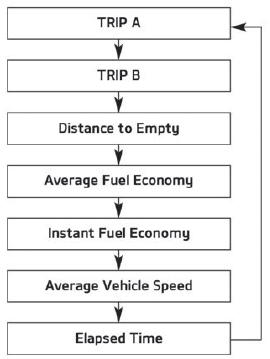
To change the trip mode, scroll the MOVE scroll switch ( / ) or TRIP button in the trip computer mode.
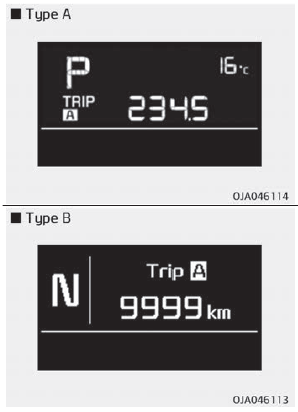
- The tripmeter is the total driving distance since the last tripmeter reset. - Distance range : 0 ~ 9999.9 km (mi)
- To reset the tripmeter, press the RESET button or OK button on the steering wheel for more than 1 second when the tripmeter is displayed.
Elapsed Time
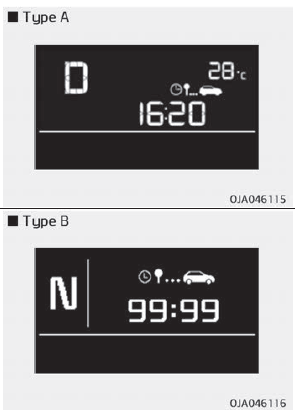
- The elapsed time is the total driving time since the last elapsed time reset. - Time range (hh:mm) : 00:00 ~ 99:59
- To reset the elapsed time, press the RESET button or OK button on the steering wheel for more than 1 second when the elapsed time is displayed.
Even if the vehicle is not in motion, the elapsed time keeps going while the engine is running.
Average Vehicle Speed
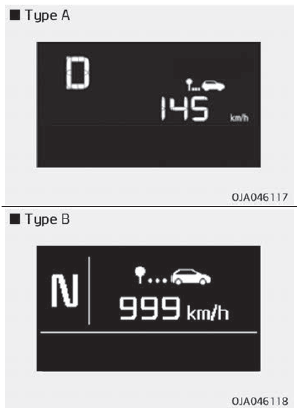
- The average vehicle speed is calculated by the total driving distance and driving time since the last average vehicle speed reset. - Speed range : 0 ~ 999 km/h or mph
- To reset the average vehicle speed, press the RESET button or OK button on the steering wheel for more than 1 second when the average vehicle speed is displayed.
- The average vehicle speed is not displayed if the driving distance is less than 300 meters or the driving time is less than 10 seconds since the ignition switch is turned to ON.
- Even if the vehicle is not in motion, the average vehicle speed keeps going while the engine is running.
Fuel economy
Distance To Empty
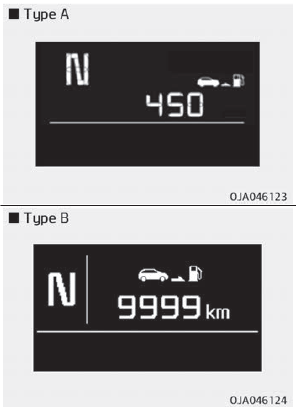
- The distance to empty is the estimated distance the vehicle can be driven with the remaining fuel. - Distance range: 1~9,999 km or 1~9,999 mi.
- If the estimated distance is below 1 km (1 mi.), the trip computer will display “---” as distance to empty.
- If the vehicle is not on level ground or the battery power has been interrupted, the distance to empty function may not operate correctly.
- The distance to empty may differ from the actual driving distance as it is an estimate of the available driving distance.
- The trip computer may not register additional fuel if less than 6 liters (1.6 gallons) of fuel are added to the vehicle.
- The fuel economy and distance to empty may vary significantly based on driving conditions, driving habits, and condition of the vehicle.
Average Fuel Economy
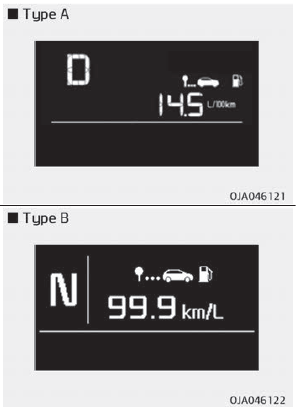
- The average fuel economy is calculated by the total driving distance and fuel consumption since the last average fuel economy reset. - Fuel economy range: 0 ~ 99.9km/L, L/100 km or MPG
- The average fuel economy can be reset both manually and automatically.
Manual reset
To clear the average fuel economy manually, press the RESET button or OK button on the steering wheel for more than 1 second when the average fuel economy is displayed.
LCD windows
Automatic reset (for type b cluster), other information:, kia picanto ja 2017-2024 service & repair manual: fuel pump motor, kia picanto ja 2017-2024 service & repair manual: rear door latch.
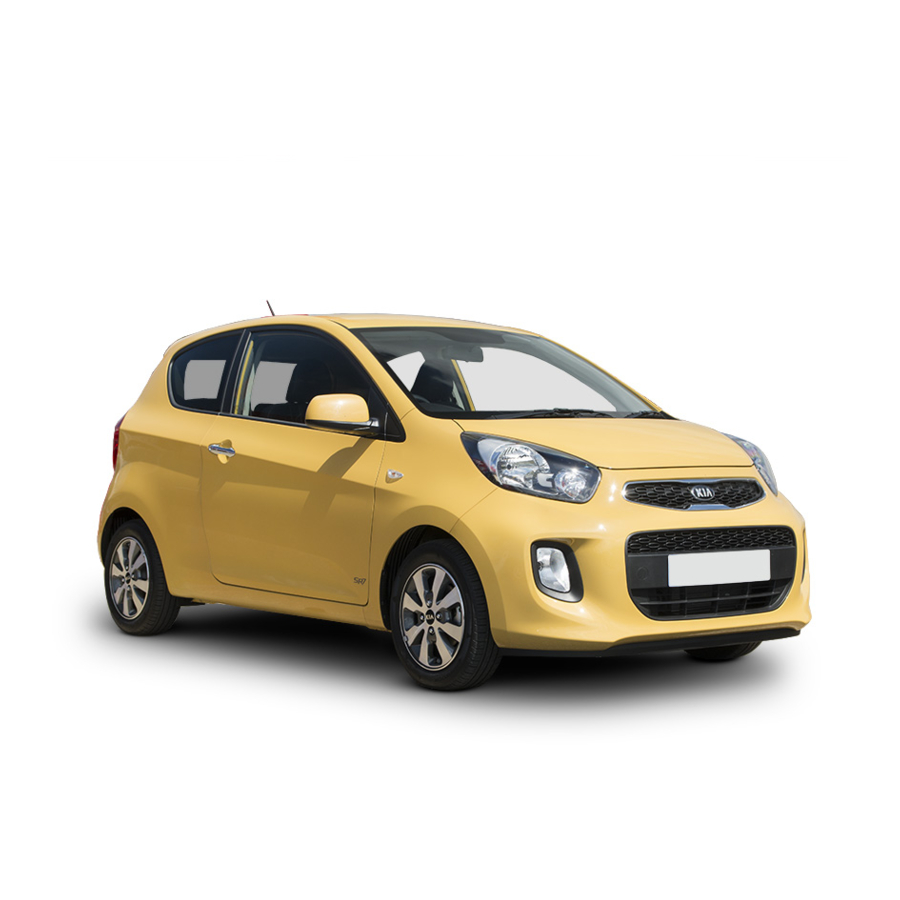
- Kia Manuals
- Picanto 2016
- Owner's manual
Kia Picanto 2016 Owner's Manual
- page of 489 Go / 489
Table of Contents
- How to Use the Manual
- Fuel Requirements
- Gasoline Containing Alcohol and Methanol
- Use of MTBE
- Vehicle Break-In Process
- Do Not Use Methanol
- Fuel Additives
- Vehicle Overview
- Interior Overview
- Instrument Panel Overview
- Engine Compartment
- Front Seat Adjustment - Manual
- Seat Cushion Height (for Driver’s Seat)
- Headrest Removal and Installation
- Active Headrest
- Seat Warmer
- Rear Seat Entry (for 3Door Vehicle Only)
- Passenger Seat under Tray
- Seatback Pocket
- Rear Seat Adjustments
- Folding the Rear Seat
- To Unfold the Rear Seat
- Seat Belt Restraint System
- Seat Belt Warning
- Rear Seat Belts
- Lap/Shoulder Belt
- Seat Belt Height Adjustment (Front Seat)
- To Release the Seat Belt
- Stowing the Rear Seat Belt
- Pre-Tensioner Seat Belt
- Seat Belt Precautions
- Infant or Small Child
- Larger Children
- Do Not Lie down
- One Person Per Belt
- Pregnant Women
- Care of Seat Belts
- When to Replace Seat Belts
- Child Restraint System
- Installing a Child Restraint System by Lap Belt
- Securing a Child Restraint Seat with “Tether Anchor” System
- To Secure the Child Restraint Seat
- Child Seat Restraint Suitability for Seat Position Using the Seat Belt
- Child Seat Restraint Suitability for Vehicle ISOFIX Positions
- Recommended Child Restraint Systems
- Air Bag - Supplemental Restraint System (SRS)
- Driver's Front Air Bag*
- Noise and Smoke (SRS)
- Passenger’s Front Air Bag off Indicator
- Air Bag Warning Light
- Passenger’s Front Air Bag on Indicator
- SRS Components and Functions
- Driver's and Passenger's Front Air Bag
- Passenger’s Front Air Bag ON/OFF Switch
- To Deactivate or Reactivate the Passenger’s Front Air Bag
- Side Air Bag
- Curtain Air Bag
- Air Bag Collision Sensors
- Air Bag Inflation Conditions
- Air Bag Non-Inflation Conditions
- Additional Safety Precautions (SRS)
- Air Bag Warning Label
- Record Your Key Number
- Immobilizer System
- To Activate the Immobilizer System
- To Deactivate the Immobilizer System
- Remote Keyless Entry
- Tailgate Unlock
- Battery Replacement (Transmitter)
- Transmitter Precautions
- Start-Up (Smart Key)
- Tailgate Unlocking (Smart Key)
- Smart Key Precautions
- Armed Stage
- Theft-Alarm System
- Theft-Alarm Stage
- Using the Transmitter (Theft-Alarm)
- Disarmed Stage (Theft Alarm)
- Operating Door Locks from Outside the Vehicle
- Operating Door Locks from Inside the Vehicle
- Central Door Lock Switch
- Child-Protector Rear Door Lock
- Impact Sensing Door Unlock System
- Speed Sensing Door Lock System
- Tail Gate Opening
- Closing the Tailgate
- Auto down Window (Driver’s Window)
- Power Windows
- Window Opening and Closing
- Auto Up/Down Window (Driver’s Window)
- Automatic Reversal (Window)
- Power Window Lock Button
- Manual Windows
- Closing the Hood
- Fuel Filler Lid Openign and Closing
- Automatic Reversal (Sunroof)
- Sliding the Sunroof
- To Close the Sunroof Automatically
- To Open the Sunroof Automatically
- Tilting the Sunroof
- Resetting the Sunroof
- Electronic Power Steering
- Steering Wheel
- Heated Steering Wheel
- Tilt Steering
- Day/Night Rearview Mirror
- Inside Rearview Mirror
- Outside Rearview Mirror
- Remote Control
- Folding the Outside Rearview Mirror
- Adjusting Instrument Cluster Illumination
- Instrument Cluster Control
- Speedometer
- Engine Coolant Temperature Gauge
- Outside Thermometer
- Icy Road Warning Light
- Transaxle Shift Indicator
- Manual Transaxle and Sport Mode Shift Indicator
- Trip Computer
- Average Fuel Consumption (L/100 Km or MPG)
- Distance to Empty
- Instant Fuel Consumption (L/100 Km or MPG)
- Elapsed Time
- ECO ON/OFF Mode
- LCD Display Warning
- Low Key Battery
- Press Brake Pedal to Start Engine (for Automatic Transaxle)
- Press Clutch Pedal to Start Engine (for Manual Transaxle)
- Press START Button Again
- Shift to P (for Automatic Transaxle)
- Shift to P or N to Start Engine (for Automatic Transaxle)
- Check Steering Wheel Lock System
- Press START Button While Turning Wheel
- Steering Wheel Unlocked
- Check Brake Switch Fuse Indicator
- Door / Tailgate Open Indicator
- Rear Parking Assist Warning Indicator
- Align Steering Wheel Complete Indicator
- Align Steering Wheel Indicator
- ECO Indicator
- Low Tire Pressure Indicator
- Warnings and Indicators
- Anti-Lock Brake System (ABS) Warning Light
- Electronic Brake Force Distribution (EBD) System Warning Light
- Parking Brake & Brake Fluid Warning Light
- Front Fog Light Indicator
- High Beam Indicator
- Seat Belt Warning and Chime
- Turn Signal Indicator
- Charging System Warning Light
- Engine Oil Pressure Warning Light
- Door Ajar Warning Light
- Immobilizer Indicator
- Tailgate Open Warning Light
- Gasoline Fuel Indicator
- Low Fuel Level Warning Light
- Malfunction Indicator Light (MIL)
- Engine Coolant Temperature Warning Light
- ESC Indicator (Electronic Stability Control)
- ESC off Indicator
- Cruise Indicator
- Cruise SET Indicator
- Electric Power Steering (EPS) System Warning Light
- Speed Limit Indicator Light
- Auto Stop Indicator
- Low Tire Pressure Indicator/Tpms Malfunction Indicator
- Key out Indicator
- Key Reminder Warning Chime
- Overspeed Warning Light
- Rear Parking Assist System
- Non-Operational Conditions of Rear Parking Assist System
- Rear Parking Assist System Precautions
- Self-Diagnosis
- Hazard Warning Flasher
- Battery Saver Function
- Headlight Escort Function
- Headlight Welcome Function
- Daytime Running Light
- Lighting Control
- Parking Light Position
- Auto Light Position
- Headlight Position
- Flashing Headlights
- High Beam Operation
- One-Touch Triple Turn Signal
- Turn Signals and Lane Change Signals
- Front Fog Light
- Rear Fog Light
- Headlight Leveling Device
- Windscreen Wiper/Washer
- Wipers and Washers
- Rear Window Wiper/Washer
- Windshield Wipers
- Windshield Washers
- Rear Window Wiper and Washer Switch
- Automatic Turn off Function
- Interior Light
- Glove Box Lamp
- Luggage Room Lamp
- Outside Rearview Mirror Defroster
- Rear Window Defroster
- Manual Climate Control System
- Heating and Air Conditioning
- Mode Selection
- Air Intake Control
- Instrument Panel Vents
- Temperature Control
- Outside (Fresh) Air Position
- Recirculated Air Position
- Air Conditioning (A/C)
- Fan Speed Control
- Ventilation
- Air Conditioning
- Climate Control Air Filter
- Check Amount of Air Conditioner Refrigerant and Compressor Lubricant
- Automatic Climate Control System
- Automatic Heating and Air Conditioning
- Manual Heating and Air Conditioning
- Mode Selection (A/C)
- Defrost-Level
- Instrument Panel Vents Operation
- Windshield Defrosting and Defogging
- Automatic Climate Control System - Defogging and Defrosting
- Defogging Logic
- Storage Compartments
- Sunglass Holder
- Cigarette Lighter
- Interior Features
- Power Outlet
- Vanity Mirror Lamp
- Digital Clock
- Setup the Clock
- Clothes Hanger
- Floor Mat Anchor(S)
- Audio System
- Roof Antenna
- Steering Wheel Audio Control
- Aux, USB and Ipod Port
- AM (MW, LW) Reception
- FM Radio Station
- FM Reception
- Using a Cellular Phone or a Two-Way Radio
- Caring for Discs
- Order of Playing Files (Folders)
- Using the USB Device
- Using the Ipod Device
- Using Radio, Setup, Volume and Audio Control
- Using USB Device
- CD Player System Controllers and Functions
- Sound Settings
- Mode Pop up
- Display Settings (Audio)
- Audio Settings
- Speed Dependent Volume Control
- Clock Settings
- Day/Calendar Settings
- Time Format
- Automatic RDS Time
- Clock Display When Power Is off
- Phone Setup (Bluetooth Wireless Technology Equipped Model)
- Disconnecting a Connected Phone
- Connecting a Phone
- Changing Connection Sequence (Priority)
- Phone Book Download
- Auto Download
- Audio Streaming
- Outgoing Volume
- Bluetooth Wireless Technology System
- Memory Information
- Display Settings
- Media Display
- Calendar Settings
- Contacts Download
- Using the Bluetooth Wireless Technology System
- Phone Setup (Bluetooth)
- RADIO (for RDS Model)
- Preset SEEK
- Changing RADIO Mode
- Selecting through Manual Search
- Traffic Announcement (TA)
- AST (Auto Store)
- AF (Alternative Frequency)
- Basic Method of Use: Audio CD / MP3 CD / USB / Ipod / My Music
- Changing Song/File
- Scan (for RDS Model)
- Folder Search: MP3 CD, USB Mode
- MENU: Audio CD
- Searching Songs (File)
- Menu: Mp3 CD / Usb
- Folder Repeat
- Folder Random
- MENU: My Music Mode
- Bluetooth Wireless Technology Audio
- Phone (Bluetooth)
- Making a Call Using the Steering-Wheel Mount Controls
- Bluetooth Wireless Technology Cellular Phone
- Using Voice Command
- Starting Voice Command
- Skipping the Guidance Message
- Ending Voice Command
- Voice Command List
- FM/AM Radio Commands
- Audio CD Commands
- MP3 CD / USB Commands
- Ipod Commands
- My Music Commands
- Commands Available During Bluetooth Streaming
- Declaration of Conformity
Advertisement
Quick Links
- 1 Features of Your Vehicle
- 2 Maintenance
- 3 Specifications & Consumer Information
- Download this manual
Related Manuals for Kia Picanto 2016

Summary of Contents for Kia Picanto 2016
- Page 1 Kia Motors is dedicated to providing you with a customer service experience that exceeds your expectations. At all of our Kia dealerships you will be treated with warmth, hospitality and professionalism by people who care based on our “Family-like Care”...
- Page 2 Thank you for choosing a Kia vehicle. The information and specifications provided in this man- ual were accurate at the time of printing. Kia reserves the When you require service, remember that your dealer right to discontinue or change specifications or design at knows your vehicle best.
Page 3: Table Of Contents
- Page 4 Introduction How to use this manual / 1-2 Fuel requirements / 1-3 Vehicle break-in process / 1-5...
Page 5: Introduction
- Page 6 Kia dealer for details.) reduction of the vehicle. Except Europe WARNING Your new Kia vehicle is designed to use • Do not "top off" after the nozzle only unleaded fuel having an Octane automatically shuts off when Rating of RON (Research Octane refueling.
- Page 7 Gasoline containing alcohol and Other fuels Use of MTBE methanol Using fuels such as ; Kia recommends avoiding fuels contain- Gasohol, a mixture of gasoline and ing MTBE (Methyl Tertiary Butyl Ether) - Silicone (Si) contained fuel, ethanol (also known as grain alcohol), over 15.0% vol.
- Page 8 No special break-in period is needed. By following a few simple precautions for the Fuels containing methanol (wood alco- Kia recommends that you use unleaded first 1,000 km (600 miles) you may add to hol) should not be used in your vehicle.
Page 9: Your Vehicle At A Glance
- Page 10 Your vehicle at a glance INTERIOR OVERVIEW 1. Door lock/unlock button ....4-16 2. Central door lock switch* ....4-17 3. Power window switches*....4-21 4. Power window lock button* ....4-24 5. Outside rearview mirror control switch*..........4-40 6. Outside rearview mirror folding switch*..........4-41 7.
Page 11: Table Of Contents
- Page 12 Your vehicle at a glance ENGINE COMPARTMENT 1.25 Gasoline 1.0 LPG ■ ■ ■ ■ 1. Engine coolant reservoir .........7-27 1.0 Gasoline ■ ■ 2. Radiator cap............7-28 3. Brake fluid reservoir ..........7-29 4. Air cleaner ...............7-33 5. Engine oil dipstick ...........7-24 6.
- Page 13 Seats / 3-2 Seat belts / 3-17 Child restraint system / 3-30 Air bag - supplemental restraint system / 3-41 Safety features of your vehicle...
Page 14: Safety Features Of Your Vehicle
Page 15: features of your vehicle.
- Page 16 Safety features of your vehicle (Continued) WARNING WARNING - Rear seatbacks • To avoid the possibility of burns, • The rear seatback must be • Use extreme caution so that do not remove the carpet in the securely latched. If not, passen- hands or other objects are not cargo area.
- Page 17 Safety features of your vehicle OTA030002L OTA030003L OTA030004L Front seat adjustment - manual Seatback angle Seat cushion height (for driver’s seat) (if equipped) To recline the seatback: Forward and rearward To change the height of the seat cushion, 1. Lean forward slightly and lift up on the To move the seat forward or rearward: push the lever that is located on the out- seatback recline lever.
- Page 18 Safety features of your vehicle WARNING • For maximum effectiveness in case of an accident, the headrest should be adjusted so the middle of the headrest is at the same height as the center of gravity of an occupant's head. Generally, the center of gravity of most peo- ple's head is similar with the height of the top of their eyes.
- Page 19 Safety features of your vehicle OYFH034205 OTA034053 OTA034054 Removal and installation To reinstall the headrest : 1. Put the headrest poles (2) into the holes CAUTION To remove the headrest: while pressing the release button (1). 1. Recline the seatback (2) with the If you recline the seatback towards 2.
- Page 20 Safety features of your vehicle • Each time you press the button, the temperature setting of the seat will change as follows : OFF → HIGH( ) → LOW( • The seat warmer defaults to the OFF position whenever the ignition switch is turned on.
- Page 21 Safety features of your vehicle CAUTION WARNING - Seat warmer • When cleaning the seats, do not burns use an organic solvent such as Passengers should use extreme paint thinner, benzene, alcohol caution when using seat warmers and gasoline. Doing so may dam- due to the possibility of excess heat- age the surface of the heater or ing or burns.
- Page 22 Safety features of your vehicle WARNING Never attempt to adjust the seat while the vehicle is moving or when the passenger's seat is occupied as the seat may suddenly move and injure the passenger. OTA030009 OTA030010 Seatback pocket (if equipped) Passenger seat under tray (if equipped) The seatback pocket is provided on the...
- Page 23 Safety features of your vehicle WARNING WARNING • Since stored items may move • For maximum effectiveness in while driving, be sure to position case of an accident, the headrest them in the tray so that they do should be adjusted so the middle not make noise or cause a poten- of the headrest is at the same tial safety hazard when the vehi-...
- Page 24 Safety features of your vehicle Folding the rear seat (if equipped) The rear seatbacks (or cushions) may be folded to facilitate carrying long items or to increase the luggage capacity of the vehicle. WARNING The purpose of the fold-down rear seatbacks (or cushions) is to allow you carry longer objects that could not be accommodated in the cargo...
- Page 25 Safety features of your vehicle To fold the rear seat cushion and seat back: CAUTION The rear seatbacks may be folded for- • When folding or unfolding the rear ward to provide additional cargo space seat, make sure to move the front and to provide access to the cargo area.
- Page 26 Safety features of your vehicle Type A Type A Type A ■ ■ ■ OSA037009 OSA037010 OSA037011 Type B Type B Type B ■ ■ ■ OSA037036 OSA037037 OSA037038 3. Lift up the front part of the seat cush- 4. Lift up the rear part of the seat cushion 5.
- Page 27 Safety features of your vehicle Type A Type A ■ ■ WARNING After folding the rear seat, unless the driver’s position is properly set according to the driver’s physical figure, do not fold the rear seat. It may increase body injuries in a sudden stop or collision.
- Page 28 Safety features of your vehicle To unfold the rear seat: CAUTION - Damaging rear WARNING - Cargo 1. Lift and push the seatback backward seat belt buckles firmly until it clicks into place. Cargo should always be secured to When you fold the rear seatback, prevent it from being thrown about 2.
- Page 29 Safety features of your vehicle SEAT BELTS Seat belt restraint system (Continued) (Continued) • Never wear a seat belt over frag- Seat belts should be adjusted as WARNING ile objects. If there is a sudden firmly as possible, consistent with stop or impact, the seat belt can comfort, to provide the protection •...
- Page 30 Safety features of your vehicle WARNING • No modifications or additions should be made by the user which will either prevent the seat belt adjusting devices from oper- ating to remove slack, or prevent the seat belt assembly from being adjusted to remove slack.
- Page 31 Safety features of your vehicle If you continue not to fasten the seat belt If the rear seat belt is disconnected when and you drive over 20km/h the seat belt you drive over the 20km/h, the correspon- warning chime will sound for approxi- ding seat belt warning light will blink and mately 100 seconds and the correspon- warning chime will sound for 35 seconds.
- Page 32 Safety features of your vehicle To raise the height adjuster, pull it up (1). Front seat To lower it, push it down (3) while press- ing the height adjuster button (2). Release the button to lock the anchor into position. Try sliding the height adjuster to make sure that it has locked into position.
- Page 33 Safety features of your vehicle ✽ ✽ NOTICE If you are not able to pull out the seat belt from the retractor, firmly pull the belt out and release it. Then you will be able to pull the belt out smoothly. B200A02NF OTA030049L When using the rear center seat belt, the...
- Page 34 Safety features of your vehicle Shorten Lengthen OEN036030 B210A01NF-1 OBH038067 Lap belt (if equipped) To release the seat belt: The seat belt is released by pressing the To fasten your seat belt: release button (1) on the locking buckle. To fasten a 2-point static type belt, insert Too high When it is released, the belt should auto- the metal tab (1) into the locking buckle...
- Page 35 Safety features of your vehicle OTA032025 B210A02NF-2 OTA030027 When using the rear center seat belt, the Stowing the rear seat belt To release the seat belt: buckle with the “CENTER” mark must be When you want to release the seat belt, The rear seat belt buckles can be stowed used.
- Page 36 Safety features of your vehicle When the vehicle stops suddenly, or if the occupant tries to lean forward too quickly, the seat belt retractor will lock into position. In certain collisions, the pre- tensioner will activate and pull the seat belt into tighter contact against the occu- pant's body.
- Page 37 • Although it is harmless, the fine dust always wear seat belts properly. authorized Kia dealer. may cause skin irritation and should not be breathed for prolonged periods. Wash all exposed skin areas thorough- ly after an accident in which the pre- tensioner seat belts were activated.
- Page 38 We recommend safety contained in this manual. authorized Kia dealer. that the system be inspected by an authorized Kia dealer. • Body work on the front area of the vehicle may damage the pre- tensioner seat belt system.
- Page 39 Safety features of your vehicle Infant or small child Larger children ✽ ✽ NOTICE You should be aware of the specific Children who are too large for child Small children are best protected from requirements in your country. Child restraint systems should always occupy injury in an accident when properly and/or infant seats must be properly the rear seat and use the available...
- Page 40 Safety features of your vehicle Pregnant women Injured person If the shoulder belt portion slightly touch- es the child’s neck or face, try placing the The use of a seat belt is recommended A seat belt should be used when an child closer to the center of the vehicle.
- Page 41 If the webbing This should be done even if no damage backs upright. or buckles are damaged, get them is visible. We recommend that you con- replaced immediately. sult an authorized Kia dealer. 3 29...
- Page 42 Safety features of your vehicle CHILD RESTRAINT SYSTEM Children riding in the car should sit in the (Continued) rear seat and must always be properly WARNING • Children may be seriously injured restrained to minimize the risk of injury in •...
- Page 43 • Never allow two children, or any that the system be checked by an tions for installation and use of two persons, to use the same authorized Kia dealer. the child restraint. seat belt. • If there is not enough space to •...
- Page 44 Forward-facing child restraint system restraint system manufacturer. • If the seat belt does not operate as described in this section, we recommend that the system be checked by an authorized Kia dealer. • Failure to observe this manual's instructions regarding...
- Page 45 Safety features of your vehicle E2MS103005 E2BLD310 MMSA3030 Installing a child restraint system by 2. Fasten the lap/shoulder belt latch into 3. Buckle the seat belt and allow the seat lap/shoulder belt the buckle. Listen for the distinct “click” belt to take up any slack. After installa- sound.
- Page 46 Safety features of your vehicle E2BLD347 OTA030028 OTA030016 Installing a child restraint system by Securing a child restraint seat with 1. Route the child restraint seat strap lap belt (on the center rear seat) “Tether Anchor” system over the seatback. (if equipped) - Except Europe (if equipped) For vehicles with adjustable headrest,...
- Page 47 Safety features of your vehicle WARNING WARNING Tether strap - Child restraint anchorage • A child can be seriously injured or killed in a collision if the child • Child restraint anchorages are restraint is not properly anchored designed to withstand only those to the car and the child is not loads imposed by correctly fitted properly restrained in the child...
- Page 48 Safety features of your vehicle Both rear outboard seats are equipped with a pair of ISOFIX anchorages as well WARNING as a corresponding top tether anchorage Install the child restraint seat fully on the back side of the back rest. The rearward against the seatback with ISOFIX anchorages are located between the seatback in a vertical position,...
- Page 49 Safety features of your vehicle To secure the child restraint seat (Continued) WARNING 1. To engage the child restraint seat to the • Attach the ISOFIX or ISOFIX-com- ISOFIX anchor, insert the child restraint • Do not install a child restraint seat patible child restraint seat only to seat latch into the ISOFIX anchor.
- Page 50 Safety features of your vehicle Child Seat Restraint Suitability For Seat Position using the Seat Belt WARNING - For Europe recommend that child Use child safety seats that have been officially approved and are appropriate for your restraint seat be installed in the children.
- Page 51 Safety features of your vehicle Child seat restraint suitability for vehicle ISOFIX positions - For Europe vehicle ISOFIX positions Mass Group Size Class Fixture Rear Outboard Rear Outboard Front Passenger Rear Center (Driver side) (Passenger side) ISO/L1 Carrycot ISO/L2 0 : UP to 10kg ISO/R1 ISO/R1 0+ : UP to 13kg...
- Page 52 Safety features of your vehicle Recommended child restraint systems – For Europe ECE-R44 Mass Group Name Manufacturer Type of Fixation Approval No. E4 03443416 (Seat) Rearward facing with vehicle Bimbo G0/1 S FAIR specific ISOFIX platform type “A” E4 0443718 (Platform) Group 0-1 (0-18kg) Baby-Safe Plus II...
Page 53: Driver's Front Air Bag*
- Page 54 Safety features of your vehicle How does the air bag system It is much more likely that you will sim- ply see the deflated air bags hanging WARNING operate out of their storage compartments after • To avoid severe personal injury •...
- Page 55 Safety features of your vehicle Noise and smoke In addition, do not place a front-facing ■ Type A child restraints in the front passenger’s When the air bags inflate, they make a seat. If the front passenger air bag loud noise and they leave smoke and powder in the air inside of the vehicle.
- Page 56 Safety features of your vehicle W7-147 OTA030044L OTA030045L Air bag warning light Passenger’s front air bag Passenger’s front air bag ON indicator (if equipped) OFF indicator (if equipped) The purpose of the air bag warning light in your instrument panel is to alert you of a potential problem with your air bag - The passenger's front air bag ON indica- The passenger’s front air bag OFF indi-...
- Page 57 11. Passenger’s front air bag ON/OFF system be inspected by an author- occurs, this indicates a malfunction switch* ized Kia dealer. of the SRS. We recommend that the 12. Passenger’s front air bag ON/OFF system be inspected by an author- indicator* ized Kia dealer.
- Page 58 Safety features of your vehicle Driver’s front air bag (1) Driver’s front air bag (2) Driver’s front air bag (3) OHM039102N OHM039103N OHM039104N The front air bag modules are located Upon deployment, tear seams molded A fully inflated air bag, in combination both in the center of the steering wheel, directly into the pad covers will separate with a properly worn seat belt, slows the...
- Page 59 If this occurs, we recom- instrument panel surface. mend that the system be inspect- It may become a dangerous pro- ed by an authorized Kia dealer. jectile and cause injury if the pas- (Continued) senger's air bag inflates. 3 47...
- Page 60 Safety features of your vehicle The indications of the system's presence Driver’s front air bag Passenger’s front air bag are the letters "AIR BAG" embossed on the air bag pad cover in the steering wheel and/or on the cover of the driver’s side knee bolster located below the steering wheel and the passenger's side front panel pad above the glove box.
- Page 61 (Continued) booster seat in the front seat. ed by an authorized Kia dealer. • ABC – Always Buckle Children in • Air bags can only be used once – the back seat. It is the safest place we recommend that the system for children of any age to ride.
- Page 62 Safety features of your vehicle (Continued) (Continued) (Continued) • The SRS is designed to deploy • Children age 12 and under must • Sitting improperly or out of posi- the front air bags only when an always be properly restrained in tion can result in serious or fatal impact is sufficiently severe and the rear seat.
- Page 63 Safety features of your vehicle WARNING The front air bag ON/OFF switch could turn by using a similar small rigid device. Always check the sta- tus of the front air bag ON/OFF switch and passenger's front air bag ON/OFF indicator. ✽...
- Page 64 OFF indicator ( ) will not illumi- function may occur in the SRS authorized Kia dealer. nate (The passenger's front air Control Module. bag ON indicator comes on and And there may be a danger that...
- Page 65 Safety features of your vehicle The side air bags are designed to deploy Front (Continued) only during certain side-impact collisions, • Even though your vehicle is depending on the crash severity, angle, equipped with the passenger's speed and point of impact. The side air front air bag ON/OFF switch, do bags are not designed to deploy in all not install a child restraint sys-...
- Page 66 Curtain air bag (if equipped) system be serviced by an author- • Do not use any accessory seat Curtain air bags are located along both ized Kia dealer. covers. sides of the roof rails above the center (Continued) pillar.
- Page 67 Make sure to authorized Kia dealer. position the child restraint sys- Failure to follow the above instruc- tem as far away from the door tions can result in injury or death to...
- Page 68 Safety features of your vehicle Why didn’t my air bag go off in a collision? (Inflation and non-infla- tion conditions of the air bag) There are many types of accidents in which the air bag would not be expect- ed to provide additional protection. These include rear impacts, second or third collisions in multiple impact accidents, as well as low speed...
- Page 69 We recommend that the result in serious personal injury system be serviced by an author- or death. ized Kia dealer. • If the installation location or • Your vehicle has been designed angle of the sensors is altered in...
- Page 70 Safety features of your vehicle Although the front air bags (driver’s and front passenger’s air bags) are designed to inflate only in frontal collisions, they also may inflate in other types of colli- sions if the front impact sensors detect a sufficient impact.
- Page 71 Safety features of your vehicle OPA037042 OSA038121 1VQA2089 • Frontal air bags are not designed to • Front air bags may not inflate in side • In an angled collision, the force of inflate in rear collisions, because occu- impact collisions, because occupants impact may direct the occupants in a pants are moved backward by the move to the direction of the collision,...
- Page 72 Safety features of your vehicle OPA037043 1VQA2091 OSA038122 • Just before impact, drivers often brake • Air bags does not inflate in most • Air bags may not inflate if the vehicle heavily. Such heavy braking lowers the rollover accidents (even if the vehicle is collides with objects such as utility front portion of the vehicle causing it to equipped with side air bags and cur-...
- Page 73 If the SRS air bag by an authorized Kia dealer. of any kind of badges to the pad warning light does not illuminate •...
- Page 74 Safety features of your vehicle Additional safety precautions • Keep occupants away from the air bag covers. All occupants should sit WARNING • Never let passengers ride in the upright, fully back in their seats with cargo area or on top of a folded-down •...
- Page 75 Safety features of your vehicle OTA030040L Air bag warning label (if equipped) Air bag warning labels are attached to alert the driver and passengers of poten- tial risk of air bag system. Note that these government warnings focus on the risk of children. We also want you to be aware of the risks which adults are exposed to.
- Page 76 Keys / 4-3 Remote keyless entry / 4-6 Smart key / 4-9 Theft-alarm system / 4-12 Door locks / 4-15 Tailgate / 4-19 Windows / 4-21 Hood / 4-26 Features of your vehicle Fuel filler lid / 4-28 Sunroof / 4-31 Steering wheel / 4-35 Mirrors / 4-38 Instrument cluster / 4-42...
- Page 77 Storage compartments / 4-110 Interior features / 4-112 Audio system / 4-119 Features of your vehicle...
- Page 78 Should you lose your keys, we recom- mend that you contact an authorized Kia dealer. Remove the key code tag and store it in a safe place. Also, record the key number and keep it in a safe and handy place, but not in the vehicle.
- Page 79 WARNING With the immobilizer system, whenever you insert your ignition key into the igni- Use only Kia original parts for the tion switch and turn it to ON, it checks ignition key in your vehicle. If an and determines and verifies if the ignition aftermarket key is used, the ignition key is valid or not.
- Page 80 We recommend engine from being started. that the system be serviced by an To deactivate the immobilizer sys- authorized Kia dealer. tem: Malfunctions caused by improper Insert the ignition key into the key cylin- ✽ ✽ NOTICE alterations, adjustments or modifi- der and turn it to the ON position.
- Page 81 Features of your vehicle REMOTE KEYLESS ENTRY (IF EQUIPPED) Lock (1) Tailgate unlock (3) (if equipped) Type A ■ All doors (and tailgate) are locked if the The tailgate is unlocked if the button is lock button is pressed while all doors are pressed for more than 1 second.
- Page 82 If the keyless entry OYDECO2006CN the transmitter, we recommend that you Type C system is inoperative due to ■ contact an authorized Kia dealer. changes modifications expressly approved by the party responsible for compliance, it will not be covered by your manufactur- er’s vehicle warranty.
- Page 83 Be sure to use For transmitter replacement, we recom- the correct battery. mend that you contact an authorized Kia dealer. • To avoid damaging the transmit- ter or smart key, don't drop it, get...
- Page 84 Features of your vehicle SMART KEY (IF EQUIPPED) Type A ■ WARNING If the battery of accessory smart key is totally discharged, it is impossible to enter the vehicle. In this case, you can enter the vehicle with a mechan- ical key.
- Page 85 Features of your vehicle Unlocking Tailgate unlocking Even though you press the outside door handle buttons, the doors will not lock Pressing the button of the front outside If you are within 0.7 m ~ 1 m (28 ~ 40 in.) and the chime will sound for 3 seconds if door handles with all doors (and tailgate) from the outside tailgate handle, with...
- Page 86 Avoid placing CAUTION you contact an authorized Kia dealer. the transmitter (or smart key) and Keep the smart key away from elec- • The smart key will not work if any of...
- Page 87 Features of your vehicle THEFT-ALARM SYSTEM (IF EQUIPPED) Armed stage Using the smart key Park the vehicle and stop the engine. Armed Arm the system as described below. stage 1. Turn off the engine. 2. Make sure that all doors (and tailgate) and the engine hood are closed and latched.
- Page 88 Features of your vehicle Using the transmitter Theft-alarm stage • Lock the doors by pressing the lock button on the smart key. Park the vehicle and stop the engine. The alarm will be activated if any of the After completion of the steps above, Arm the system as described below.
- Page 89 • If you lose your keys, we recommend - The engine is started. that you consult an authorized Kia dealer. After the doors are unlocked, the hazard warning lights will blink twice to indicate ✽...
- Page 90 Features of your vehicle DOOR LOCKS Transmitter/Smart key ✽ ✽ NOTICE • Doors can be locked and unlocked with • In cold and wet climates, door locks the transmitter (or smart key). (if and door mechanisms may not work equipped) properly due to freezing conditions.
- Page 91 Features of your vehicle • If the inner door handle of the front doors is pulled when the door lock but- ton is in lock position, the button is unlocked and door opens. (if equipped) • Front door cannot be locked if the igni- tion key is in the ignition switch and the door is open.
Page 92: Central Door Lock Switch*
- Page 93 Features of your vehicle Impact sensing door unlock sys- 3. Close the rear door. tem (if equipped) To open the rear door, pull the outside door handle. All doors will automatically unlock after Even though the doors may be unlocked, an impact causes the air bags to deploy.
Page 94: Driving Your Vehicle
- Page 95 Features of your vehicle WARNING Exhaust fumes If you drive with the tailgate open, you will draw dangerous exhaust fumes into your vehicle which can cause serious injury or death to vehicle occupants. If you must drive with the tailgate open, keep the air vents and all win- dows open so that additional out- side air comes into the vehicle.
- Page 96 Features of your vehicle WINDOWS (1) Driver’s door power window switch (2) Front passenger’s door power win- dow switch (3) Rear door (left) power window switch* (4) Rear door (right) power window switch* (5) Window opening and closing (6) Automatic power window up*/down* (Driver’s window) (7) Power window lock switch* * : if equipped...
- Page 97 Features of your vehicle Power windows (if equipped) The ignition switch must be in the ON position for power windows to operate. Each door has a power window switch that controls the door's window. The driver has a power window lock switch which can block the operation of passenger win- dows.
- Page 98 Features of your vehicle ✽ ✽ NOTICE The automatic reverse feature for the driver’s window is only active when the “auto up” feature is used by fully pulling up the switch. The automatic reverse feature will not operate if the window is raised using the halfway posi- tion on the power window switch.
Page 99: Power Window Lock Button*
- Page 100 Features of your vehicle OSA028222 Manual windows (if equipped) To raise or lower the window, turn the window regulator handle clockwise or counterclockwise. WARNING When opening or closing the win- dows, make sure your passenger's arms, hands and body are safely out of the way.
- Page 101 Features of your vehicle HOOD OTA040017 OTA045018K OTA040019 Opening the hood 2. Go to the front of the vehicle, raise the 3. Pull the support rod from the hood. hood slightly, pull the secondary latch 4. Hold the hood open with the support 1.
- Page 102 Features of your vehicle Closing the hood WARNING 1. Before closing the hood, check the fol- lowing: • Always double check to be sure that the hood is firmly latched • All filler caps in engine compartment before driving away. If it is not must be correctly installed.
- Page 103 Features of your vehicle FUEL FILLER LID Closing the fuel filler lid 1. To install the cap, turn it clockwise until it “clicks”. This indicates that the cap is securely tightened. 2. Close the fuel filler lid and push it light- ly and make sure that it is securely closed.
- Page 104 Features of your vehicle (Continued) (Continued) WARNING - Refueling dan- Use only approved portable plas- • Do not get back into a vehicle gers tic fuel containers designed to once you have begun refueling Automotive fuels are flammable carry and store gasoline. since you can generate static materials.
- Page 105 • If the fuel filler cap requires then contact the local fire depart- replacement, use only a genuine ment. Follow any safety instruc- Kia cap or the equivalent speci- tions they provide. fied for your vehicle. An incorrect fuel filler cap can result in a seri- ous malfunction of the fuel sys- tem or emission control system.
- Page 106 Features of your vehicle SUNROOF (IF EQUIPPED) ✽ ✽ NOTICE ✽ ✽ NOTICE • In cold and wet climates, the sunroof The sunroof cannot slide when it is in may not work properly due to freez- the tilt position nor can it be tilted while ing conditions.
- Page 107 Features of your vehicle To open the sunroof automatically: Pull the sunroof control lever backward to the second detent position and then release it. The sunroof will slide all the way open. To stop the sunroof sliding at any point, pull or push the sunroof control lever momentarily.
- Page 108 Features of your vehicle CAUTION WARNING • Periodically remove any dirt that • Never try pinching any part of may accumulate on the guide rail. your body intentionally to acti- • If you try to open the sunroof vate the Automatic reversal func- when the temperature is below tion.
- Page 109 Resetting the sunroof ❈ For more detailed information, we rec- ommend that you contact an author- Whenever the vehicle battery is discon- ized Kia dealer. nected or discharged, or related fuse is blown, you must reset your sunroof sys- tem as follows:...
Page 110: Steering Wheel
- Page 111 Features of your vehicle Tilt steering (if equipped) Tilt steering allows you to adjust the steering wheel before you drive. You can also raise it to give your legs more room when you exit and enter the vehicle. The steering wheel should be positioned so that it is comfortable for you to drive, while permitting you to see the instru- ment panel warning lights and gauges.
Page 112: Horn
- Page 113 Features of your vehicle MIRRORS Inside rearview mirror WARNING - Rear visibility Adjust the rearview mirror to center on Do not place objects in the rear the view through the rear window. Make seat or cargo area which would this adjustment before you start driving. interfere with your vision through Night the rear window.
- Page 114 Features of your vehicle Outside rearview mirror CAUTION WARNING - Rearview Be sure to adjust mirror angles before If the mirror is jammed with ice, do mirrors driving. not adjust the mirror by force. Use • The outside rearview mirror is Your vehicle is equipped with both left- an approved spray de-icer (not radi- convex.
- Page 115 Features of your vehicle CAUTION • The mirrors stop moving when they reach the maximum adjust- ing angles, but the motor contin- ues to operate while the switch is pressed. Do not press the switch longer than necessary, the motor may be damaged.
- Page 116 Features of your vehicle CAUTION The electric type outside rearview mirror operates even though the ignition switch is in the OFF posi- tion. However, to prevent unneces- sary battery discharge, do not adjust the mirrors longer than necessary while the engine is not running. CAUTION OTA040032 OTA040031...
Page 117: Instrument Cluster
- Page 118 Features of your vehicle Type B ■ ■ - For Gasoline engine 1. Tachometer 2. Speedometer 3. Engine coolant temperature gauge* 4. Gasoline fuel gauge 5. LPG fuel gauge* 6. Warning and indicator lights - For LPG engine 7. Turn signal indicators 8.
- Page 119 Features of your vehicle Instrument Cluster Control WARNING Never adjust the instrument cluster while driving. This could result in loss of control and lead to an acci- dent that may cause death, serious injury, or property damage. OTA042209L OTA045427L Adjusting Instrument Cluster The brightness of the instrument panel Illumination (if equipped) illumination is displayed (Type B Cluster).
- Page 120 Features of your vehicle Type A (km/h) Type A (MPH, km/h) ■ ■ OTA045504K OTA045517 Type B (km/h) Type B (MPH, km/h) ■ ■ OTA045506L Tachometer The tachometer indicates the approxi- mate number of engine revolutions per minute (rpm). Use the tachometer to select the correct shift points and to prevent lugging and/or over-revving the engine.
- Page 121 Features of your vehicle CAUTION If the gauge pointer moves beyond the normal range area toward the “130 or H” position, it indicates over- heating that may damage the engine. Do not continue driving with an overheated engine. If your vehicle overheats, refer to “If the Engine Overheats”...
Page 122: Maintenance
- Page 123 Features of your vehicle Type A Type A Type A ■ ■ ■ OTA045412L OTA045428 OTA045430 Type B Type B Type B ■ ■ ■ OTA045413L OTA045429 OTA045431 Icy road warning light (if equipped) Transaxle Shift Indicator Automatic Transaxle Shift Indicator in Sports Mode (if equipped, For Europe) This warning light illuminates when out- Automatic Transaxle Shift Indicator...
- Page 124 Features of your vehicle For example For example Type A ■ : Indicates that shifting up to the 3rd : Indicates that shifting up to the 3rd gear is desired (currently the shift gear is desired (currently the shift lever is in the 2nd or 1st gear). lever is in the 2nd or 1st gear).
- Page 125 Features of your vehicle Type A Type A ■ TRIP A ■ TRIP B Distance to empty* OTA045402 Type B ■ Average fuel consumption* OTA045541 Type B ■ Instant fuel consumption* OTA045403L Tripmeter (km or mi.) Elapsed time A : Tripmeter A B : Tripmeter B This mode indicates the distance of indi- Engine coolant temperature*...
- Page 126 Features of your vehicle Type A Type A Type A ■ ■ ■ OTA045404 OTA045542 OTA045543 Type B Type B Type B ■ ■ ■ OTA045405L OTA045407L OTA045409L Distance to empty (km or mi.) Average fuel consumption Instant fuel consumption (if equipped) (L/100 km or MPG) (if equipped) (L/100 km or MPG) (if equipped)
- Page 127 Features of your vehicle ✽ ✽ NOTICE Type A ■ You must drive more than 10 km/h (6 MPH) for this mode to calculate the instant fuel consumption. OTA045410 OTA045527RU Type B ■ OTA045411L OTA045527L Elapsed time Engine coolant temperature gauge (if equipped, for type B cluster) This mode indicates the total time trav- eled since the last driving time reset.
- Page 128 Features of your vehicle ✽ ✽ NOTICE Type A ■ WARNING • If the vehicle is not on level ground or Never remove the radiator cap the battery power has been interrupt- when the engine is hot. The engine ed, the “Distance to empty” function coolant is under pressure and may not operate correctly.
- Page 129 Features of your vehicle LCD display warning (if equipped, for Type B cluster) • For vehicle’s equipped with smart key system Key not in vehicle Key not detected Press START button with key OTA045449L OTA045447L OTA045453L If the smart key is not in the vehicle and If the smart key is not in the vehicle or is If you press the engine start/stop button if any door is opened or closed with the...
- Page 130 Features of your vehicle • For vehicle’s equipped with smart key system Low Key Battery Press brake pedal to start engine Press clutch pedal to start engine (for automatic transaxle) (for manual transaxle) OTA045435L OTA045443L OTA045445L If the engine start/stop button changes to the OFF position when the smart key in If the engine start/stop button changes to If the engine start/stop button turns to the...
- Page 131 10 seconds. (if equipped) If the warning illuminates each time you press the engine start/stop button, we recommend that you have the vehicle inspected by an authorized Kia dealer as soon as possible.
- Page 132 Features of your vehicle • For vehicle’s equipped with smart key system Press START button while turning Check Steering Wheel Lock System Steering wheel unlocked wheel OTA045528L OTA045538L OTA045537L If the steering wheel does not lock nor- If the steering wheel does not lock nor- If the steering wheel does not unlock nor- mally when the engine start/stop button mally when the ENGINE START/STOP...
- Page 133 Features of your vehicle Check BRAKE SWITCH fuse Door / Tailgate open Rear parking assist warning (if equipped) (if equipped) Door ■ OTA045469 Tailgate ■ OTA045455L OTA045493 When the brake switch fuse is discon- It displays the area an obstacle is detect- nected, the warning illuminates for 10 ed while moving rearward.
- Page 134 Features of your vehicle Align steering wheel Align steering wheel Align steering wheel complete (if equipped) (if equipped) (if equipped) OTA045465L OTA045467L OTA045463L If you start the engine when the steering If you start the engine when the steering If the steering wheel is aligned within 5 wheel is turned 90 degrees to the left wheel is turned 90 degrees to the right seconds after “Align steering wheel”...
- Page 135 RESET button. have the vehicle inspected by an author- As per ECO ON/OFF Mode operation, ized Kia dealer as soon as possible. refer to the previous page. • The fuel-efficiency can be changed by the driver's driving habit and road con- dition.
- Page 136 ON position or start- In this case, we recommend that you have ed the engine, or if it comes on while the vehicle inspected by an authorized Kia driving, we recommend that you have the dealer. The normal braking system will still...
- Page 137 & Brake Fluid Warning Lights are components for fluid leaks. an authorized Kia dealer as soon as on, the brake system will not work 3. Do not drive the vehicle if leaks are possible.
- Page 138 In this case, we recommend that you have the vehicle inspected by an authorized Kia dealer. 4 63...
- Page 139 If you have the vehicle inspected by an inspected by an authorized Kia dealer as the oil level is low, fill the engine oil authorized Kia dealer as soon as pos- soon as possible.
- Page 140 Tailgate is not closed securely. er key is inserted and turned to the ON Kia dealer as soon as possible. position to start the engine. • When the battery is weak, if the Door ajar warning light At this time, you can start the engine.
- Page 141 Refer to the LPG system in section 5. position, we recommend that you have by an authorized Kia dealer as soon the vehicle inspected by an authorized as possible. Kia dealer as soon as possible.
- Page 142 But, if the ESC system malfunctions the heating that may damage the engine. indicator illuminates and stays on. In this case, we recommend that you have the vehicle inspected by an authorized Kia dealer. 4 67...
- Page 143 Kia dealer. Cruise SET indicator The indicator illuminates when the cruise control switch (-SET or RES+) is pressed.
- Page 144 When the engine automatically starts by caused by external factors. ized Kia dealer as soon as possible. the ISG system, some warning lights • If you feel any vehicle instability, If the warning light illuminates while driv-...
- Page 145 Features of your vehicle KEY OUT indicator Key reminder warning chime Overspeed warning (if equipped) (if equipped) (if equipped) km/h When the ENGINE START/STOP button Without smart key system Overspeed warning light is in the ACC or ON position, if any door If the driver’s door is opened while the If you drive with the speed of 120 km/h or is open, the system checks for the smart...
- Page 146 Features of your vehicle REAR PARKING ASSIST SYSTEM (IF EQUIPPED) Operation of the rear parking WARNING assist system The rear parking assist system is a Operating condition supplementary function only. The • This system will activate when backing operation of the rear parking assist up with the ignition switch ON.
- Page 147 Features of your vehicle Non-operational conditions of Rear parking assist system pre- The detecting range may decrease when: rear parking assist system cautions 1. The sensor is stained with foreign mat- The rear parking assist system may • The rear parking assist system may ter such as snow or water.
- Page 148 If this occurs, we recommend that be detected by the sensors. the system be checked by an authorized Always visually check behind the vehi- Kia dealer. cle when backing up. Be sure to inform any drivers of the WARNING...
- Page 149 Features of your vehicle HAZARD WARNING FLASHER OTA040049 The hazard warning flasher should be used whenever you find it necessary to stop the car in a hazardous location. When you must make such an emer- gency stop, always pull off the road as far as possible.
- Page 150 Features of your vehicle LIGHTING Battery saver function Headlight escort function Headlight welcome function (if equipped) (if equipped) • The purpose of this feature is to pre- vent the battery from being dis- The headlights (and/or taillights) will When the headlight switch is in the ON or charged.
- Page 151 Features of your vehicle ■ Type A ■ Type A Daytime running light (if equipped) Daytime Running Lights (DRL) can make it easier for others to see the front of your vehicle during the day. DRL can be help- ful in many different driving conditions, and it is especially helpful after dawn and OTA040050E ORBC040047...
- Page 152 Features of your vehicle ■ Type A CAUTION • Never place anything over sensor (1) located on the instrument panel. This will ensure better auto-light system control. • Don’t clean the sensor using a window cleaner. The cleaner may ORBC040048 leave a light film which could ■...
- Page 153 Features of your vehicle ■ Type A ■ Type A WARNING Do not use high beam when there are other vehicles. Using high beam could obstruct the other driver's vision. ORBC040049 ORBC040050 ■ Type B ■ Type B ORB040049E ORB040050E High beam operation Flashing headlights To turn on the high beam headlights, push...
- Page 154 Features of your vehicle One-touch triple turn signal They will self-cancel after a turn is com- Type A ■ pleted. If the indicator continues to flash (if equipped) after a turn, manually return the lever to To activate an one-touch lane change the OFF position.
- Page 155 Features of your vehicle ■ Type A ■ Type C CAUTION When in operation, the fog lights consume large amounts of vehicle electrical power. Only use the fog lights when visibility is poor or unnecessary battery and generator drain could occur. ✽...
- Page 156 Features of your vehicle To turn off the rear fog lights, turn the switch to OFF (without ■ Type A ■ Type C Auto light) ✽ ✽ NOTICE To turn on the rear fog light switch, the ignition switch must be in the ON position.
Page 157: Headlight Leveling Device*
Page 158: wiper/washer.
- Page 159 Features of your vehicle Windshield wipers D : Rear wiper/washer control Rear window wiper/washer (if equipped) (if equipped) Operates as follows when the ignition · – Wash with brief wipes switch is turned ON. Type C ■ MIST ( ) : For a single wiping cycle, ·...
- Page 160 Features of your vehicle Type A Type C ■ ■ CAUTION To prevent possible damage to the washer pump, do not operate the washer when the fluid reservoir is empty. WARNING Do not use the washer in freezing ORBC040056E OTA040056 temperatures without first warming Type B Type D...
- Page 161 Features of your vehicle Type C ■ - Spraying washer fluid and wiping CAUTION - Normal wiper operation • To prevent possible damage to the wipers or windshield, do not OFF (O) - Wiper is not in operation operate the wipers when the windshield is dry.
- Page 162 Features of your vehicle INTERIOR LIGHT Automatic turn off function CAUTION (if equipped) Do not use the interior lights for The interior lights automatically turn off extended periods when the engine approximately 20 minutes after the igni- is not running. tion switch is turned off.
- Page 163 Features of your vehicle The map lamp goes out gradu- However, if a door is opened with ally after approximately 30 sec- the ignition switch in the ON posi- onds if the door is closed. tion, the room lamp stays on con- However, if the ignition switch is tinuously.
- Page 164 Features of your vehicle OTA043260 OTA040059 Glove box lamp Luggage room lamp (if equipped) The glove box lamp comes on when the The luggage room lamp comes on when glove box is opened. the tailgate is opened. CAUTION CAUTION The luggage room lamp stays on as To prevent unnecessary drain of long as the tailgate is opened.
- Page 165 Features of your vehicle DEFROSTER Outside rearview mirror defroster Type A ■ CAUTION (if equipped) To prevent damage to the conduc- If your vehicle is equipped with the out- tors bonded to the inside surface of side rearview mirror defrosters, they will the rear window, never use sharp operate at the same time you turn on the instruments or window cleaners...
- Page 166 Features of your vehicle MANUAL CLIMATE CONTROL SYSTEM (IF EQUIPPED) ■ ■ Type A 1. Mode selection knob 2. Air intake control knob 3. Fan speed control knob 4. Temperature control knob 5. Air conditioning button (if equipped) 6. Rear window defroster button ■...
- Page 167 Features of your vehicle Heating and air conditioning 1. Start the engine. 2. Set the mode to the desired position. For improving the effectiveness of heating and cooling; - Heating: - Cooling: 3. Set the temperature control to the desired position. 4.
- Page 168 Features of your vehicle Face-Level (B, D) Floor/Defrost-Level (A, C, D) Most of the air flow is directed to the floor Air flow is directed toward the upper body and the windshield with a small amount and face. Additionally, each outlet can be directed to the side window defrosters.
- Page 169 Features of your vehicle OTA040064 OTA040065 OTA040066 Temperature control Air intake control Instrument panel vents You can adjust the direction of air deliv- The temperature control knob allows you The air intake control is used to select ery from these vents using the vent con- to control the temperature of the air flow- the outside (fresh) air position or recircu- trol lever as shown.
- Page 170 Features of your vehicle Recirculated air position ✽ ✽ NOTICE WARNING With the recirculated air Prolonged operation of the heater in the position selected, air from • Continue using the climate con- recirculated air position (without air the passenger compart- trol system in the recirculated air conditioning selected) may cause fogging ment will be drawn through...
- Page 171 Features of your vehicle System operation Ventilation 1. Set the mode to the position. 2. Set the air intake control to the outside (fresh) air position. 3. Set the temperature control to the desired position. 4. Set the fan speed control to the desired speed.
- Page 172 Air conditioning Operation Tips ✽ ✽ NOTICE • To keep dust or unpleasant fumes from Kia Air Conditioning Systems are filled • When using the air conditioning sys- entering the vehicle through the venti- with environmentally friendly R-134a tem, monitor the temperature gauge lation system, temporarily set the air refrigerant.
- Page 173 (fresh) air position is selected. If this hap- pens, we recommend that the climate control air filter be replaced by an author- ized Kia dealer.
- Page 174 Therefore, if abnormal operation is • When the air flow rate suddenly found, we recommend that the system be decreases, we recommend that the inspected by an authorized Kia dealer. system be checked by an authorized Kia dealer. ✽ ✽ NOTICE It is important that the correct type and amount of oil and refrigerant is used.
- Page 175 Features of your vehicle AUTOMATIC CLIMATE CONTROL SYSTEM (IF EQUIPPED) Type A ■ ■ 1. Temperature control knob 2. AUTO (automatic control) button 3. OFF button 4. Climate control display 5. Fan speed control knob 6. Air conditioning button (if equipped) 7.
- Page 176 Features of your vehicle ✽ ✽ NOTICE • To turn the automatic operation off, select any button or switch of the fol- lowing: - Mode selection button - Air conditioning button - Front windshield defroster button (Press the button one more time to deselect the front windshield defroster function.
- Page 177 Features of your vehicle Manual heating and air condition- The heating and cooling system can be controlled manually by pushing buttons other than the AUTO button. In this case, the system works sequentially according to the order of buttons selected. When pressing any button (or turning any knob) except the AUTO button while using automatic operation, the functions...
- Page 178 Features of your vehicle Floor & Defrost (A, C, D) Most of the air flow is directed to the floor and the windshield with a small amount directed to the side window defrosters. Face-Level (B, D) Air flow is directed toward the upper body and face.
- Page 179 Features of your vehicle Temperature conversion You can switch the temperature mode between Centigrade to Fahrenheit as fol- lows: While pressing the OFF button, press the AUTO button for 4 seconds or more. The display will change from Centigrade to Fahrenheit, or from Fahrenheit to Centigrade.
- Page 180 Features of your vehicle Recirculated air position WARNING With the recirculated air position selected, air from • Continued climate control system the passenger compart- operation in the recirculated air ment will be drawn through position may allow humidity to the heating system and increase inside the vehicle which heated or cooled according may fog the glass and obscure...
- Page 181 Features of your vehicle OTA040077 OTA040078 Air conditioning (A/C) OFF mode Press the OFF button to turn off the air Press the A/C button to turn the air con- climate control system. However, you can ditioning system on (indicator light on the still operate the mode and air intake but- display will illuminate).
- Page 182 Features of your vehicle WINDSHIELD DEFROSTING AND DEFOGGING • For maximum defrosting, set the tem- WARNING perature control to the extreme Windshield right/hot position and the fan speed heating control to the highest speed. Do not use the position • If warm air to the floor is desired while during cooling operation...
- Page 183 Features of your vehicle OTA040080 OTA040081 OTA040082 To defrost outside windshield Automatic climate control system To defrost outside windshield 1. Set the fan speed to the highest posi- 1. Set the fan speed to the highest To defog inside windshield tion.
- Page 184 Features of your vehicle Defogging logic If the battery has been discharged or dis- connected, it resets to the defog logic To reduce the probability of fogging up status. the inside of the windshield, the air intake or air conditioning are controlled auto- matically according to certain conditions such as position.
Page 185: Glove Box
- Page 186 Features of your vehicle WARNING • Do not keep objects except sun- glasses inside the sunglass hold- er. Such objects can be thrown from the holder in the event of a sudden stop or an accident, pos- sibly injuring the passengers in the vehicle.
Page 187: Cigarette Lighter*
- Page 188 Features of your vehicle Cup holder WARNING - Ashtray use • Do not use the vehicle’s ashtrays WARNING Hot liquids as waste receptacles. • Do not place uncovered cups of • Putting lit cigarettes or matches in hot liquid in the cup holder while an ashtray with other combustible the vehicle is in motion.
- Page 189 Features of your vehicle WARNING For your safety, do not obstruct your vision when using the sunvisor. OTA040094 ORBR040085 To use the cup holder space as a storage Sunvisor compartment, turn the half part of the cup Use the sunvisor to shield direct light holder (2) to the direction of the arrow.
Page 190: Power Outlet*
- Page 191 Features of your vehicle Digital clock ■ Type A (Continued) Whenever the battery terminals or relat- • Make sure that the electric ed fuses are disconnected, you must devices are plugged in securely. If reset the time. not, it could cause a malfunction When the ignition switch is in the ACC or of electric systems.
- Page 192 Features of your vehicle With audio on Type C ■ 1. Press the [SETUP] / [CLOCK] button until the clock adjust mode displayed. 2. Set the clock by turning the knob(1) and press it. WARNING Do not adjust the clock while driv- ing.
- Page 193 To avoid any interference with pedal operation, Kia recommends that only the Kia floor mat designed for use in your vehicle be installed.
- Page 194 Features of your vehicle AUDIO SYSTEM ✽ ✽ NOTICE Type A ■ CAUTION If you install an aftermarket HID head • Before entering a place with a low lamp, your vehicle’s audio and electron- height clearance or a car wash, ic device may malfunction.
Page 195: Steering Wheel Audio Control*
- Page 196 Features of your vehicle MUTE ( ) (4, if equipped) SEEK/PRESET ( ) (3) • Press the button to mute the sound. The SEEK/PRESET lever has different functions based on the system mode. For • Press the button to turn off the micro- the following functions the lever should phone during a telephone call.
- Page 197 Features of your vehicle FM reception AM(MW, LW) reception FM radio station JBM001 JBM002 JBM003 How car audio works AM (MW, LW) broadcasts can be FM broadcasts are transmitted at high received at greater distances than FM frequencies and do not bend to follow the AM (MW, LW) and FM radio signals are broadcasts.
- Page 198 Features of your vehicle Using a cellular phone or a two-way radio When a cellular phone is used inside the vehicle, noise may be produced from the audio equipment. This does not mean that something is wrong with the audio equipment.
- Page 199 Features of your vehicle CARING FOR DISC ✽ ✽ NOTICE - Playing an Incompatible Copy • If the temperature inside the car is too Protected Audio CD high, open the car windows to ventilate before using the system. Some copy protected CDs, which do not •...
- Page 200 Features of your vehicle NOTE: Order of playing files (folders) : 1. Song playing order : sequentially. 2. Folder playing order : ❋ If no song file is contained in the folder, that folder is not displayed.
- Page 201 Features of your vehicle (Continued) WARNING • Do not touch the antenna during • Do not stare at the screen while thunder or lightening as such driving. Staring at the screen for acts lead lightning prolonged periods of time could induced electric shock.
- Page 202 Features of your vehicle (Continued) (Continued) CAUTION • Turn on the car ignition before • Do not place beverages close to • Operating the device while driv- using this device. Do not operate the audio system. Spilling bever- ing could lead to accidents due to the audio system for long periods ages may lead to system mal- a lack of attention to external sur-...
- Page 203 Features of your vehicle ✽ ✽ NOTICE (Continued) (Continued) - USING THE USB • Depending on the condition of the • If you disconnect the external USB DEVICE external USB device, the connected device during playback in USB mode, • To use an external USB device, make external USB device can be unrecog- the external USB device can be dam- sure the device is not connected when...
- Page 204 Features of your vehicle (Continued) (Continued) • If you use devices such as a USB hub • Some USB flash memory readers purchased separately, the vehicle’s (such as CF, SD, micro SD, etc.) or audio system may not recognize the external-HDD type devices can be USB device.
- Page 205 Features of your vehicle ® ✽ ✽ NOTICE - (Continued) (Continued) USING THE iPod • Some iPod ® devices, such as the • When connecting iPod ® with the DEVICE iPhone, can be connected through the iPod ® Power Cable, insert the connec- •...
Page 206: Audio*
- Page 207 Features of your vehicle SEEK Button Button TRACK Pressing the button selects the SEEK • When button TRACK AM band. AM Mode is displayed on the pressed, it increases the band fre- LCD. quency to automatically select chan- nel. Stops at the previous frequency if POWER VOLUME Button &...
- Page 208 Features of your vehicle - BASS Control : To increase the BASS, TUNE Knob rotate the knob clockwise, while to Turn this control while listening to a radio decrease the BASS, rotate the knob channel to manually adjust frequency. counterclockwise. Turn clockwise to increase frequency - TREBLE Control : To increase the TRE- and counterclockwise to decrease fre-...
- Page 209 Features of your vehicle (Continued) (Continued) CAUTION IN USING • An encrypted MP3 PLAYER is not • If you disconnect the external USB DEVICE recognizable. USB device during playback in • To use an external USB device, USB mode, the external USB •...
- Page 210 Features of your vehicle (Continued) (Continued) • If the USB device is divided by • Please avoid using USB memory logical drives, only the music files products which can be used as on the highest-priority drive are key chains or cellular phone recognized by car audio.
- Page 211 Features of your vehicle Button (REPEAT) Press this button for less than 0.8 sec- onds to activate ‘RPT’ mode and more than 0.8 seconds to activate ‘FLD.RPT’ mode. • RPT : Only a file is repeatedly played back. • ‘FLD.RPT’ : All files in a folder are repeatedly played back.
- Page 212 Features of your vehicle MENU Button Displays menus for the current mode. • RPT : Repeats the current song. • F.RDM : Plays all song within current Folder in random order. • F.RPT : Repeats all song within current Folder. •...
- Page 213 Features of your vehicle ✽ ✽ NOTICE - (Continued) USING THE iPod ® ® iPod • When connecting with the DEVICE ® iPod Power Cable, insert the connec- ® • Some iPod models may not sup- tor to the multimedia socket complete- port communication protocol and ly.
- Page 214 Features of your vehicle • Search : Moves to the upper category Button (RAPEAT) from currently played category of the ® iPod . To move to (play) the category Repeats the song currently played. (song) displayed, press knob. TUNE Button (RANDOM) You will be able to search through the lower category of the selected category.
- Page 215 Features of your vehicle CD Player ■ ■ Type A-1 Type A-2 ■ ■ ■ ■ ® (equipped with Bluetooth Wireless Technology)
- Page 216 Features of your vehicle SYSTEM CONTROLLERS AND (6) PWR/VOL kob MEDIA FUNCTIONS Power Knob: Turns power On/Off by Changes to CD, USB(iPod ® ), AUX, My pressing the knob ❈ Display and settings may differ Music, BT Audio mode. Volume Knob: Sets volume by turning depending on the selected audio.
- Page 217 Features of your vehicle (11) MENU SCAN Displays menus current Radio Mode mode. - Shortly press the key (under 0.8 sec- ❈ iPod List : Move to parent category ® onds): TA On/Off - Press and hold the key (over 0.8 sec- (12) FOLDER onds): Previews each broadcast for 5...
- Page 218 Features of your vehicle Audio Head Unit (for Type A-2) (18) (Preset) (16) MEDIA ® Radio Mode: Saves frequencies (chan- Changes to CD, USB(iPod ), AUX mode. nels) or receives saved frequencies Each time the key is pressed, the mode (channels) ®...
- Page 219 Features of your vehicle (20) TUNE knob Radio mode : Changes frequency by turning the knob left/right ® CD, USB, iPod mode: Searches songs (files) by turning the knob left/right. ❈ When the desired song is displayed, press the knob to play the song. Moves focus in all selection menus and selects menus (19)
- Page 220 Features of your vehicle CD Player ■ ■ Type A-3 ■ ■ Type A-4 ■ ■ ® (equipped with Bluetooth Wireless Technology)
- Page 221 Features of your vehicle SYSTEM CONTROLLERS AND (6) PWR/VOL kob MEDIA FUNCTIONS Power Knob: Turns power On/Off by Changes to CD, USB(iPod ® ), AUX, My pressing the knob ❈ Display and settings may differ Music, BT Audio mode. Volume Knob: Sets volume by turning depending on the selected audio.
- Page 222 Features of your vehicle SCAN (11) MENU Displays menus for the current mode. • Radio Mode ❈ iPod ® List : Move to parent category - Press the key (under 0.8 seconds): Previews each broadcast for 5 sec- onds each (12) FOLDER - Press and hold the key (over 0.8 sec-...
- Page 223 Features of your vehicle Audio Head Unit (for Type A-4) (18) (Preset) (16) MEDIA ® Radio Mode: Saves frequencies (chan- Changes to CD, USB(iPod ), AUX mode. Type A-4 ■ ■ nels) or receives saved frequencies Each time the key is pressed, the mode (channels) ®...
- Page 224 Features of your vehicle (20) TUNE knob Radio mode : Changes frequency by turning the knob left/right ® CD, USB, iPod mode: Searches songs (files) by turning the knob left/right. ❈ When the desired song is displayed, press the knob to play the song. Moves focus in all selection menus and selects menus SETUP...
- Page 225 Features of your vehicle SETUP Mode Pop up Sound Settings Type A-1, Type A-2 [Mode Pop up] Changes . selec- tion mode Press the key Select [Sound] • During On state, press the RADIO Display Settings through TUNE knob or key Select MEDIA key to display the mode...
- Page 226 Features of your vehicle Audio Settings Speed Dependent Volume Control This menu allows you to set the ‘Bass, This feature is used to automatically con- Middle, Treble’ and the Sound Fader and trol the volume level according to the Balance. speed of the vehicle.
- Page 227 Features of your vehicle CLOCK SETTINGS Clock Settings Day/Calendar Settings This menu is used to set the time. This menu is used to set the date (DD/MM/YYYY). Select [Clock Settings] Set through Press the key Select [Clock] TUNE knob Press TUNE knob Select [Day...
- Page 228 Features of your vehicle Time Format Automatic RDS Time (for RDS model) This function is used to set the 12/24 This option is used to automatically set hour time format of the audio system. the time by synchronizing with RDS. Select [Time Format] Set 12Hr / 24Hr through TUNE knob...
- Page 229 Features of your vehicle Phone Setup Pair Phone ➂ Pairing completion is displayed. ( Bluetooth ® Wireless ❈ In some mobile phones, pairing will Technology equipped model) automatically be followed by connection. CAUTION ❈ It is possible to pair up to five To pair a Bluetooth ®...
- Page 230 Features of your vehicle Phone List Connecting a phone Disconnecting a connected phone • • Select [Phone List] Select mobile phone Select [Phone List] Select mobile phone The names of up to 5 paired phones will through TUNE knob Select [Connect through TUNE knob Select...
- Page 231 Features of your vehicle • Changing connection sequence Delete Phone book Download • (Priority) Select [Phone List] Select mobile phone This feature is used to download phone This is used to change the order (priori- through TUNE knob Select [Delete] book and call histories into the audio sys- ty) of automatic connection for the paired tem.
- Page 232 Features of your vehicle Auto Download Outgoing Volume ® Bluetooth Wireless Technology System Off When connecting a mobile phone, it is This is used to set the volume of your possible to automatically download new voice as heard by the other party while This feature is used when you do not ®...
- Page 233 Features of your vehicle ® ® Using the Bluetooth • Turning Bluetooth Wireless Wireless CAUTION Technology through the Technology System • Bluetooth ® Wireless Technology ® To use Bluetooth Wireless Technology Press the key Select [Phone] connection may become intermit- when the system is currently off, follow ➀...
- Page 234 Features of your vehicle System Settings Memory Information VRS Mode (if equipped) (if equipped) This feature is used to change voice command feedback between Normal and Displays currently used memory and Press the key Select [System] Expert modes. total system memory. Select [VRS Mode] Set through Select [Memory Information] OK TUNE knob...
- Page 235 Features of your vehicle Language SETUP Mode Pop up Type A-3, Type A-4 This menu is used to set the display and [Mode Pop up] Changes voice recognition language. (for Colombia model) selection mode Select [Language] Set through • During On state, press the RADIO TUNE knob MEDIA...
Page 236: Sound Settings
- Page 237 Features of your vehicle CLOCK SETTINGS Clock Settings Calendar Settings This menu is used to set the time. This menu is used to set the date SETUP (YYYY/MM/DD). Press the key Select [Clock] Select [Clock Settings] Set through CLOCK through TUNE knob or TUNE knob Press TUNE knob...
- Page 238 Features of your vehicle Time Format Phone Setup Pair Phone ® ( Bluetooth Wireless Technology Select [Pair Phone] Set through This function is used to set the 12/24 equipped model) TUNE knob hour time format of the audio system. Select [Time Format] Set 12Hr / 24Hr SETUP Press the key Select [Phone]...
- Page 239 Features of your vehicle [Non SSP supported device] [SSP supported device] Phone List (SSP: Secure Simple Pairing) The names of up to 5 paired phones will be displayed. ➁ After a few moments, a screen is dis- played 6 digits passkey. Hear, check the ➁...
- Page 240 Features of your vehicle • Connecting a phone • Disconnecting a connected phone • Changing connection sequence (Priority) Select [Phone List] Select mobile phone Select [Phone List] Select mobile phone through TUNE knob Select [Connect This is used to change the order (priori- through TUNE knob Select...
- Page 241 Features of your vehicle • Delete Contacts Download Outgoing Volume Select [Phone List] Select mobile phone This feature is used to download contacts This is used to set the volume of your through TUNE knob Select [Delete] and call histories into the audio system. voice as heard by the other party while ®...
- Page 242 Features of your vehicle ® ® • Turning Bluetooth Wireless Bluetooth Wireless Technology CAUTION SETUP Technology through the System Off CLOCK ® • Bluetooth Wireless Technology This feature is used when you do not SETUP connection may become intermit- Press the key Select [Phone] ®...
- Page 243 Features of your vehicle SYSTEM SETTINGS Memory Information Language (if equipped) Displays currently used memory and This menu is used to set the display and SETUP total system memory. voice recognition language. Press the Select CLOCK [System] Select menu through Select [Memory Information] OK Select [Language] Set through...
- Page 244 Features of your vehicle SETUP Mode Pop up Media Display TYPE A-3, TYPE A-4 [Mode Pop up] Changes . selec- When playing an MP3 file, select the tion mode desired display info from ‘Folder/File’ or ‘Album/Artist/Song’. • During On state, press the RADIO Display Settings MEDIA...
- Page 245 Features of your vehicle SOUND SETTINGS Sound Settings Speed Dependent Volume Control This menu allows you to set the ‘Bass, This feature is used to automatically con- Middle, Treble’ and the Sound Fader and trol the volume level according to the SETUP Press the key Select [Sound]...
- Page 246 Features of your vehicle CLOCK SETTINGS Clock Settings Calendar Settings This menu is used to set the time. This menu is used to set the date SETUP (YYYY/MM/DD). Select [Clock Settings] Set through Press the key Select [Clock] CLOCK through TUNE knob or TUNE knob Press TUNE knob...
- Page 247 Features of your vehicle Phone Setup Pair Phone ➂ Pairing completion is displayed. ® ( Bluetooth Wireless Technology ❈ In some mobile phones, pairing will Select [Pair Phone] Set through equipped model) automatically be followed by connec- TUNE knob tion. SETUP Press the key Select [Phone]...
- Page 248 Features of your vehicle Phone List • Connecting a phone • Disconnecting a connected phone Select [Phone List] Select mobile phone Select [Phone List] Select mobile phone The names of up to 5 paired phones will through TUNE knob Select [Connect through TUNE knob Select...
- Page 249 Features of your vehicle • Changing connection sequence • Delete Contacts Download (Priority) Select [Phone List] Select mobile phone This feature is used to download contacts This is used to change the order (priori- through TUNE knob Select [Delete] and call histories into the audio system. ty) of automatic connection for the paired ➀...
- Page 250 Features of your vehicle Auto Download Outgoing Volume When connecting a mobile phone, it is This is used to set the volume of your possible to automatically download new voice as heard by the other party while ® Contacts and Call Histories. on a Bluetooth Wireless Technology enabled handsfree call.
- Page 251 Features of your vehicle ® ® ® Bluetooth Using the Bluetooth ❈ If the Bluetooth Wireless Technology Wireless Technology Wireless system is turned on, the system will System Off Technology System automatically try to connect the most ® This feature is used when you do not To use Bluetooth Wireless Technology ®...
- Page 252 Features of your vehicle SYSTEM SETTINGS RADIO (for RDS model) Preset SEEK SETUP ❈ RADIO may differ depending on the Press the Press the key Select [System] CLOCK selected audio. • Shortly pressing the key (under 0.8 seconds): Plays the frequency saved in the corresponding key.
- Page 253 Features of your vehicle Selecting through manual search AST (Auto Store) Region Turn the TUNE knob left/right to adjust Press the MENU key Set [ Region] Press the MENU key Set [ AST] the frequency. through TUNE knob or key. through TUNE knob or key.
- Page 254 Features of your vehicle RADIO Preset SEEK Selecting through manual search ❈ RADIO may differ depending on the Press the Turn the TUNE knob left/right to adjust selected audio. the frequency. • Shortly pressing the key (under 0.8 seconds): Plays the frequency saved in the corresponding key.
- Page 255 Features of your vehicle BASIC METHOD OF USE : Repeat Audio CD / MP3 CD / USB / iPod While song (file) is playing (RPT) ® My Music Audio CD, MP3 CD, USB, iPod , My ® Music mode: RPT on screen Press the MEDIA key to change the mod...
- Page 256 Features of your vehicle Random Changing Song/File Scan (for RDS model) SEEK While song (file) is playing (RDM) While song (file) is playing • Pressing and holding the SCAN TRACK (over 0.8 seconds) : Scans all songs for 10 seconds starting from the next Audio CD, My Music mode: RDM on •...
- Page 257 Features of your vehicle Folder Search : MP3 CD, USB MENU : Audio CD Random Mode Press the CD MP3 mode MENU key to MENU Press the key Set [ RDM] set the Repeat, Random, Information While file is playing (Folder FOLDER through the...
- Page 258 Features of your vehicle MENU : MP3 CD / USB Folder Random All Random Press the CD MP3 mode MENU key to Press the MENU key Set [ A.RDM] Press the MENU key Set [ F.RDM] set the Repeat, Folder Random, Folder through the TUNE knob or through the...
- Page 259 Features of your vehicle Copy (if equipped) MENU : iPod Random ® Press the MENU key Set [ Copy] In iPod mode, press the MENU key to ® Press the MENU key Set [ RDM] through the TUNE knob or key.
- Page 260 Features of your vehicle MENU : My Music Mode Random Delete (if equipped) Press the MENU key Set [ Delete] Press the MENU key Set [ RDM] through the TUNE knob or key. In My Music mode, press the MENU through the TUNE knob or key.
- Page 261 Features of your vehicle Delete All ✽ ✽ NOTICE - USING THE My Music AUX is used to play external MEDIA cur- Press the MENU key Set [ Del.All] • Even if memory is available, a maxi- rently connected with the AUX terminal. through the TUNE knob or key.
- Page 262 Bluetooth SIG, Inc. and any use of are not permissible by law should website at www.Bluetooth.com such marks by Kia is under license. never be used during operation of Other trademarks and trade names are the vehicle. those of their respective owners. A ®...
- Page 263 Features of your vehicle ® • Bluetooth Wireless Technology audio ® ® Starting Bluetooth Using the Bluetooth Wireless Wireless can be used only when the [Audio Technology Audio Technology audio features Streaming] of Phone is turned On. • Press the MEDIA key to change the •...
- Page 264 Features of your vehicle PHONE (IF EQUIPPED) Making a call using the Steering- • Check call history and making call wheel mount controls ➀ Shortly press (under 0.8 seconds) the key on the steering remote con- ® Before using the Bluetooth Wireless troller.
- Page 265 Features of your vehicle Making a call using the Steering- • Check call history and making call wheel mount controls (VOICE ➀ Shortly press (under 0.8 seconds) the RECOGNITION equipped model) key on the steering remote con- troller. ➁ The call history list will be displayed on the screen.
- Page 266 Features of your vehicle Phone MENU History Setup Type A-1 Press the key Set [ Setup] Press the key Set [ History] through the TUNE knob or key. through the TUNE knob or key. Press the key to display The Bluetooth ®...
- Page 267 Features of your vehicle Phone MENU Favorites Contacts Type A-3 PHONE Press the key Set [ Contacts] PHONE Press the key Set [ FAV] through the TUNE knob or key. (for Colombia model) through the TUNE knob or key. The contacts are displayed and can be Up to 20 frequently used contacts saved used to select a number and make a call.
- Page 268 Features of your vehicle Phone MENU History Setup Type A-3 PHONE Press the key Set [ Setup] Press the PHONE key Set [ History] through the TUNE knob or key. through the TUNE knob or key. Press the PHONE key to display three The Bluetooth ®...
- Page 269 Features of your vehicle ✽ ✽ NOTICE - (Continued) (Continued) USING THE ® • If the cellular phone signal is poor or • If Priority is set upon vehicle igni- Bluetooth Wireless Technology the vehicles interior noise is too loud, tion(IGN/ACC ON), the Bluetooth®...
- Page 270 Features of your vehicle (Continued) (Continued) ® • When Bluetooth Wireless • In some mobile phones, starting the Technology mobile phone is connect- ignition while talking through ® ed, a ( ) icon will appear at the top of Bluetooth Wireless Technology the screen.
- Page 271 Features of your vehicle ✽ ✽ NOTICE - (Continued) USING VOICE COM- • After downloading Bluetooth® MAND Wireless Technology phone book, the • The voice recognition feature of this system requires some times to convert product supports recognition of the the phone book into voice informa- commands listed within this user’s tion.
- Page 272 Features of your vehicle VOICE COMMAND Skipping the Guidance Message Ending Voice Command (if equipped) While the guidance message is being • While using voice command, press stated, shortly press the key (under and hold the key (over 0.8 sec- 0.8 seconds) to discontinue the guidance onds) to end voice command.
- Page 273 Features of your vehicle ❈ Illustration on using voice commands • End voice command. Shortly pressing the key (under 0.8 seconds): • Starting voice command. Beep- Shortly pressing the key (under 0.8 seconds): Phone book Beep- Please say a command More Help Phone book Please say the name of the Phone book...
- Page 274 Features of your vehicle Voice Command List • Common Commands: These commands can be used in most operations. (However a few commands may not be available dur- ing certain operations) Command Function Command Function More Help Provides guidance on commands that can be •...
- Page 275 Features of your vehicle Command Function Command Function Media Moves to the most recently played media AUX (Auxiliary) Plays the connected external device. screen. ® Bluetooth Audio Plays music saved connected Bluetooth Play Track 1~30 If a music CD has been inserted, plays the ®...
- Page 276 Features of your vehicle • FM/AM radio commands: Commands available during FM, • Audio CD commands: Commands available during Audio AM radio operation. CD operation. Command Function Command Function Preset 1~6 Plays the broadcast saved in Preset 1~6. Random Randomly plays the tracks within the CD. Random Off Cancels random play to play tracks in sequen- Auto Store...
- Page 277 Features of your vehicle • MP3 CD / USB commands: Commands available during • iPod ® Commands: Commands available during iPod ® oper- USB and MP3 CD operation. ation. Command Function Command Function Random Randomly plays the files within the current All Random Randomly plays all saved songs.
- Page 278 Features of your vehicle • My Music Commands: Commands available during My ® • Commands available during Bluetooth Wireless Music operation. Technology audio streaming from mobile phone operation Command Operation. Command Function Command Function Random Randomly plays all saved files. Play Plays the currently paused song.
Page 279: Declaration Of Conformity
- Page 280 Features of your vehicle...
- Page 281 Features of your vehicle NCC for Taiwan...
- Page 282 Features of your vehicle ANATEL for Brazil...
- Page 283 Before driving / 5-3 Key positions / 5-5 Engine start/stop button / 5-6 Starting the engine / 5-9 LPG system / 5-12 Manual transaxle / 5-18 Automatic transaxle / 5-21 Brake system / 5-27 ISG (Idle Stop and Go) system / 5-39 Cruise control system / 5-44 Speed limit control system / 5-49 Driving your vehicle...
- Page 284 Kia dealer. • Do not run the engine in an enclosed area.
- Page 285 Driving your vehicle BEFORE DRIVING Before entering vehicle Necessary inspections Before starting • Be sure that all windows, outside mir- Fluid levels, such as engine oil, engine • Close and lock all doors. ror(s), and outside lights are clean. coolant, brake fluid, and washer fluid •...
- Page 286 Driving your vehicle WARNING WARNING - Driving under the influence of alcohol or • When you intend to park or stop drugs the vehicle with the engine on, be careful not to depress the accel- Drinking and driving is dangerous. erator pedal for a long period of Drunk driving is the number one time.
- Page 287 Driving your vehicle KEY POSITIONS ACC (Accessory) WARNING Ignition switch The steering wheel is unlocked and elec- trical accessories are operative. • Never turn the ignition switch to LOCK or ACC while the vehicle is ✽ ✽ NOTICE moving. This would result in loss of directional control and braking If difficulty is experienced turning the function, which could cause an...
- Page 288 Try locking the steering wheel again. If the problem is not solved, we recommend that the system be checked by an authorized Kia dealer. In addition, if the ENGINE START/STOP button is in the OFF position after the dri-...
- Page 289 Driving your vehicle ACC(Accessory) CAUTION You are able to turn off the engine (START/RUN) or vehicle power (ON), only when the vehicle is not in motion. In an emergency situation Orange indicator Green indicator while the vehicle is in motion, you are able to turn the engine off and •...
- Page 290 Driving your vehicle START/RUN ✽ ✽ NOTICE (Continued) If you leave the ENGINE START/ STOP • Never reach for the ENGINE button in the ACC or ON position for a START/STOP button or any other long time, the battery will discharge. controls through the steering wheel while the vehicle is in Not illuminated...
- Page 291 Driving your vehicle STARTING THE ENGINE Starting the engine with an igni- CAUTION WARNING tion key (if equipped) If the engine stalls while the vehicle • Always wear appropriate shoes 1. Make sure the parking brake is is in motion, do not attempt to move when operating your vehicle.
- Page 292 Driving your vehicle ✽ ✽ NOTICE - 4. Press the ENGINE START/STOP but- Kick down mecha- ton. nism (if equipped) It should be started without depressing If your vehicle is equipped with a kick the accelerator. down mechanism in the accelerator 5.
- Page 293 Driving your vehicle • Even if the smart key is in the vehicle, (Continued) ■ Type A if it is far away from you, the engine • When the stop lamp fuse is blown, you may not start. can't start the engine normally. Replace the fuse with a new one.
- Page 294 Driving your vehicle LPG SYSTEM (IF EQUIPPED) LPG engine start conditions • It is recommended to use gasoline only when you start the engine and when When gasoline is empty or when there is LPG is empty. a problem with the gasoline fuel system. •...
- Page 295 Driving your vehicle Fuel conversion Automatically converts from LPG to gasoline Automatically converts from gasoline to LPG 1. With LPG nearly empty, it will convert from LPG to gasoline if the following 1. With the GSL switch off (switch not conditions are met.
- Page 296 80%. But in any case, you have refilled over 80%, we recommend that the system be checked by an authorized Kia dealer. 5. Close the LPG cap and fuel filler lid. Make sure it is securely closed.
- Page 297 Driving your vehicle (Continued) WARNING • If your vehicles is parked on an • Do not refill your tank over 80%. angled surface, the auto-stop fill • Always turn the engine off before device may not function correct- refilling. ly. Make sure your vehicle is •...
- Page 298 • Some vehicles only have a very and Bayonet (3). checked by an authorized Kia dealer. small diameter thread to fix an It is generally advisable to always carry • Make sure your vehicle is parked on a adaptor.
- Page 299 Driving your vehicle • Do not repair your fuel tank. We rec- ommend that you contact an author- ized Kia dealer. • Do not try to stop the leak by covering it with your hand. You might suffer from frostbites.
- Page 300 Driving your vehicle MANUAL TRANSAXLE (IF EQUIPPED) Make sure the vehicle is completely • During cold weather, shifting may be stopped before shifting into R (Reverse). difficult until the transaxle lubricant is warmed up. This is normal and not Never operate the engine with the harmful to the transaxle.
- Page 301 Driving your vehicle Using the clutch Downshifting WARNING The clutch should be pressed all the way When you must slow down in heavy traf- to the floor before shifting, then released fic or while driving up steep hills, down- • Before leaving the driver’s seat, slowly.
- Page 302 Driving your vehicle Good driving practices WARNING • Never take the vehicle out of gear and • Always buckle-up! In a collision, coast down a hill. This is extremely an unbelted occupant is signifi- hazardous. Always leave the vehicle in cantly more likely to be seriously gear.
- Page 303 Driving your vehicle AUTOMATIC TRANSAXLE (IF EQUIPPED) Automatic transaxle operation The automatic transaxle has 4 forward speeds and one reverse speed. The indi- vidual speeds are selected automatically, depending on the position of the shift lever. ✽ ✽ NOTICE The first few shifts on a new vehicle, if the battery has been disconnected, may be somewhat abrupt.
- Page 304 Driving your vehicle For smooth operation, depress the brake Transaxle ranges CAUTION pedal when shifting from N (Neutral) to a The indicator in the instrument cluster forward or reverse gear. • To avoid damage your displays the shift lever position when the transaxle, do not accelerate the ignition switch is in the ON position.
- Page 305 Driving your vehicle R (Reverse) N (Neutral) 3 (Third gear) Use this position to drive the vehicle The wheels and transaxle are not Use for towing a trailer during hill climb- backward. engaged. The vehicle will roll freely even ing or to use engine braking downhill. on the slightest incline unless the parking "3"...
- Page 306 Driving your vehicle Shift lock system (if equipped) 1 (First gear) CAUTION Use for driving up a very steep grade or For your safety, the automatic transaxle • Shift into "R" and "P" position for engine braking when descending has a shift lock system which prevents only when the vehicle has com- steep hills.
- Page 307 Driving your vehicle Good driving practices • Always use the parking brake. Do not depend on placing the transaxle in P WARNING • Never move the shift lever from P (Park) to keep the car from moving. • Always buckle-up! In a collision, (Park) or N (Neutral) to any other posi- •...
- Page 308 Driving your vehicle Moving up a steep grade from a stand- WARNING ing start To move up a steep grade from a stand- If your vehicle becomes stuck in ing start, depress the brake pedal, shift snow, mud, sand, etc., then you the shift lever to D (Drive).
- Page 309 Driving your vehicle BRAKE SYSTEM Power brakes In the event of brake failure (Continued) If service brakes fail to operate while the Your vehicle has power-assisted brakes • When descending a long or steep vehicle is in motion, you can make an that adjust automatically through normal hill, shift to a lower gear and emergency stop with the parking brake.
- Page 310 Driving your vehicle Disc brakes wear indicator Rear drum brakes (if equipped) Your vehicle has disc brakes. Your rear drum brakes do not have wear indicators. Therefore, have the rear brake When your brake pads are worn and new linings inspected if you hear a rear brake pads are required, you will hear a high- rubbing noise.
Page 311: Parking Brake Lever
- Page 312 Driving your vehicle Anti-lock brake system (ABS) (Continued) (if equipped) • On roads where the road surface is pitted or has different surface WARNING height. The safety features of an ABS (or ABS (or ESC) will not prevent acci- ESC) equipped vehicle should not dents due to improper or danger- be tested by high speed driving or driving...
- Page 313 ABS will go through self-diagnosis and the light will go off if everything is normal. If the light stays on, you may have a problem with your ABS.We recom- mend that you contact an author- ized Kia dealer. 5 31...
- Page 314 ABS. Electronic Stability Control (ESC) We recommend that you contact (if equipped) an authorized Kia dealer. The Electronic Stability Control (ESC) system is designed to stabilize the vehicle during cornering maneuvers. ESC checks where you are steering and where the vehicle is actually going.
- Page 315 Driving your vehicle ✽ ✽ NOTICE The Electronic Stability Control (ESC) WARNING system is an electronic system designed A click sound may be heard in the to help the driver maintain vehicle control Never drive too fast for the road engine compartment when the vehicle under adverse conditions.
- Page 316 Driving your vehicle ESC operation ESC operation off When operating When the ESC is in operation, ESC ON condition ESC OFF state the ESC indicator light blinks. • When the ignition is turned • To cancel ESC operation, • When the Electronic Stability ON, ESC and ESC OFF indi- press the ESC OFF button Control is operating properly,...
- Page 317 Driving your vehicle ESC OFF usage ■ ESC indicator light CAUTION When driving Driving with varying tire or wheel • ESC should be turned on for daily driv- sizes may cause the ESC system to ing whenever possible. malfunction. When replacing tires, •...
- Page 318 Driving your vehicle Hill-start assist control (HAC) Vehicle stability management ✽ ✽ NOTICE (if equipped) (VSM) (if equipped) • The HAC does not operate when the transaxle shift lever is in the P (Park) Hill start Assist Control is a comfort func- This system provides further enhance- or N (Neutral) position.
- Page 319 CAUTION including driving inclement authorized Kia dealer. The Emergency Stop Signal system weather and on a slippery road. will not work if the hazard warning • Driving with varying tire or wheel ✽ ✽ NOTICE flasher is already on.
- Page 320 Kia dealer. the curb to help keep the car from into the park position. Vehicles rolling. If there is no curb or if it is •...
- Page 321 Driving your vehicle ISG (IDLE STOP AND GO) SYSTEM (IF EQUIPPED) Your vehicle may be equipped with the ISG system, which reduces fuel con- sumption by automatically shutting down the engine, when the vehicle is at a standstill. (For example : red light, stop sign and traffic jam) The engine starts automatically as soon as the starting conditions are met.
- Page 322 Driving your vehicle OTA050018L OTA045531L OTA045534L ✽ ✽ NOTICE Auto start (Continued) • A message "Auto Start Deactivated If you unfasten the seatbelt or open the To restart the engine from idle stop Start Manually" will appear on the driver's door (or engine hood) in auto mode LCD display.
- Page 323 Driving your vehicle The engine will also restart automati- Condition of ISG system opera- cally without the driver’s any actions tion if the following occurs: The ISG system will operate under - The fan speed of manual climate con- the following condition: trol system is set above the 3rd posi- - The driver’s seat belt is fastened.
- Page 324 Driving your vehicle OTA050018L OTA050018L OTA045536L ISG system malfunction The system may not operate when: The ISG related sensors or system error occurs. The following will happen: • The yellow AUTO STOP ( ) indica- tor on the instrument cluster will stay OTA045533L OTA045535L on after blinking for 5 seconds.
- Page 325 Kia dealer as soon as pos- Before leaving the car or doing any- sible. thing in the engine room area, stop •...
- Page 326 Driving your vehicle CRUISE CONTROL SYSTEM (IF EQUIPPED) CAUTION WARNING During cruise-speed driving of a • If the cruise control is left on, manual transaxle vehicle, do not (cruise indicator light is illuminat- shift into neutral without depress- ed), the cruise control can be ing the clutch pedal, since the switched on accidentally.
- Page 327 Driving your vehicle ✽ ✽ NOTICE • During normal cruise control opera- tion, when the SET switch is activated or reactivated after applying the brakes, the cruise control will ener- gize after approximately 3 seconds. This delay is normal. • To activate cruise control, depress the brake pedal at least once after turning the ignition switch to the ON position or starting the engine.
- Page 328 Driving your vehicle OTA055032L OTA055033L OTA055032L 3. Move the lever down (to SET-), and To increase cruise control set speed: To decrease the cruising speed: release it at the desired speed. The Follow either of these procedures: Follow either of these procedures: cruise set indicator light will illuminate.
- Page 329 Driving your vehicle Each of the above actions will cancel To temporarily accelerate with the cruise control on: Cruise Control operation (the SET indi- cator light in the instrument cluster will go If you want to speed up temporarily when off), but only pressing the button will the cruise control is on, depress the...
- Page 330 Driving your vehicle OTA055033L OTA055039L To resume cruising speed at more To turn cruise control off, do one of than approximately 30 km/h (20 mph). the following: Move the lever up (RES+). If the vehicle • Press the button. (The indicator speed is over 30km/h (20 mph), the vehi- light will be turn off.).
- Page 331 Driving your vehicle SPEED LIMIT CONTROL SYSTEM (IF EQUIPPED) You can set the speed limit when you do not want to drive over a specific speed. If you drive over the preset speed limit, the warning system operates (set speed limit will blink and chime will sound) until the vehicle speed returns within the speed limit.
- Page 332 Driving your vehicle OTA055037L OTA055036L OTA055038L The speed limit indicator light will illumi- 2. Move the lever down (to SET-). The set speed limit will be displayed. nate. 3. Move the lever up (to RES+) or down To drive over the preset speed limit you (to SET-), and release it at the desired must depress hard on the accelerator speed.
- Page 333 The “---” indicator will blink if there • Press the button. The Cruise is a problem with speed limit con- Control System will turn on. trol system. If this occurs, we recommend that the system be checked by an authorized Kia dealer. 5 51...
- Page 334 Driving your vehicle ECONOMICAL OPERATION Your vehicle's fuel economy depends • Don't "ride" the brake pedal. This can • Keep your car in good condition. For mainly on your style of driving, where you increase fuel consumption and also better fuel economy and reduced drive and when you drive.
- Page 335 Therefore, we recommend that the steering which could cause seri- system be serviced by an authorized Kia ous injury or death. dealer. 5 53...
- Page 336 Driving your vehicle SPECIAL DRIVING CONDITIONS Rocking the vehicle WARNING - If it is necessary to rock the vehicle to Do not pump the brake pedal on a free it from snow, sand, or mud, first turn vehicle equipped with ABS. the steering wheel right and left to clear the area around your front wheels.
- Page 337 Driving your vehicle WARNING - Spinning tires Do not spin the wheels, especially at speeds more than 56 km/h (35 mph). Spinning the wheels at high speeds when the vehicle is station- ary could cause a tire to overheat which could result in tire damage that may injure bystanders.
- Page 338 Driving your vehicle • Adjust your mirrors to reduce the glare • If your tires are not in good condition, from other driver's headlights. making a quick stop on wet pavement can cause a skid and possibly lead to • Keep your headlights clean and prop- an accident.
- Page 339 Driving your vehicle Driving in flooded areas WARNING Avoid driving through flooded areas • Underinflated or overinflated tires unless you are sure the water is no high- can cause poor handling, loss of er than the bottom of the wheel hub. vehicle control, and sudden tire Drive through any water slowly.
Page 340: Appendix
- Page 341 Driving your vehicle Chain installation CAUTION When installing chains, follow the manu- • Make sure the snow chains are facturer's instructions and mount them as the correct size and type for your tightly as you can. Drive slowly with tires. Incorrect snow chains can chains installed.
- Page 342 Be sure to replace or replenish Kia dealer. • Drive carefully and avoid bumps, your coolant in accordance with the holes, sharp turns, and other maintenance schedule in section 7.
- Page 343 Window washer anti-freeze is Under some conditions, snow and ice available from an authorized Kia dealer can build up under the fenders and inter- and most auto parts outlets. Do not use fere with the steering. When driving in...
- Page 344 Driving your vehicle VEHICLE WEIGHT Cargo weight GVWR This section will guide you in the proper loading of your vehicle, to keep your (Gross vehicle weight rating) This figure includes all weight added to loaded vehicle weight within its design the Base Curb Weight, including cargo This is the maximum allowable weight of rating capability.
- Page 345 Road warning / 6-2 In case of an emergency while driving / 6-3 If the engine will not start / 6-4 Emergency starting / 6-5 If the engine overheats / 6-8 If you have a flat tire / 6-9 If you have a flat tire (with Tire Mobility Kit) / 6-19 Tire pressure monitoring system (TPMS) / 6-25 Towing / 6-30 Emergency commodity / 6-34...
- Page 346 What to do in an emergency ROAD WARNING • The hazard warning flasher operates whether your vehicle is running or not. • The turn signals do not work when the hazard flasher is on. • Care must be taken when using the hazard warning flasher while the vehi- cle is being towed.
- Page 347 When the car has slowed to such not equipped with a ignition lock that you consult an authorized Kia a speed that it is safe to do so, brake switch, the vehicle can move forward dealer.
- Page 348 Kia dealer. 4. Check the starter connections to be sure they are securely tightened. 5. Do not push or pull the vehicle to start it.
- Page 349 What to do in an emergency EMERGENCY STARTING Jump starting WARNING - Battery Jump starting can be dangerous if done • Keep all flames or sparks away incorrectly. Therefore, to avoid harm to from the battery. The battery pro- yourself or damage to your vehicle or duces hydrogen gas which may battery, follow the jump starting proce- explode if exposed to flame or...
- Page 350 This may cause system be checked by an authorized Kia of the jump start connector (4). Do not leaks of internal electrolyte that dealer.
- Page 351 What to do in an emergency Push-starting Your manual transaxle-equipped vehicle should not be push-started because it might damage the emission control sys- tem. Vehicles equipped with automatic transaxle cannot be push-started. Follow the directions in this section for jump-starting. WARNING Never tow a vehicle to start it because the sudden surge forward...
- Page 352 If the low engine coolant, suddenly that you call an authorized Kia dealer. fan is not running, turn the engine off. adding engine coolant may cause cracks in the engine. To prevent...
- Page 353 What to do in an emergency IF YOU HAVE A FLAT TIRE Jacking instructions (Continued) The jack is provided for emergency • Be sure to use the correct tire changing only. front and rear jacking posi- To prevent the jack from “rattling” tions on the vehicle;...
- Page 354 What to do in an emergency OTA060002 1VQA4022 OSA067007 Removing and storing the spare Changing tires 4. Remove the wheel lug nut wrench, tire jack, jack handle, and spare tire 1. Park on a level surface and apply from the vehicle. Turn the tire hold-down wing bolt the parking brake firmly.
- Page 355 What to do in an emergency WARNING - Changing a tire • To prevent vehicle movement while changing a tire, always set the parking brake fully, and always block the wheel diagonally opposite the wheel being changed. • We recommend that wheels of the vehicle be blocked, and that no person...
- Page 356 What to do in an emergency 9. Loosen the wheel nuts and WARNING - Jack location remove them with your fingers. Slide the wheel off the studs and To reduce the possibility of lay it flat so it cannot roll away. To injury, be sure to use only the put the wheel on the hub, pick up jack provided with the vehicle...
Page 357: Seats
- Page 358 Adjust it to the for thread style before installing specified pressure, if necessary. aftermarket lug nuts or wheels. Refer to “Tires and wheels” sec- If in doubt, we recommend that tion 8. you consult an authorized Kia dealer.
- Page 359 What to do in an emergency Important - use of compact spare tire When using a compact spare tire, (if equipped) WARNING observe the following precautions: Your vehicle is equipped with a com- The compact spare tire is for • Under no circumstances should you pact spare tire.
- Page 360 What to do in an emergency • Do not take this vehicle through an • The compact spare tire should not automatic car wash while the com- be used on any other wheels, nor pact spare tire is installed. should standard tires, snow tires, wheel covers or trim rings be used •...
- Page 361 What to do in an emergency Jack label 1. Model Name ■ Example • Type A 2. Maximum allowable load 3. When using the jack, set your parking brake. 4. When using the jack, stop the engine. 5. Do not get under a vehicle that is supported by a jack.
- Page 362 What to do in an emergency EC Declaration of Conformity for Jack JACKDOC14S...
- Page 363 Kia dealer as soon as inflating with the Tire Mobility possible. After you ensured that the tire is Kit.
- Page 364 Tire Mobility Kit 22°F (-30°C). for your safety. • Use of the Tire Mobility Kit may not be effective for tire damage larger than approximately 0.24 in (6 mm). We recommend that you contact an authorized Kia dealer.
- Page 365 What to do in an emergency 9. Hose to connect compressor and sealant bottle or compressor and wheel Connectors, cable and connection hose are stored in the compressor housing. WARNING - Expired sealant Do not use the Tire sealant after the sealant has expired (i.e.
- Page 366 What to do in an emergency Using the Tire Mobility Kit CAUTION - Tire pressure 1. Detach the speed restriction label Do not attempt to drive your (0) from the sealant bottle (1), and vehicle if the tire pressure is place it in a highly visible place below 200kpa (29PSI).
- Page 367 I. To check the cur- Therefore, remove the tire pressure rent inflation pressure setting, sensors and wheel stained by briefly switch off the compressor. sealant and have it serviced by an authorized Kia dealer. 6 23...
- Page 368 We recommend that you use the Amperage rating: max. 15 A sealant of Tire Mobility Kit from Range of operating and storage tem- an authorized Kia dealer. perature: The sealant on the tire pressure -30 ~ +70°C (-22 ~ +158°F) sensor and wheel should be Max.
- Page 369 What to do in an emergency TIRE PRESSURE MONITORING SYSTEM (TPMS) (IF EQUIPPED) As an added safety feature, your Your vehicle has also been equipped vehicle has been equipped with a tire with a TPMS malfunction indicator to pressure monitoring system (TPMS) indicate when the system is not oper- that illuminates a low tire pressure ating properly.
- Page 370 It does not that you contact an authorized Kia mean your TPMS is malfunction- If the telltale illuminates, immediately dealer. ing because the decreased tem-...
- Page 371 TPMS malfunction indicator. Tire Pressure Monitoring We recommend that the system be System (TPMS). checked by an authorized Kia dealer. • The TPMS malfunction indica- tor may illuminate if snow chains or some separately purchased devices such as notebook computers, mobile charger, remote starter, navi- gation etc.
- Page 372 Pressure Telltale may blink or illumi- by a Kia dealer. If the TPMS sen- with a new one. nate after a few minutes because the sor on the original mounted...
- Page 373 Allow the tire to cool before measur- market, use a TPMS sensor ing the inflation pressure. Always be approved by a Kia dealer. If sure the tire is cold before inflating to your vehicle is not equipped WARNING the recommended pressure.
- Page 374 • Do not tow the vehicle with the recommend having it done by an author- front wheels on the ground as ized Kia dealer or a commercial tow-truck this may cause damage to the service. Proper lifting and towing proce- vehicle.
- Page 375 OTA065012K secured. Emergency towing 4. Remove the towing hook and install If towing is necessary, we recommend the cover after use. you to have it done by an authorized Kia dealer or a commercial tow truck service. 6 31...
- Page 376 • If the disabled vehicle is unable to be moved, do not forcibly con- tinue the towing. We recommend that you contact an authorized Kia dealer or a commercial tow truck service for assistance. • Tow the vehicle as straight ahead as possible.
- Page 377 What to do in an emergency Emergency towing precautions CAUTION - Automatic • Place the ignition switch in ACC so the transaxle steering wheel isn’t locked. • If the car is being towed with all • Place the transaxle shift lever in N four wheels on the ground, it can (Neutral).
- Page 378 What to do in an emergency EMERGENCY COMMODITY (IF EQUIPPED) First aid kit There are some emergency commodities To check the tire pressure, take the fol- in the vehicle to help you respond to the lowing steps; There are some items such as scissors, emergency situation.
- Page 379 Engine compartment / 7-2 Maintenance services / 7-3 Owner maintenance / 7-5 Scheduled maintenance service / 7-7 Explanation of scheduled maintenance items / 7-21 Engine oil / 7-24 Engine coolant / 7-26 Brake fluid / 7-29 Automatic transaxle fluid / 7-30 Washer fluid / 7-32 Parking brake / 7-32 Air cleaner / 7-33...
Page 380: Fuse Box
- Page 381 ✽ ✽ NOTICE vehicle damage, an accident, or person- Kia dealer. Improper owner maintenance during al injury. You should retain documents that show the warranty period may affect warran- proper maintenance has been performed ty coverage.
- Page 382 If you lack sufficient devices), we recommend that you knowledge and experience or the contact an authorized Kia dealer. proper tools and equipment to do the work, we recommend that the • Do not drive long time with the system be serviced by an author- engine cover (if equipped) removed.
- Page 383 • Check the windshield washer fluid If you have any question, we recommend wheel. Notice any increased steering level. that you consult an authorized Kia dealer. effort or looseness in the steering wheel, • Look for low or under-inflated tires. These Owner Maintenance Checks are or change in its straight-ahead position.
- Page 384 Maintenance At least monthly: At least twice a year At least once a year: (i.e., every Spring and Fall): • Check coolant level in the engine • Clean body and door drain holes. coolant reservoir. • Check radiator, heater and air condi- •...
- Page 385 Maintenance SCHEDULED MAINTENANCE SERVICE If your vehicle is operated under the Follow Normal Maintenance Schedule if the vehicle is usually operated where above conditions, you should inspect, none of the following conditions apply. If replace or refill more frequently than the any of the following conditions apply, fol- following Normal Maintenance Schedule.
- Page 386 If drive belt noise occurred, readjust drive belt tension before result in serious malfunction or engine damage. replace. : Kia recommends that you use good quality gasolines meet : Check the engine oil level and leak every 500 km (350 Europe Fuel standards (EN228) or equivalents.
- Page 387 Maintenance NORMAL MAINTENANCE SCHEDULE (CONT.) 15,000 km (10,000 miles) or 12 months (Continued) ❑ Inspect air cleaner filter - Except China, India, Middle East ❑ Replace engine oil and filter - For Middle East, Brazil * (Every 10,000 km (6,500 miles) or 12 months) ❑...
- Page 388 Maintenance NORMAL MAINTENANCE SCHEDULE (CONT.) 30,000 km (20,000 miles) or 24 months (Continued) ❑ Replace engine oil and filter - Except Middle East, Brazil * ❑ Inspect air cleaner filter - Except China, India, Middle East ❑ Inspect air conditioner refrigerant/compressor (if equipped) ❑...
- Page 389 Maintenance NORMAL MAINTENANCE SCHEDULE (CONT.) 45,000 km (30,000 miles) or 36 months (Continued) ❑ Inspect air conditioner refrigerant/compressor (if equipped) ❑ Replace engine oil and filter - For Middle East, Brazil * (Every 10,000 km (6,500 miles) or 12 months) ❑...
- Page 390 Maintenance NORMAL MAINTENANCE SCHEDULE (CONT.) 60,000 km (40,000 miles) or 48 months (Continued) ❑ Inspect air cleaner filter - Except China, India, Middle East ❑ Inspect valve clearance * (For Gasoline Engine) (Every 95,000 km (60,000 miles) or 48 months * ❑...
- Page 391 Maintenance NORMAL MAINTENANCE SCHEDULE (CONT.) (Continued) 75,000 km (50,000 miles) or 60 months ❑ Replace engine oil and filter - For Middle East, Brazil * ❑ Inspect air cleaner filter - Except China, India, Middle East (Every 10,000 km (6,500 miles) or 12 months) ❑...
- Page 392 Maintenance NORMAL MAINTENANCE SCHEDULE (CONT.) 90,000 km (60,000 miles) or 72 months (Continued) ❑ Replace air cleaner filter ❑ Inspect air conditioner refrigerant/compressor (if equipped) ❑ Replace climate control air filter (if equipped) ❑ Inspect battery condition ❑ Replace engine oil and filter - Except Middle East, Brazil * ❑...
- Page 393 Maintenance NORMAL MAINTENANCE SCHEDULE (CONT.) 105,000 km (70,000 miles) or 84 months (Continued) ❑ Replace engine oil and filter - Except Middle East, Brazil * ❑ Inspect air cleaner filter - Except China, India, Middle East ❑ Inspect air conditioner refrigerant/compressor (if equipped) ❑...
- Page 394 Maintenance NORMAL MAINTENANCE SCHEDULE (CONT.) 120,000 km (80,000 miles) or 96 months (Continued) ❑ Inspect valve clearance * (For Gasoline Engine) ❑ Inspect air cleaner filter - Except China, India, Middle East (Every 95,000 km (60,000 miles) or 48 months * ❑...
- Page 395 Maintenance NORMAL MAINTENANCE SCHEDULE (LPG system) Every day Every 15,000 km (10,000 miles) or 12 months ❑ Inspect LPG fuel system leak (check the gas smell) ❑ Inspect LPG fuel system leak (check the gas smell) 1) Vaporizer body and inlet/outlet connection 1) Vaporizer body and inlet/outlet connection 2) Injector body and inlet/outlet connection 2) Injector body and inlet/outlet connection...
- Page 396 Maintenance NORMAL MAINTENANCE SCHEDULE (LPG system) Every 30,000 km (20,000 miles) or 24 months ❑ Replace LPG gas fuel filter ❑ Drain tar from the vaporizer (using drain plug) Every 90,000 km (60,000 miles) or 72 months ❑ Inspect vaporizer ❑...
- Page 397 Maintenance MAINTENANCE UNDER SEVERE USAGE CONDITIONS The following items must be serviced more frequently on cars mainly used under severe driving conditions. Refer to the chart below for the appropriate maintenance intervals. R : Replace I : Inspect and if necessary, adjust, correct, clean or replace Maintenance Maintenance item Maintenance intervals...
- Page 398 Maintenance Maintenance Maintenance item Maintenance intervals Driving condition operation Inspect more frequently Disc brakes and pads, calipers and rotors C, D, E, G, H depending on the condition Inspect more frequently Parking brake C, D, G, H depending on the condition Inspect more frequently B, C, D, E, F, Driveshaft and boots...
- Page 399 CAUTION Air cleaner filter When you are inspecting the belt, place the ignition A Genuine Kia air cleaner filter is recom- switch in the LOCK/OFF or ACC mended when the filter is replaced. position. 7 21...
- Page 400 We recommend that the system be serv- Parking brake and transaxle are at normal operating iced by an authorized Kia dealer. temperature. Check automatic Inspect the parking brake system includ- transaxle fluid level with the engine run- ing the parking brake lever and cables.
- Page 401 Check the linkage for bends or damage. Check the dust boots and ball joints for For more information on checking the deterioration, cracks, damage. pads or lining wear limit, we recommend Replace any damaged parts. to refer to the Kia web site. (http://www.kia-hotline.com) 7 23...
- Page 402 Maintenance ENGINE OIL WARNING - Radiator hose Be very careful not to touch the radiator hose when checking or adding the engine oil as it may be hot enough to burn you. 5. Pull the dipstick out again and check the level.
- Page 403 Changing the engine oil and filter CAUTION We recommend that the engine oil and • Do not overfill the engine oil. It filter be replaced by an authorized Kia may damage the engine. dealer. • Do not spill engine oil, when adding or changing engine oil.
Page 404: Radiator Cap
- Page 405 (deionized) water to provide pro- tection against freezing and corrosion. Bring the level to F (Full) , but do not overfill. If frequent additions are required, we recommend that the system be inspected by an authorized Kia dealer. 7 27...
- Page 406 ■ WARNING We recommend that the coolant be Radiator Type A Type B replaced by an authorized Kia dealer. ■ ■ CAUTION Put a thick cloth around the radiator cap before refilling the coolant in Do not remove the radiator cap...
- Page 407 This is a normal condition associated with the wear of the brake linings. If the fluid level is excessive- ly low, we recommend that the system be checked by an authorized Kia dealer. 7 29...
- Page 408 Maintenance AUTOMATIC TRANSAXLE FLUID (IF EQUIPPED) 2. After the transaxle is warmed up suffi- ciently [fluid temperature 70~80°C (158~176°F)], for example by 10 min- utes usual driving, move the shift lever through all positions then place the shift lever in N(Neutral) or P(Park) position.
- Page 409 Exercise great transaxle fluid be changed by an author- ✽ ✽ NOTICE care not to burn yourself during ized Kia dealer according to the this procedure. The “COLD” range is for reference only Maintenance Schedule at the beginning and should NOT be used to determine of this section.
- Page 410 Kia dealer. Stroke : 6~8 “clicks’’ at a force of 20 kg (44 lbs, 196 N).
Page 411: Air Cleaner
- Page 412 “Maintenance under severe usage condi- ter, be careful that dust or dirt tions” in this section.) does not enter the air intake, or damage may result. • Use a Kia genuine part. Use of non-genuine parts could damage the air flow sensor.
- Page 413 Maintenance CLIMATE CONTROL AIR FILTER Filter inspection The climate control air filter should be replaced according to the maintenance schedule. If the vehicle is operated in the severely air-polluted cities or on dusty rough roads for a long period, it should be inspected more frequently and replaced earlier.
- Page 414 Maintenance OTA070016 3. Replace the climate control air filter. 4. Reassemble in the reverse order of disassembly. ✽ ✽ NOTICE When replacing the climate control air filter install it properly. Otherwise, the system may produce noise and the effec- tiveness of the filter may be reduced.
- Page 415 Maintenance WIPER BLADES Blade replacement Contamination of either the windshield or the wiper blades with foreign matter can When the wipers no longer clean ade- reduce the effectiveness of the wind- quately, the blades may be worn or shield wipers. Common sources of con- cracked, and require replacement.
- Page 416 Maintenance 1JBA7037 1LDA5023 OHM078062 Front windshield wiper blade Rear window wiper blade 1. Raise the wiper arm and turn the wiper 1. Raise the wiper arm and pull out the blade assembly to expose the plastic wiper blade assembly. locking clip. CAUTION Do not allow the wiper arm to fall against the windshield, since it may...
- Page 417 Maintenance OHM078063 2. Install the new blade assembly by inserting the center part into the slot in the wiper arm until it clicks into place. 3. Make sure the blade assembly is installed firmly by trying to pull it slightly. 7 39...
- Page 418 Keep batteries out of the en the cell caps. We recommend that you • Keep the battery top clean and dry. reach of children because contact an authorized Kia dealer. batteries contain highly • Keep the terminals and connections corrosive SULFURIC ACID.
- Page 419 Never vehicle is recommended to an an enclosed space. touch these components with the authorized Kia dealer. An inappropriately disposed engine running or the ignition battery can be harmful to switched on.
- Page 420 • Wear eye protection when check- (see the example) ing the battery during charging. • Disconnect the battery charger in 1. CMF60L-BCI : The Kia model name of the following order. battery 1. Turn off the battery charger main 2. 12V : The nominal voltage switch.
- Page 421 • Audio (See section 4) Kia dealer. CAUTION • Keep the battery away from water or any liquid. • For your safety, we recommend that you use parts for replacement from an authorized Kia dealer. 7 43...
- Page 422 Recommended cold tire inflation we recommend that the sys- pressures tem be checked by an author- All tire pressures (including the ized Kia dealer. OTA080002 spare) should be checked when the • Overinflation produces All specifications (sizes and pres- tires are cold.
- Page 423 Maintenance How to check CAUTION CAUTION - Tire pressure Use a good quality gauge to check • Warm tires normally exceed Always observe the following: tire pressure. You can not tell if your recommended cold tire pres- tires are properly inflated simply by •...
- Page 424 Refer to “Tire and wheels” in section 8. • Remember to check the pres- sure of your spare tire. Kia recommends that you check the spare every time you check the pressure of the other tires on your vehicle.
- Page 425 Maintenance Disc brake pads should be inspected Wheel alignment and tire balance Tread wear indicator for wear whenever tires are rotated. The wheels on your vehicle were aligned and balanced carefully at the factory to give you the longest tire life ✽...
- Page 426 • Replace tires that are worn, balance. Align the tire balance. If • Wheels that do not meet Kia’s show uneven wear, or are the problem is not solved, we specifications may fit poorly damaged.
- Page 427 Maintenance Compact spare tire replacement Wheel replacement Tire traction (if equipped) When replacing the metal wheels for Tire traction can be reduced if you A compact spare tire has a shorter any reason, make sure the new drive on worn tires, tires that are tread life than a regular size tire.
- Page 428 Maintenance 2. Tire size designation Wheel size designation Wheels are also marked with impor- A tire’s sidewall is marked with a tire tant information that you need if you size designation. You will need this ever have to replace one. The follow- information when selecting replace- ing explains what the letters and ment tires for your car.
- Page 429 Maintenance DOT : XXXX XXXX OOOO 4. Tire ply composition and material Speed The number of layers or plies of rub- The front part of the DOT means a Rating Maximum Speed ber-coated fabric in the tire. Tire plant code number, tire size and Symbol manufacturers also must indicate the tread pattern and the last four num-...
- Page 430 Maintenance 7. Uniform tire quality grading These grades are molded on the Temperature - A, B & C side-walls of passenger vehicle tires. The temperature grades are A (the Quality grades can be found where The tires available as standard or highest), B, and C, representing the applicable on the tire sidewall optional equipment on your vehicle...
- Page 431 - If the tire is impacted, we rec- ommend that you inspect the tire condition or contact an authorized Kia dealer. - To prevent damage to the tire, inspect the tire condition and pressure every 3,000km.
- Page 432 Avoid using because it may cause a short circuit the system involved and we recommend and damage the system. that you consult an authorized Kia dealer. Four kinds of fuses are used: blade type OTA070039 ✽ ✽ NOTICE...
- Page 433 1. Turn the ignition switch and all other we recommend that you consult switches off. with an authorized Kia dealer. 2. Open the fuse panel cover. • Do not input any other objects except...
- Page 434 Maintenance If you do not have a spare, use a fuse of ✽ ✽ NOTICE the same rating from a circuit you may • If the memory fuse is pulled up from not need for operating the vehicle, such the fuse panel, the warning chime, as the cigarette lighter fuse.
- Page 435 4. Push in a new fuse of the same rating, If the multi fuse is blown, we recommend and make sure it fits tightly in the clips. that you consult an authorized Kia dealer. If it fits loosely, we recommend that you consult an authorized Kia dealer.
- Page 436 Maintenance ✽ ✽ NOTICE The actual fuse/relay panel label may differ from equipped items. OTA070023 Fuse/relay panel description Inner fuse panel Inside the fuse/relay panel covers, you can find the fuse/relay label describing fuse/relay name and capacity. ✽ ✽ NOTICE Not all fuse panel descriptions in this manual may be applicable to your vehi- cle.
- Page 437 Maintenance Instrument panel (Driver’s side fuse panel) Fuse Name Symbol Fuse rating Protected Component Luggage Lamp, A/C Control Module, BCM/TACM, Auto Light & Photo Sensor, Cup Holder ROOM1 ILL., Instrument Cluster, Ignition Key ILL. & Door Warning Switch, Driver Vanity Lamp, Overhead Console Lamp (With Sunroof), Room Lamp(W/O Sunroof) AUDIO Audio (W/O ISG), Low DC-DC Convertor (With ISG)
Page 438: Seat Belts
- Page 439 Maintenance Fuse Name Symbol Fuse rating Protected Component Stop Lamp Switch, Alternator(G3LA/G4LA), Rear Parking Assist Sensor RH/LH, Rear IGN1 Parking Assist Sensor (Center) RH/LH, Seat Heater Switch, Driver/Passenger Seat Heater, Crash Pad Switch , Low DC-DC Convertor, Electro Chromic Mirror Yaw Rate Sensor, Check Connector, ESC Control Module ABS Control Module, PCB Fuse &...
- Page 440 Maintenance OTA070024L Engine compartment fuse panel (General head light type) ✽ ✽ NOTICE The actual fuse/relay panel label may differ from equipped items. OTA075058...
- Page 441 Maintenance OTA070024L OTA070041 OTA075057/OTA075060 Engine compartment fuse panel (Projection head light type) ✽ ✽ NOTICE The actual fuse/relay panel label may differ from equipped items. 7 63...
- Page 442 Maintenance Type A ■ OTA075062 Battery terminal cover OTA075063 ✽ ✽ NOTICE Type B ■ The actual fuse/relay panel label may differ from equipped items. OTA075064...
- Page 443 Maintenance Engine compartment main fuse panel Symbol Fuse rating Protected Component EPS Control Module MULTI FUSE 125A Alternator, PCB Fuse & Relay Box I/P Junction Box (Power Connector Fuse : F1 10A / F2 20A, Fuse : F24 10A / F25 10A / F26 10A / F27 15A, Tail Lamp Relay) Projection Type : E/R Sub Fuse Box (Fuse : F1 10A / F2 20A / F4 15A / F5 10A / F7 10A ) I/P Junction Box (Fuse : F8 20A / F9 25A / F10 15A / F16 15A / F17 25A / F18 15A / F19 10A / F35 10A, Power Window Relay)
- Page 444 Maintenance Symbol Fuse rating Protected Component FUEL PCB Fuse & Relay Box (Fuel Pump #1 Relay) PUMP PCB Fuse & Relay Box (Head Lamp (HI) Relay) PCB Fuse & Relay Box (Head Lamp (LO) Relay) PCB Fuse & Relay Box (Horn Relay, Burglar Alarm Horn Relay) PCB Fuse &...
- Page 445 Maintenance Symbol Fuse rating Protected Component PCB Fuse & Relay Box (A/C Relay) PCB Fuse & Relay Box (Head Lamp (LO) Relay) FUEL PCB Fuse & Relay Box (Fuel Pump #1 Relay) PUMP PCB Fuse & Relay Box (Horn Relay, Burglar Alarm Horn Relay) FUEL PUMP (FFV) B3LA : PCB Fuse &...
- Page 446 Kia dealer. that the ignition switch is turned to between the lamp inside and outside. In many cases, it is difficult to...
- Page 447 Maintenance Type A Type B ■ ■ OTA075025K OTA075042K OHD076046 Headlight, position light, turn sig- Type B nal light, front fog light bulb (1) Front turn signal light WARNING - Halogen bulbs replacement (2) Headlight (High/Low) • Halogen bulbs contain pressur- Type A (3) Position light (Bulb type)* ized gas that will produce flying...
- Page 448 Kia dealer. • Wear eye protection when chang- ing a bulb. Allow the bulb to cool ❋ ❋ Traffic Change (For Europe) down before handling it.
- Page 449 Position light + DRL (LED type) or Position light (LED type) (if equipped) If the light bulb does not operate, we rec- ommend that you checked an authorized Kia dealer. OTA070027 OTA075052K Turn signal light Front fog light or DRL or Front fog light + DRL (if equipped) 1.
- Page 450 If the light (LED) does not operate, we 4. Remove the bulb by pulling it straight recommend that the vehicle checked by out. an authorized Kia dealer. 5. Insert a new bulb in the socket. 6. Reassemble the socket and the lens part.
- Page 451 Maintenance OTA070031 OTA070032 OTA075061 Rear turn signal light/Stop and tail light 3. Remove the socket from the assembly Back-up light/Rear fog light by turning the socket counterclockwise (if equipped) 1. Open the tail gate. until the tabs on the socket align with 1.
- Page 452 Maintenance LED type ■ If the light (LED) does not operate, we recommend that the vehicle checked by an authorized Kia dealer. OTA070034 OTA070033 High mounted stop light License plate light bulb replace- replacement (if equipped) ment Bulb type 1. Remove the lens by pressing the tabs.
- Page 453 Maintenance Interior light bulb replacement Map lamp 1. Using a flat-blade screwdriver, gently pry the lens from the interior light housing. 2. Remove the bulb by pulling it straight out. WARNING Prior to working on the Interior Lights, ensure that the “OFF” but- ton is depressed to avoid burning your fingers or receiving an electric shock.
- Page 454 Maintenance APPEARANCE CARE Exterior care Finish maintenance CAUTION Washing Exterior general caution • Do not use strong soap, chemical To help protect your vehicle’s finish from It is very important to follow the label detergents or hot water, and do rust and deterioration, wash it thoroughly directions when using any chemical not wash the vehicle in direct...
- Page 455 Maintenance High-pressure washing Waxing • When using high-pressure washers, Wax the vehicle when water will no make sure to maintain sufficient dis- longer bead on the paint. tance from the vehicle. Always wash and dry the vehicle before Insufficient clearance or excessive waxing.
- Page 456 Maintenance Finish damage repair Bright-metal maintenance Underbody maintenance Deep scratches or stone chips in the • To remove road tar and insects, use a Corrosive materials used for ice and painted surface must be repaired tar remover, not a scraper or other snow removal and dust control may col- promptly.
- Page 457 Maintenance Aluminum wheel maintenance Corrosion protection High-corrosion areas If you live in an area where your car is The aluminum wheels are coated with a Protecting your vehicle from corrosion regularly exposed to corrosive materials, clear protective finish. By using the most advanced design and corrosion protection is particularly impor- •...
- Page 458 Maintenance To help prevent corrosion • When cleaning lower door panels, Keep paint and trim in good condition rocker panels and frame members, be You can help prevent corrosion from get- Scratches or chips in the finish should be sure that drain holes are kept open so ting started by observing the following: covered with "touch-up"...
- Page 459 Maintenance Interior care Cleaning the upholstery and interior Cleaning the lap/shoulder belt web- trim bing Interior general precautions Vinyl Clean the belt webbing with any mild Prevent chemicals such as perfume, cos- soap solution recommended for cleaning Remove dust and loose dirt from vinyl metic oil, sun cream, hand cleaner and upholstery or carpet.
- Page 460 Kia dealer or other repair shops that use qualified technicians in accordance with the maintenance schedule in this manual.
- Page 461 Maintenance Canister 3. Exhaust emission control Engine exhaust gas precautions (car- bon monoxide) system Fuel vapors generated inside the fuel tank are absorbed and stored in the • Carbon monoxide can be present with The Exhaust Emission Control System is onboard canister.
- Page 462 We recommend that the system be or do not coat the vehicle for cor- inspected by an authorized Kia dealer. rosion control. It may present a • Avoid driving with a extremly low fuel fire risk under certain conditions.
- Page 463 Engine / 8-2 Dimensions / 8-2 Bulb wattage / 8-2 Tires and wheels / 8-3 Weight/volume / 8-4 Recommended lubricants and capacities / 8-5 Vehicle identification number (VIN) / 8-7 Vehicle certification label / 8-7 Tire specification and pressure label / 8-8 Engine number / 8-8 Air conditioner compressor label / 8-8 Declaration of conformity / 8-9...
- Page 464 Specifications & Consumer information ENGINE BULB WATTAGE Gasoline 1.0 / Light Bulb Wattage Bulb type Item Gasoline 1.25 LPG 1.0 Headlights (Low/High) 55/60 H4 L/L Displacement [cc(cu.in)] 998 (60.9) 1,248 (76.2) Headlights (Low/High)* H7 L/L 71 x 84 71 x 78.8 Front turn signal lights* PY21W Bore x Stroke [mm(in)]...
- Page 465 Specifications & Consumer information TIRES AND WHEELS Wheel lug Inflation pressure / bar(psi,kPa) Load Speed Wheel nut torque / Capacity capacity Item Tire size Normal load Maximum load size kgf.m LI * SS * Km/h Front Rear Front Rear (lbf.ft, N.m) 155/70 R13 4.0B×13 Not Equipped...
- Page 466 Specifications & Consumer information WEIGHT/VOLUME Gasoline 1.0 Gasoline 1.25 LPG 1.0 Item 5 passengers 1,400 (3,086) 1,400 (3,086) 1,430 (3,152) 1,430 (3,152) 1,400 (3,086) Gross vehicle weight kg (lbs.) 4 passengers 1,370 (3,020) 1,430 (3,152) 1,430 (3,152) 1,330 (2,932) Luggage volume l (cu ft) 200 (7) 200 (7)
- Page 467 Specifications & Consumer information RECOMMENDED LUBRICANTS AND CAPACITIES To help achieve proper engine and powertrain performance and durability, use only lubricants of the proper quality. The correct lubricants also help promote engine efficiency that results in improved fuel economy. These lubricants and fluids are recommended for use in your vehicle. Lubricant Volume Classification...
- Page 468 Specifications & Consumer information Recommended SAE viscosity Engine oil viscosity (thickness) has an When choosing an oil, consider the range effect on fuel economy and cold weather number of temperature your vehicle will be oper- operating (engine start and engine oil ated in before the next oil change.
- Page 469 Specifications & Consumer information VEHICLE IDENTIFICATION NUMBER (VIN) VEHICLE CERTIFICATION LABEL Frame number VIN label (if equipped) OTA080001 OBH088005N OTA080002 The vehicle identification number (VIN) is The VIN is also on a plate attached to the The vehicle certification label attached the number used in registering your car top of the dashboard.
- Page 470 Specifications & Consumer information TIRE SPECIFICATION AND ENGINE NUMBER AIR CONDITIONER PRESSURE LABEL COMPRESSOR LABEL ■ 1.0 Gasoline OTA080003L ■ 1.25 Gasoline OMG055004 OHC081001 The tires supplied on your new vehicle A compressor label informs you the type are chosen to provide the best perform- of compressor your vehicle is equipped ance for normal driving.
- Page 471 DECLARATION OF CONFORMITY ■ Example CE0678 The radio frequency components of the vehicle comply with requirements and other relevant provisions of Directive 1995/5/EC. Further information including the manu- facturer's declaration of conformity is available on Kia web site as follows; http://www.kia-hotline.com...
- Page 472 Шофиране през зимата (Bulgarian version) / 9-2 Vetrarakstur (Icelandic version) / 9-6 Appendix...
- Page 473 Appendix ШОФИРАНЕ ПРЕЗ ЗИМАТА (BULGARIAN VERSION) Сняг или поледица Освен това натискайте спирачката леко. Следва да се отбележи че За да карате своето превозно инсталирането на веригите върху средство при дълбока снежна гума та ще позволи прилагането покривка може да се наложи да на...
- Page 474 Appendix Г уми за сняг ПРЕДУПРЕЖДЕНИЕ Ако поставите гуми за сняг на своя - Размер на гумите за сняг авто- мобил се уверете, че това са Г умите за сняг следва да са радиалнигуми със същия размер и равностойни по размер и тип товарен...
- Page 475 Appendix Повредата на Вашия автомобил (продолжение) ВНИМАНИЕ вследствие на непра- вилната • Винаги проверявайте дали • Уверете се, че размерът и употреба на вериги за сняг не е в вериги- те са били видът на веригите са обхвата на гаранцията на...
- Page 476 Appendix Монтиране на вериги ВНИМАНИЕ ПРЕДУПРЕЖДЕНИЕ Когато инсталирате веригите, - Вериги за гуми • Веригите с грешен размер следвайте инструкциите на или тези, които са производителя и ги затег- нете • Използването на вериги неправилно инсталирани, максимално. Карайте бавно с може...
- Page 477 Appendix VETRARAKSTUR (ICELANDIC VERSION) Akstur н snjу eрa hбlku Vetrarhjуlbarрar Ef vetrarhjólbarðar eru settir á ökutækið Við akstur í djúpum snjó kann að vera þarf að gæta þess að nota þverofna hjól- nauðsynlegt að nota vetrarhjólbarða eða barða af sömu stærð og ásþunga og setja keðjur á...
- Page 478 Appendix Áður en negldir hjólbarðar eru settir upp VARÚÐ er rétt að kynna sér reglugerðir um notkun slíkra hjólbarða í viðkomandi • Gætið þess að snjókeðjurnar séu landi, fylki eða sveitarfélagi. af þeirri stærð og gerð sem hæfir hjólbörðunum. Notkun snjókeðja rangri gerð...
- Page 479 Appendix Uppsetning б keрjum VARÚÐ VIÐVÖRUN - Keðjur á Þegar keðjur eru settar á skal fylgja hjólbarða • Séu snjókeðjur af rangri stærð leiðbeiningum framleiðanda og herða eða rangt upp settar geta þær keðjurnar eins mikið og unnt er. Þegar •...
- Page 480 Index...
- Page 481 Index Air bags ................3-41 Base curb weight ............5-62 Battery ................7-38 Air bag warning label ..........3-63 Battery saver function ............4-75 Air bag warning light..........3-44 Before driving ..............5-3 Curtain air bag ............3-54 Bottle holders, see cup holders ........4-113 Driver's and passenger's front air bag ......3-48 Brake fluid ..............7-29 Side air bag ..............3-53 Brake system ..............5-27...
- Page 482 Index Heating and air conditioning ........4-92 Clock (Digital) ..............4-116 Clothes hanger ..............4-117 Capacities (Lubricants) ............8-5 Combined instrument, see instrument cluster ....4-42 Care Coolant................7-26 Exterior care..............7-76 Cooling fluid, see engine coolant ........7-26 Interior care ..............7-81 Crankcase emission control system ........7-82 Tire care ..............7-44 Cruise cotrol system ............5-44 Cargo weight ..............5-62 Cup holder ..............4-113...
- Page 483 Index Driving at night ..............5-55 Evaporative emission control system......7-82 Driving in flooded areas ..........5-57 Exhaust emission control system........7-83 Driving in the rain ............5-56 Explanation of scheduled maintenance items ....7-21 Exterior care..............7-76 Economical operation ............5-52 Electronic power steering ..........4-35 Flat tire................6-9 Electronic stability control (ESC) ........5-32 Changing tires ............6-10 Emergency commodity ..........6-34...
- Page 484 Index Gauge Idle stop and go (ISG) system ........5-39 Fuel gauge ..............4-46 Immobilizer system ............4-4 Engine coolant temperature gauge......4-46 Indicators and warnings ..........4-60 Transaxle shift indicator ..........4-48 Inside rearview mirror ............4-38 GAW (Gross axle weight) ..........5-62 Instrument cluster ............4-42 GAWR (Gross axle weight rating) ........5-62 Engine coolant temperature gauge......4-46 Glassroof, see sunroof ............4-31 LCD dispay warning ..........4-54...
- Page 485 Index Interior overview ..............2-2 Maintenance Explanation of scheduled maintenance items ....7-21 Jack and tools..............6-9 Maintenance services ............7-3 Jump starting ..............6-5 Maintenance under severe usage conditions ....7-19 Normal maintenance schedule ........7-8 Owner maintenance ............7-5 Scheduled maintenance service ........7-7 Key positions ..............5-5 Tire maintenance ............7-49 Keys ..................4-3 Maintenance services ............7-3...
- Page 486 Index Road warning ..............6-2 Rocking the vehicle ............5-54 Odometer ................4-47 Oil (Engine) ..............7-24 Outside rearview mirror..........4-39 Scheduled maintenance service ........7-7 Outside thermometer ............4-47 Maintenance under severe usage conditions ....7-19 Overheats ................6-8 Normal maintenance schedule ........7-8 Owner maintenance ............7-5 Seat belts ................3-17 Lap belt ..............3-22 Lap/shoulder belt ............3-20 Pre-tensioner seat belt ..........3-24...
- Page 487 Index Special driving conditions ..........5-54 Driving at night ............5-55 Driving in flooded areas ..........5-57 Tachometer..............4-45 Driving in the rain ............5-56 Tailgate................4-19 Hazardous driving conditions ........5-54 Tilt steering ..............4-36 Highway driving ............5-57 Tire Mobility Kit (TMK) ..........6-19 Rocking the vehicle ............5-54 Tire Pressure Monitoring System (TPMS) ....6-25 Smooth cornering............5-55 Tire specification and pressure label ........8-8...
- Page 488 Index Windshield defrosting and defogging ......4-107 Defogging logic ............4-109 Winter driving ..............5-58 Vanity mirror lamp............4-115 Snow tires..............5-58 Vehicle break-in process ..........1-5 Tire chains ..............5-59 Vehicle certification label ..........8-7 Wiper blades ..............7-37 Vehicle identification number (VIN) ........8-7 Wipers and washers ............4-83 Vehicle stability management (VSM) ......5-36 Vehicle weight ..............5-62 Base curb weight ............5-62...
Rename the bookmark
Delete bookmark, delete from my manuals, upload manual.
Pocket-lint
Kia picanto (2017) review: small, sporty and savvy.
The Kia Picanto is the baby of the Kia family, sitting under the recently launched Rio in terms of both cost and size. That's not to say the third-generation Picanto doesn't offer brains in that small body though.
Our quick take
The new Kia Picanto offers a sportier and more serious design than its predecessor, but it also delivers on the technology front. It might not come in the plethora of colours and customisation options as per the Fiat 500, but it offers plenty of power, plenty of tech and plenty of safety features, such as Autonomous Emergency Braking.
Kia's infotainment system is very easy to use and navigate, too, making Apple CarPlay and Android Auto setup a breeze on the higher trim levels, while the various extras - such as the wireless charging pad on the GT-Line S - make it a city car that's looking well into the future. Having the range of safety features as standard on even the lower trims is great too.
If your budget allows, we'd suggest the Picanto 3 model or the GT-Line S model in order to get the connectivity and Autonomous Emergency Braking as standard, but the Picanto 2 was good fun to drive, too, so you don't necessarily need to splash all the cash on this new baby Kia to get a small, sporty and savvy purchase.
Kia Picanto (2017) - 4.0 / 5
The latest model of the South Korean company's city car features support for Apple CarPlay and Android Auto , as well as numerous safety features and advanced driver assistant functions, making it the most technologically advanced Picanto yet.
So how does the little car perform and can it win city lovers' hearts?
Kia Picanto (2017) review: Design
The second-generation Kia Picanto was cute and cheeky but the new Picanto goes for an angrier, sportier look. Like the new Rio, Kia has redesigned the 2017 Picanto with sharper angles and straighter lines, resulting in an overall more serious stance than its predecessor.
The new Picanto offers exactly the same footprint as the second-generation model - it's 3,595mm long and 1,595mm wide - but Kia has changed the overhangs: the front one is now shorter for that sportier look, while the rear one is longer in order to create 255-litres of luggage space compared to the 200-litres of the previous model.
There are wider grilles and air intakes on the front of the new Picanto too, plus a bolder bumper on both the front and rear. The silver or chrome (which is dependent on trim) signature tiger nose grille is present but it is wider and slimmer than before, leading into the headlights and further emphasising the sportier look.
Fog lights are either positioned in separate side grilles or within the main lower grille - it's all dependent on the trim choice (and if such panels exist as a result) - while air curtains in the side grilles channel air away from the more defined wheel arches that house either 14-inch, 15-inch or 16-inch wheels (again, trim dependent).
On the rear, the C-shaped rear light clusters are similar to the previous Picanto but they are larger on the new model and more detailed, while the rear roof pillar is more upright in order to deliver greater cabin space (it's 5mm taller than the outgoing model).
The new Kia Picanto is only available with five doors, like the Kia Rio , with the rear door handles being the same as the front ones, rather than integrated like the Nissan Micra 2017 , for example.
It comes in five trims in the UK, which fall under 1, 2, 3, GT-Line (pictured in white) and GT-Line S (pictured in red). The two GT models have larger front and rear sport bumpers, twin exhaust tailpipes, plus red accents in various places such as along the side sills and within the upper grille.
Ultimately, all the new Picanto models look good - but the GT-Line and GT-Line S are our favourites for the couple of extra design details that bring the new Kia baby to life. They certainly move away from the cuteness other city cars offer, like the Fiat 500 and the Smart ForTwo Cabrio , making the Picanto stand out as a sportier and more serious car.
- Kia Rio (2017) review: All about connectivity
Kia Picanto (2017) review: Interior and infotainment
Inside the new Kia Picanto, things follow in the same footsteps as the 2017 Kia Rio. The structured dashboard features a satin chrome trim strip to separate controls and display, while vertical ventilation grilles at each end emphasise the width of the quiet, comfortable and spacious cabin. The finish is a little plasticky, just like the Rio, though the GT-Line and GT-Line S have some additions to their interiors that make them pop a little more.
Seat upholstery is trim dependent, with either black cloth, premium black cloth or black and red faux leather present. The faux leather comes on the GT-Line and GT-Line S, along with additions such as a high-gloss black centre fascia trim, satin chrome interior door handles and stainless steel pedals, all contributing to a more premium inside finish than the standard trims.
There are electric front windows on all models, as well as remote locking and a radio with USB ports. The Grade 2 models add Bluetooth with music streaming, four speakers compared to two, a leather-trimmed steering wheel and gear lever, among a couple of other extras. The Grade 3 models offer further additions including Bluetooth with voice recognition, a six-speaker system and a 7-inch "floating" touchscreen with TomTom navigation, Apple CarPlay and Android Auto.
The GT-Line S also features this 7-inch touchscreen, which is brilliantly responsive and simple to use, as well as a wireless phone charger, an electric sunroof and heated front seats, making this model the one to opt for if you want the all the tech. As Kia doesn't offer "options" as such, you can't add the 7-inch touchscreen and all its connectivity or the wireless charger to a Picanto "1", for example, meaning for Apple CarPlay or Android Auto, you'll need to choose the Picanto 3 (priced at £12,650) or the GT-Line S (priced at £13,950).
Beneath the touchscreen are the temperature controls, a shelf for your smartphone or anything else reasonably small, and cup holders. There are also further control buttons in front of the gear stick, though these are dummy buttons on the trims that don't have heated seats, as well as on the steering wheel itself and on the driver's door. There's a secondary screen on the driver's display, but as with the Rio, this is a settings menu rather than a useful second display.
- Android Auto explored: Taking Google on the road
Kia Picanto (2017) review: Experience
The new Kia Picanto is available in nine options in the UK at launch, with two engines, two transmissions and those five aforementioned trims.
The 1.0-litre petrol is available with 66bhp and five-speed manual in the Picanto 1, 2 and GT-Line; the 1.25-litre petrol engine with 83bhp is available with five-speed manual or four-speed auto on the Picanto 2 and 3, or five-speed manual in the GT-Line S; there will also be a 1.0-litre T-GDi engine available before the end of the year.
We test drove the 1.0-litre Picanto 2, 1.25-litre GT-Line, as well as the 1.25-litre GT-Line S. The first of which accelerates from 0-60mph in 13.8-seconds and offers emissions of 101 CO2/km, while the other two engines accelerate from 0-60mph in 11.6-seconds and offer emissions of 106 CO2/km.
All three models were a pleasure to drive, offering plenty of power when it came to steep hills and increasing speed quickly on faster routes, despite not having the sportiest off-the-mark stats. Even when adding to the power, the cabin remained quiet throughout.
There was a little more power from the 1.25-litre engine, but we didn't feel like the 1.0-litre was lacking like its figure might suggest. Both options handled and cornered very well, inspiring confidence on winding Italian roads and delivering a sturdy and stable driving experience with good visibility.
The suspension was firm, especially in the case of the GT-Line models, helping us feel connected with the road, while steering was light and responsive, and braking was sharp too. The Picanto 2 model had its fair share of not-so-brilliant roads on our specific test drive, one of which had plenty of bumps and pot holes to contend with, but it performed without any issues - certainly better and more comfortable than what our Fiat 500 would manage.
As with the Kia Rio, there is plenty of extra safety technology on board the new Picanto, with Electronic Stability Control (ESC), Vehicle Stability Management and Hill-Start Assist Control coming as standard on all trim levels.
Autonomous Emergency Braking comes as standard on the Picanto 3, GT-Line and GT-Line S, or as a £350 option on the Picanto 1 and 2. This feature will bring the car to a complete stop at speeds of up to 50mph, or to a partial stop when travelling at speeds over 50mph without driver intervention. A sheep ran across the road in front of us while in the GT-Line model, kicking the Autonomous Emergency Braking feature into action - so clearly it works well. The sheep, car and ourselves survived without a scratch.
The new Picanto also has Torque Vectoring on all models, which uses the anti-lock brake and ESC sensors to detect if the car is drifting, gently applying the brakes on the inside or outside of the rear wheels respectively. This feature was great when it came to the tight bends, working perfectly and reassuring us when the corners were sharper than we first expected.
The new Kia Picanto offers a sportier and more serious design than its predecessor, but it also delivers on the technology front. It might not come in the plethora of colours and customisation options as the likes of the Fiat 500, but it offers plenty of power, plenty of tech and plenty of safety features.

- Car Reviews
Kia Picanto review
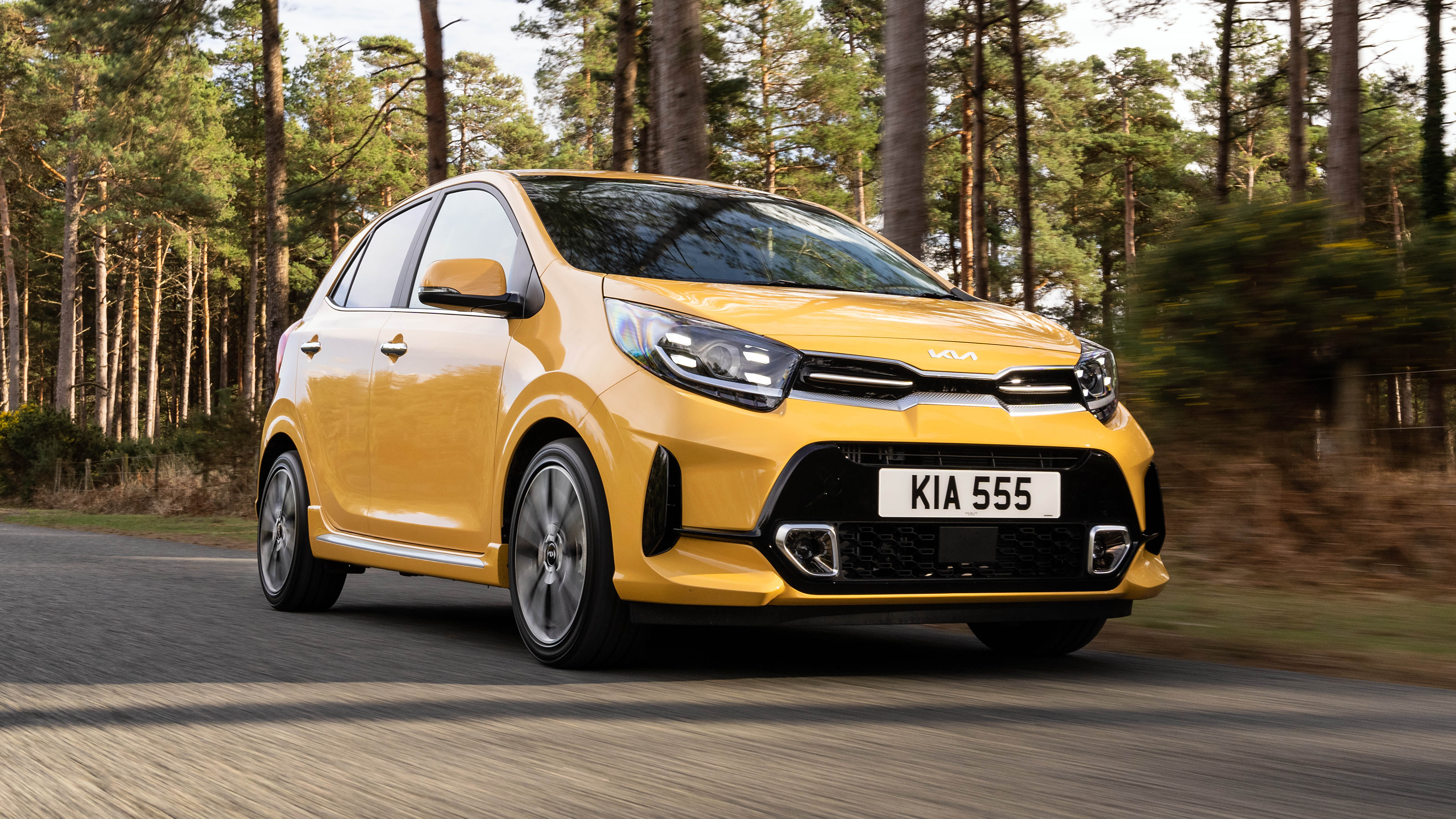
Decent looks, roomy interior, good handling, cheap to run, great warranty
Lesser models could do with more power, of course
What is it?
Despite its spicy sounding name, the Kia Picanto started life in 2003 as a fairly bland looking (albeit cheaply-priced and decently-equipped) city car . The second version in 2011 took full advantage of the Korean brand’s design awakening, with famed German scribbler Peter Schreyer (he designed the original Audi TT among other things) lending the company’s output some much-needed Euro flair and credibility.
Schreyer’s signature move was the introduction of the firm’s ‘tiger nose’ grille, which has become familiar over time but was a bold look when it was first unveiled.
And this is the third-gen car, right?
Correct. Unveiled at the Geneva Motor Show (remember those?) in 2017, changes between the second and third iterations were initially limited to freshening up detail tweaks, a mark that there were barely any profits to be had in the city car segment. Especially from cars powered by ghastly petrol engines. Still, Kia did manage to find the funds for a mid-life facelift in 2020 with new headlights, bumpers and infotainment screens. The usual fare.
You don’t like it then?
That’s where you’re wrong. It’s a shame that more people haven’t switched on to the Picanto. It shows up to the small car party with pep and fizz that few of its rivals can muster. It’s a hoot to drive around town and plenty practical enough for day-to-day urban life.
Take it further afield on longer journeys and you’ll bump into some of the car’s shortcomings, but it’s never been billed as a long-distance cruiser. Although it perhaps falls short in terms of outright quality (on some trim levels) and dynamics, the car has a lot in its favour, especially when it comes to taking the chore out of everyday city driving.
Tell me more about what I can buy…
The Picanto range has impressive breadth – 1-, 2- and 3-spec cars begin the selection, the former kicking off proceedings at £12,250 these days and advertising its electric front windows, USB port and Bluetooth with pride. As with most cars, the entry models grab the headlines with their low, low prices, but the sweet spot is higher up the spec list as more of the good stuff becomes available. The 3 is the first to get Apple CarPlay and Android Auto, and the larger infotainment screen.
Are there more than the numerical specs?
Yep, at the top of the price sheet you’ve got the GT-Line (£14,900) and GT-Line S (£17,050) cars, which bring all the toys and personalisation options that the kids love so much. In fact the top spec cars offer features that you’re surprised to see at this end of the market – options include automatic aircon, cruise control, a wireless phone charger, heated seats and wheel, keyless go and a reversing camera.
There’s different styling too – we’re supposed to believe that a reprofiled bumper and a few red accents will make a car sporty. Actually the engine makes the biggest difference here, more on which next.
And what’s that jacked-up crossover thing I see in the pics above?
That’ll be the plastic-clad X-Line and X-Line S options that sit 15mm higher and come with a few extra bits of cladding stuck on the outside for that faux-SUV look (and a slightly higher hip point for the bingo crowd) – Kia will have you believe a tube of glue and some grey plastic will turn a city car like the Picanto into a crossover, but let’s not get carried away with ourselves.

What are the powertrain options?
The equipment levels might be baffling, but the engine selection really isn’t – there’s only the single 1.0-litre 3cyl engine available for the Picanto, with five-speed manual or five-speed automatic gearbox options.
In all but GT-Line guise the motor produces just 66bhp, but the top trims give you the option of turbocharging the petrol unit for a spicier 99bhp. It’s still not quick mind, that engine drags the Picanto’s 0–60mph effort below 10 seconds by the skin of its teeth.
What are its main rivals?
Good question. The city car segment has lived through its heyday, it seems, as people nowadays are more interested in bigger motors with more space and a better view of the road. Still, there are a few good alternatives to choose from: the Hyundai i10 , Toyota Aygo , VW Up and Fiat 500 are probably your best options.
Our choice from the range

What's the verdict?
The Picanto has learned from the likes of the Fiat Panda that drivers will forgive a lot inside a car as long as it’s presented in a fun way and is cheap to run. For a first car or something that’s just needed as a runabout, you couldn’t go at all wrong with the Picanto. It’s fun, frugal and feels like great value for money.
It's not often we’d say this, but the X-Line ‘crossover’ version is worth considering. It gets chunky looks, decent levels of equipment and a slightly more supple ride thanks to its lofty 15mm height boost. Loses none of the urban driving entertainment either. If you want a properly fun little baby supermini though (and one that can cope with the occasional long journey) we’d recommend the sportier looking GT-Line with the more powerful turbo engine and of course a manual gearbox. There might not be a better car to learn how to drive in on the market right now.
Overall the Kia Picanto is an impressive all-rounder, and recent tweaks have only served to make it a more enticing prospect. There’s life in the city car segment yet people.

Hyundai i10

Volkswagen Up

F1 24 review: a modest seasonal update
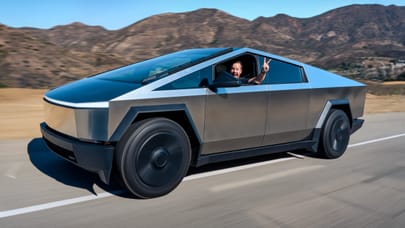
Here are 12 electric pickups you need to know about
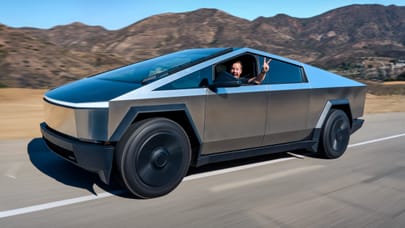
Tesla Cybertruck
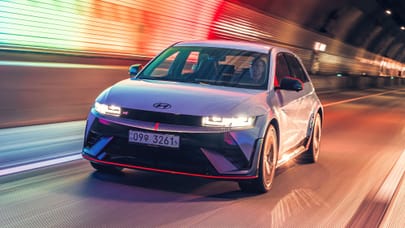
Top Gear's top 20 electric cars
Trending this week, here are 10 interesting classic cars for under £5,000 we found this week, woah, byd claims it’s created a 1,300-mile plug-in hybrid set-up, mazda, subaru and toyota have confirmed they're all working on next-gen combustion engines, these are the best on-screen car chases according to tg readers, here are nine of saab’s greatest hits, subscribe to the top gear newsletter.
Thank you for subscribing to our newsletter. Look out for your regular round-up of news, reviews and offers in your inbox.
Get all the latest news, reviews and exclusives, direct to your inbox.
By clicking subscribe, you agree to receive news, promotions and offers by email from Top Gear and BBC Studios. Your information will be used in accordance with our privacy policy .
Sorry, something went wrong

Try BBC Top Gear Magazine
- Manage Account
- The Courier ePaper
- Evening Telegraph ePaper
- > Media Cart
- Belgium (fr)
- Belgium (nl)
- European Union
- Netherlands
- The upgraded Kia Picanto
Download (1)
- Format: msword File size: 0.22MB">Press_Kit-Kia_Picanto-Final-10_February_2020.doc Download Press_Kit-Kia_Picanto-Final-10_February_2020.doc
The Kia Picanto: a distinctive new design with ‘class-above’ technologies
Download the full press kit here
- Refreshed design for all models, including GT-Line and X-Line variants
- A vibrant character: new interior colour customisation options available
- Efficient new ‘Smartstream’ gasoline powertrain line-up and a new Automated Manual Transmission option for drivers needing an auto
- New ‘Phase II’ UVO Connect telematics and advanced infotainment system
- Forward Collision-Avoidance Assist
- Upgraded Picanto on-sale in Europe from Q3 2020
Kia’s smallest model, the Kia Picanto, features a range of substantial mid-life upgrades, keeping it one step ahead of its competitors. The upgraded model boasts a vibrant design and fun-driving attitude, combined with ‘class-above’ connectivity and safety technologies, and lower emissions from newly reengineered powertrains.
The upgraded Picanto brings with it a suite of advanced safety technology from Kia’s larger cars, making it among the safest cars in its class. It also offers Kia’s new ‘Phase II’ UVO Connect telematics technologies, enhancing vehicle connectivity and control to take the stress out of journeys. Enhancements to the Picanto’s gasoline powertrain line-up include Kia’s optional new Automated Manual Transmission (AMT) for a smoother drive.
The Picanto is one of Kia’s best-selling models in several regions worldwide, and a particular favourite among European A-segment drivers. The upgraded Picanto offers Kia’s industry-leading 7-Year, 150,000-kilometre warranty as standard.
Exterior design
Refreshed design with a distinct new look for GT-Line and X-Line models
The Picanto line-up has received a comprehensive enhancement to exterior design, with significant updates made to sporty GT-Line and SUV-inspired X-Line models in particular. The result is a refreshed, more distinctive appearance.
The ‘face’ of both the GT-Line and X-Line Picanto models has been revised to give each car a more purposeful design. This starts with the ‘tiger-nose’ grille, which features a new textured surround and open-link appearance. The chrome-effect surround forms a sweeping shape which extends into the lower part of the redesigned headlamps, and gives the car a wider, more stable appearance. Each side of the ‘tiger-nose’ features a red highlight on GT-Line models, or more technical black trim X-Line models which resemble air intakes.
Both versions of the car now feature redesigned headlights and four-bulb LED daytime running lights. At the rear, the car also features a new LED rear combination lamp design and a slimmer fog light design, creating a more recognisable rear light signature at the same time.
Both GT-Line and X-Line models feature refreshed front and rear bumper designs with sharper creases in the bodywork for a more contemporary appearance. The changes create a more rugged, robust-looking design for X-Line models and, for GT-Line models, an appearance which visually links the car to higher-performance GT models in Kia’s range. A larger, wider air intake in the lower bumper is accented by the GT-Line’s body-coloured bumper with gloss black highlights, and jewel-like fog lamps. X-Line models echo the appearance of SUV protective skid plates, with metal-effect trim bearing the X-Line logo, and a gloss black surround which extends from the front grille into the wheel arch surrounds at the side of the car.
The upgraded Picanto offers buyers greater potential for customisation, with a choice of 10 vibrant paint finishes designed to make the car stand out.
Interior design
Improved infotainment screens and new customisation options
Inside, the Picanto features a series of visual and technological upgrades, centred around a larger 8.0-inch ‘floating’ widescreen audio visual navigation (AVN) system (see ‘Infotainment’ for more details), and a high-resolution 4.2-inch digital display in the driver’s instrument cluster.
Depending on trim level and market, the Picanto’s cabin is offered with black cloth or synthetic leather seats, with the upgraded model finished with a range of new upholstery textures for a more contemporary, higher quality look and feel. The cabin is finished with black, silver or gloss black highlights in the door, on the dashboard and around the gear selector.
The upgraded Picanto is also available with a range of trendy interior colour packs to enhance customers’ ability to customise the cabin of their car, depending on vehicle specification and market.
The Lime Pack features a black single-tone interior with lime contrast stitching and white seat bolsters, silver metal painted transmission and air vent surrounds, and silver-and-lime accents in the doors. Models equipped with the Orange Pack feature a black single-tone interior with orange stitching and cabin highlights, and black-and-orange door accents. Red Pack models are finished in black upholstery with red seat bolsters, as well as gloss black highlights and red-and-black door accents. Finally, the Green Pack offers green highlights throughout the cabin and silver-and-green door accents, as well as stylish denim-effect seat upholstery.
Powertrains
New ‘Smartstream’ engine innovations increase efficiency
The upgraded Picanto is available in Europe with three new ‘Smartstream’ gasoline engines, each maximising efficiency and lowering CO 2 emissions compared to their predecessors. The engine line-up features a 1.0-litre T-GDi (turbocharged gasoline direct injection) engine producing 100 ps, or a pair of naturally-aspirated 1.0-litre or 1.2-litre DPFI (dual-port fuel injection) engines, producing 67 ps and 84 ps, respectively.
Among other innovations, the 1.0-litre T-GDi engine features a more efficient 350 bar high-pressure fuel injection system. Meanwhile, the two naturally-aspirated engines replace multi-point injection with new dual-port fuel injection technology, with optimised injection timing for maximum fuel efficiency. They feature improved exhaust gas recirculation lines and optimised intake valve timing, for maximum fuel efficiency improvements.
All three engines are equipped with a new Integrated Thermal Management System (ITMS), which provides more effective combustion chamber cooling. ITMS varies engine cooling characteristics based on the engine’s operating point.
All three engines drive the front wheels via a five-speed manual transmission. The updated Picanto is also equipped with Kia’s new Automated Manual Transmission (AMT). The AMT is based around a five-speed manual transmission with clutch and gear shift actuators to automate clutch operation and gear shifts. Using a single dry clutch, the AMT is a cost-effective option for customers who favour the convenience and ease-of-use of an automatic transmission, without sacrificing the fuel efficiency of a conventional manual transmission. The AMT is available on both the 1.0- and 1.2-litre naturally aspirated engines.
Infotainment
UVO Connect ‘Phase II’ telematics with an upgraded touchscreen
The Picanto features a larger 8.0-inch ‘floating’ touchscreen navigation system, replacing the earlier 7.0-inch system. It also features Bluetooth multi-connection, enabling users to pair up to two mobile devices at the same time – one for hands-free phone and media use; the other for media use only. The system features Apple CarPlay and Android Auto as standard.
Kia’s new ‘Phase II’ UVO Connect telematics features include a range of on-board services including live traffic information, weather forecasts, points of interest (POIs), fuel prices, and details of potential on- and off-street parking – including price, location and availability. Online Voice Recognition lets users search for POIs, addresses, weather updates, or send text messages with voice commands. Depending on country, users can remotely send route directions to their car before a journey, check the location of their vehicle, and access vehicle reports and diagnostic notifications.
A new ‘Online Navigation’ routing service uses cloud-based real-time and historical traffic data to predict time-efficient routes more accurately than ever before.
Users can also access the accompanying UVO App, compatible with Android and Apple smartphones, which offers new ‘Phase II’ features such as Last Mile Navigation. This helps customers continue navigating to their destination after they have parked and left the car behind. It helps Kia customers navigate in towns and cities where parking hubs are often some distance away from shops, cafés and restaurants.
Ride and handling
Fun and easy to drive in town, comfortable and stable out on the open road
The Picanto combines high ride stability with quick, enjoyable handling responses, aided by independent MacPherson strut suspension at the front and a torsion beam rear axle. In addition, its relatively long wheelbase contributes to a natural improvement in ride quality and stability on all roads.
A quick steering rack enables immediate responses to driver inputs, while meaning fewer turns of the wheel from lock-to-lock than many rivals (2.8 turns), making the Picanto easy to drive at low speeds and in the city. The front wheels are pushed close to the front of the vehicle, resulting in low weight ahead of the front axle and more agile handling.
The Picanto offers torque vectoring by braking – an additional function of the Electronic Stability Control system (ESC; see ‘Safety’). The use of this new technology in an A-segment car means the Picanto retains a higher degree of handling stability and security under cornering, while helping to reduce understeer during harder cornering.
Wide range of new ADAS, safety and convenience technologies available
The upgraded Picanto features several of Kia’s latest Advanced Driver Assistance Systems (ADAS), and a range of new active safety systems to enhance occupant safety, making it one of the safest cars in its class.
Depending on specification, the Picanto’s new ADAS range includes Forward Collision-Avoidance Assist (FCA) with vehicle and pedestrian detection. Additionally, the Picanto is available with Blind-Spot Collision-Avoidance Assist (BCA), Lane Keeping Assist (LKA), Driver Attention Warning (DAW), and Lane Following Assist (LFA).
LFA uses the front-facing camera and sensors to monitor road markings, controlling the Picanto’s steering to keep the car in the centre of its lane. The Picanto also features Rear Cross-Traffic Collision-Avoidance Assist (RCCA) which alerts the driver and stops the vehicle if it detects another vehicle approaching from the left or right when reversing out of a parking space.
The Picanto is equipped with an Emergency Stop Signal (ESS), which automatically flashes the hazard warning lights to alert the car behind if the driver has to brake suddenly. Hill-start Assist Control (HAC) holds the car on the brake to ensure the car moves away smoothly from a hill start.
The updated Picanto is also equipped with Kia’s Vehicle Stability Management (VSM), Torque Vectoring By Braking, Cornering Brake Control (CBC) and Straight-line Stability (SLS) systems as standard, helping drivers maintain control under braking and cornering.
The updated Picanto is fitted with up to seven airbags throughout the cabin, including a driver’s knee airbag, depending on specification and market. It also features ISOFIX child-seat tether and anchor points.
Production and sales
On sale: updated Picanto arrives in Europe in the third quarter of 2020
The updated Kia Picanto is manufactured in Korea and has been on-sale across Europe since the third quarter of 2020. All models offer the company’s unique 7-Year, 150,000 km warranty as standard.
Press Contacts

Primary Navigation Mobile
- Vans & Pickups
- – New car reviews
- – Used car reviews
- – New Car Awards
- – Car companies
- – Electric cars
- – SUV Cars
- – Owner reviews
- – Extended reviews
- – Used cars for sale
- – New cars for sale
- – Nearly new cars for sale
- – Car history check
- – Car choosing tool
- – Free car valuation
- – Sell my car
- – Car Leasing
- – Car leasing special offers
- – Car leasing advice
- – Car Finance
- – Car finance advice
- – Get finance quote
- – Car loan calculator
- – Car Tax advice
- – Best Cars
- – Best car products
- – Car buying
- – Car glossary
- – Used cars
- – Car news
- – Car comparison
- – Car Jargon Explained
- – Car tax calculator
- – How benefit-in-kind BIK tax works
- – Buy a car warranty
- – Compare car insurance
- – Find a car's insurance group
- – GAP insurance
- – Car insurance advice

Kia Picanto long-term test
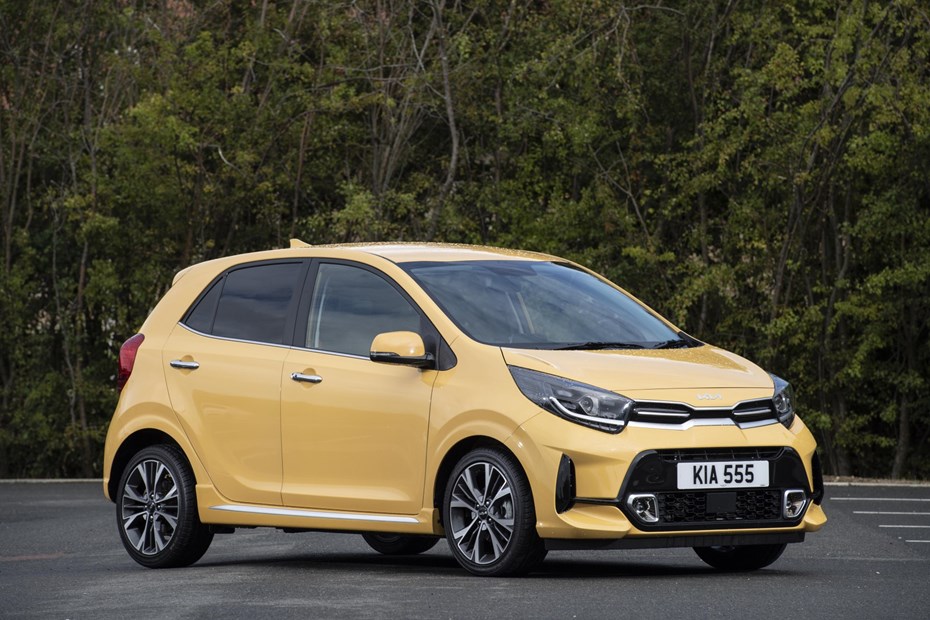
Written by Tom Wiltshire Published: 26 October 2022 Updated: 5 May 2023
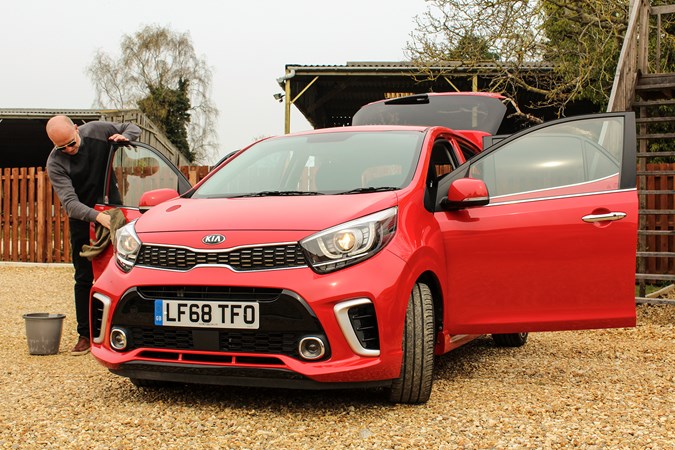
Update 1: Welcome
The third incarnation of the Picanto has garnered positive reviews since its launch in 2017, with the range topping, performance orientated GT-Line model also winning its fair share of plaudits. The aggressive styling, sharp handling and exhaustive kit list of the small city car impressed at launch, but many questioned whether the power plant lived up to the car’s sporting ambitions. While the 1.25 litre four-cylinder engine is a great free revving unit, it couldn’t really be considered a true performance motor.
Kia has now added the T-GDi three-cylinder engine to the GT-Line range. It’s only 1.0-litre in capacity, but comes equipped with direct injection and a turbocharger , which boosts it’s performance to 99 hp up from the 1.25 litre’s 83hp. It’s an engine which is shared with the Picanto’s bigger siblings, the Rio and Ceed .
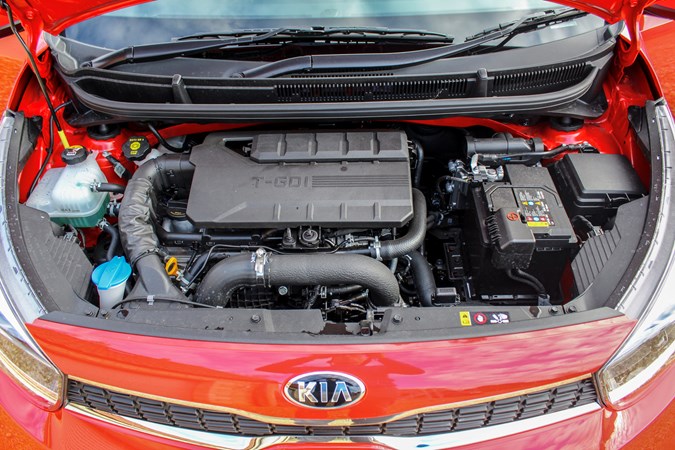
The result is the most powerful engine that’s ever been available in a Picanto and it’s this engine in GT-Line spec we have on test for the next six months. Will this new addition make the GT-Line a true mini hot-hatch it so wants to be? Over the coming months we will no doubt find out.
It had to be red
Our Picanto comes in the premium Chilli Red finish. While the fine-flecked metallic paint provides a dazzling deep finish it’s worth noting the four other colours available all come with sporty red body trim around the front bumper and door bases. Those red details are swapped for chrome on our model. That makes our car look more sophisticated but loses some of the visual sportiness that comes with the other colour variants.
This GT-Line arrives in the ‘S’ variant and is packed with a bewildering list of options and goodies. There are some real big car features, including:
- Autonomous emergency braking
- 7.0-inch touchscreen sat-nav with RDS, DAB , Apple CarPlay and Android Auto
- Climate control
- Wireless mobile phone charger
- Cruise control and speed limiter
- Rear parking sensors and reversing camera system
- Heated front seats and steering wheel
- Electric sunroof
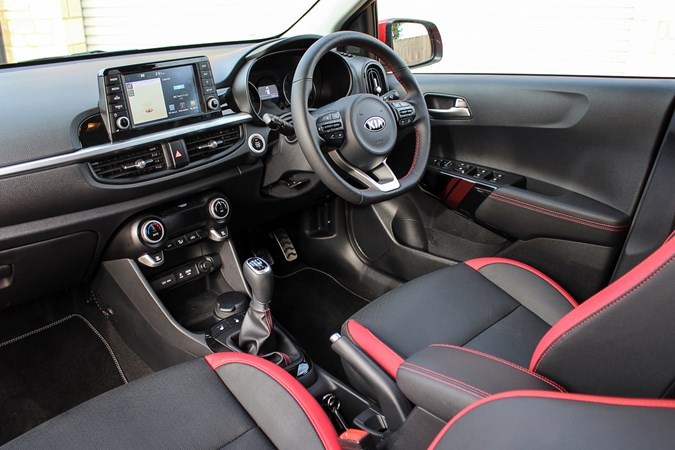
With the only additional option the £515 premium paint finish our Picanto comes in at £15,235 on the road. That’s not cheap for a car of this size but then there’s an incredible amount of kit bundled within that price.
Update 2: Performance and handling – what’s it like to drive?
The Picanto’s power delivery is present right from the off with no hint of turbo lag. Turning out of my drive onto a clear country lane I kept accelerating and that sharp, instant tug kept on pulling right through the rev range up to the red line of 6,500rpm. The T-GDi engine has a rorty sound that makes me think it could be very addictive indeed. Kia has used some clever variable valve timing and crankshaft design to achieve this light-switch fast power delivery. That delivery is remarkably linear too, building smoothly right up to the red line.
The ride also has a sporty setup. It’s firm but not harsh and still adequately comfortable for gentler journeys. The only downside is it can be noisy inside the cabin, not from the delightfully resonating engine but from road noise. Small city cars often compromise on sound deadening to save weight and cost. Combined with the Picanto’s wider, lower profile tyres it’s noticeable how much din is coming from the road. Travelling along a recently graveled road the Kia made a real racket and sounded like an upside down hailstorm.
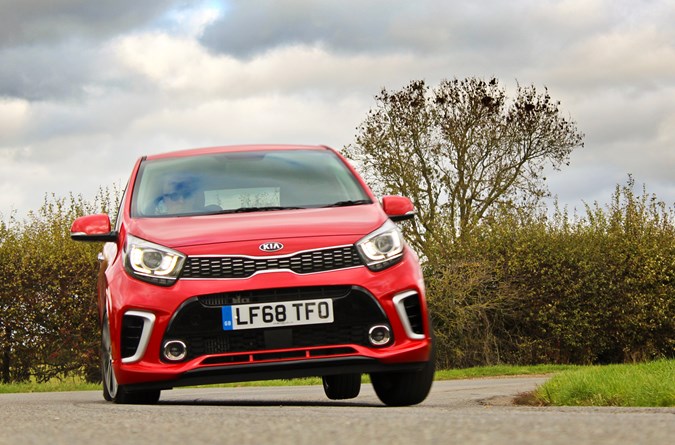
The handling completes the performance car feel. It’s composed and offers an incredible amount of grip. So much so that occasionally the front end will dig in on a corner and turn too much. Fortunately this deviation is well telegraphed and can easily be dialed out without any drama.
Fast, but not that fast
The T-GDi engine does make the car feel a lot faster but we’re not quite up to hot hatch territory yet. The power to weight ratio of the Picanto clocks in at 98hp per tonne but if you compare that to a benchmark hot hatch like a VW Golf GTi it’s a different story. Looking at the bare figures the Kia probably couldn’t be considered a true hot hatch but the important factor is it feels faster than it is.
There’s the noise and drama under acceleration, there’s the sporty ride and even the diminutive size of the car all contributing to a feeling of rapid speed and excitement. This lack of outright performance also makes the car more fun. You can explore the outer limits of the car’s abilities without worrying if you’re going to end up in a hedge or adding points to your license.
Other superminis and hatchbacks with some sort of performance bias I’ve driven have all had sophisticated handling while offering a good level of refinement. The Picanto feels raw in comparison. Not that I believe the rawness is intentional, to make the driving experience more sporty and engaging, but more a result of sticking a powerful engine and wider tyres on a pretty basic small city car. Intentional or not the feel of the GT-Line S T-GDi works for me, I like the extra road noise, the engine sound under acceleration too fills the cabin.
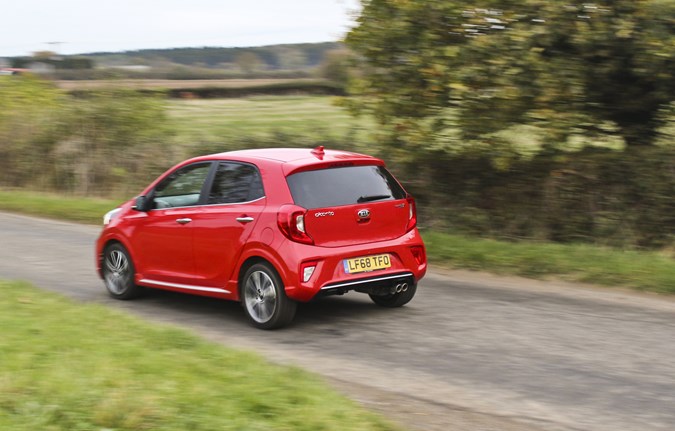
On narrow lanes with at least half of the corners unsighted you have to slow sometimes to a crawl to negotiate safely – the Picanto is really in its element with this type of terrain. With quick bursts from an almost standing starts to 30 or 40mph and then braking sharply for the next tight corner and accelerating once again. The Picanto feels rapid at these lower speed roads. Only on longer straights does the lack of outright pace show that this is a warm rather than hot hatch.
Another area magnified by driving other larger performance hatches is the amount of bodyroll the Picanto suffers from when cornering. This is not a car that’s spent months on a proving ground getting its suspension tweaked and honed to accommodate the bigger and wider wheels. If you want something with a more sophisticated ride and handling and you’d better look at a supermini sized car and upwards. Still, even though the car lacks sophistication there’s a no-nonsense charm to this city car that’s a little addictive.
It’s so good in fact that I’ve been trying to think of a time when I last had this much fun in a car this small. I realised it must have been a good 20 years ago and after a quick look in an old back issue of Car magazine I discovered it was in fact exactly 20 years ago.
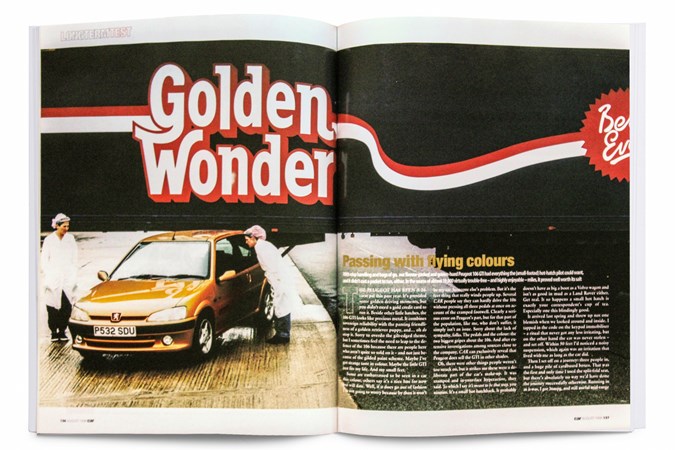
Back in 1997/98 my then colleague at Car magazine, Paul Horrell, ran a Peugeot 106 GTi as a long-term test car for over a year. At the time his house was quicker to get to by walking than driving on the congested streets of London so he didn’t have much cause to use it during the week. I gladly snaffled the keys every night and ended up racking up as many miles in that car as he did.
It made my commute home to South East London from our city centre office an absolute hoot. I remember our repro house couriers had plotted a route for me made up of their tried and tested rat runs through East London and the Blackwall Tunnel. It got me home in half the time and actually made it a pleasant, relatively traffic-free journey. Very quickly, thanks to the 106, I fell in love with the concept of small hot hatches, they just seemed to make so much sense driving in the city.
New decade, same problem
Back in the day when fuel efficiency was less of a priority, manufacturers threw capacity at an engine to give you the thrills. I remember the 106’s naturally-aspirated four-cylinder 1.6-litre engine was great in the mid-range revs and went a little frenetic, in a good way, at even higher revs.
It seems the conventional wisdom these days that to reach equivalent performance while reducing emissions you need a turbo. What it does mean is the Kia’s engine is much more responsive at lower revs than the icon from 20 years ago and makes for even more pleasurable driving in the city, bursting away from the lights at a rapid rate.
With these two approaches to performance engine design you’d think there would be wildly different fuel economy readings but after 20 years of development the figures are still very close. The 106 – after 14 months and 18,000 miles – clocked in at 33.2mpg. And with the latest 1,000 miles of motoring, the Kia posts a figure of, yes you guessed it, 33.2mpg. The 106 actually generates 20 more horsepower than the Kia and slices a good second off the 0-60 time.
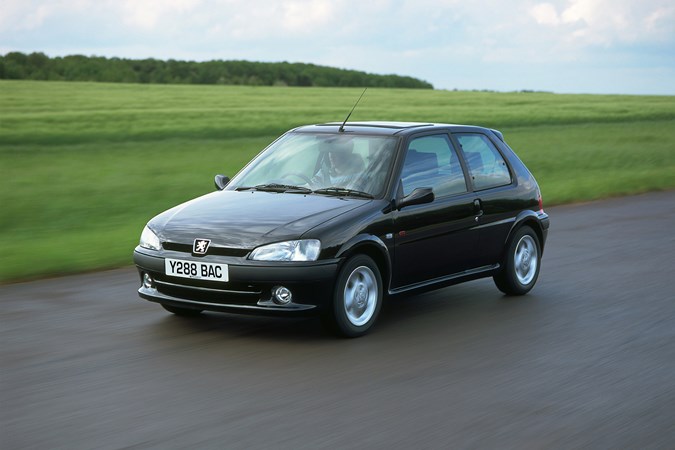
I remember the Peugeot generally felt a lot faster although the Picanto’s rorty engine note makes up for some of that lost sensation. It just goes to show that despite the Kia having an undoubtedly more sophisticated engine than its 90s counterpart there is still no magic bullet to making a performance engine frugal too.
So will the Picanto with its T-GDi engine join the 106 GTi in hot hatch folklore and be wistfully talked about in 20 years time? Probably not to the same extent, although I know I’d worry less about the Picanto’s legacy and take the Kia’s elegant and gizmo packed interior every time. That’s enough progress for me.
Update 3: Comfort and interior
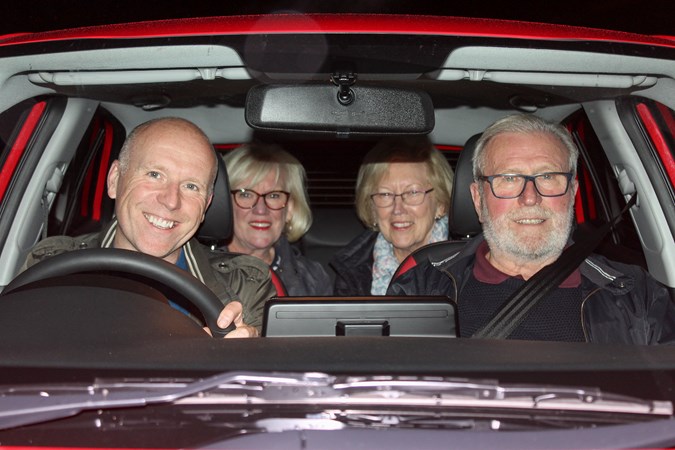
The Picanto is positioned as a small city car but that hasn’t stopped me from using the car for my usual demanding workload. Straight after delivery the Kia was pressed into service with some long distance commuting – it suffers from a lot of road noise that is amplified at motorway speeds. You can drown it out using the six speaker sound system but volume has to be pumped up to sometimes uncomfortable levels.
A lack of adjustable lumber support on the front seats meant my taller than average frame was left in a hunched position giving me a heavy dose of backache. I bought my own lumber support pillow to help alleviate the problem but the sports seat design meant the pillow didn’t fit well and was soon abandoned.
There were some positives on the long motorway jaunts, the cruise control was intuitive to operate and the controls are well positioned on the steering wheel, it’s certainly novel to be using such a system on a car as small as this. Overall though, I couldn’t wait to get back onto A and B roads, if anything, to give my ears a rest. The occasional long motorway trip is bearable but anything more regular and I’d recommend a larger and more comfortable middle of the range car.
Quality interior
The Kia’s interior is a very considered and fine detailed affair. There are tasteful red flashes on the quality leather-look seats. Intricate red stitching around the black door grabs. Even the additional cheaper plastic door panels are well coordinated in black and red graphics.
This is by no means a luxury interior, there are still cheaper plastics left over from the base models but overall it’s a well designed, tasteful place to be, putting bigger, more expensive cars to shame. In GT-Line S spec the standard options list is impressive – I wonder if some of those toys are there for the brochure list rather than being genuinely helpful.
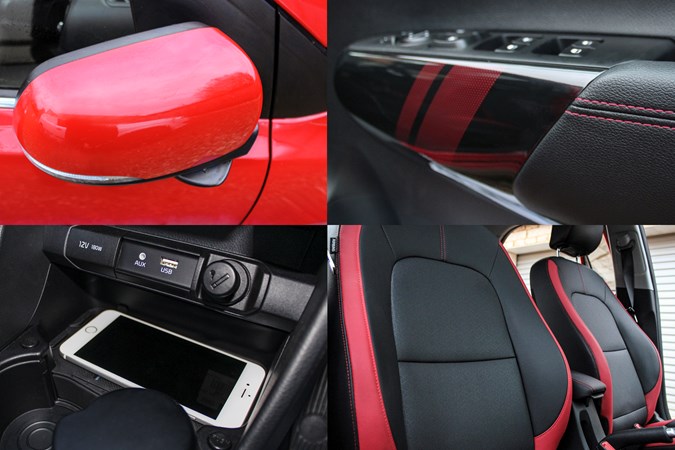
The electronically folding mirrors can’t be set to when the car is turned on and off so I rarely remember to use them, though.
The big car spec
This small city car has a big car level of spec and my new winter-time ritual when getting in the car is to deploy the heated seats and steering wheel immediately. I’ve always thought heated steering wheels are a little gimmicky but combined with the heated seats, there is no quicker way to get warm on a cold winter morning. They really are very rapid.
I’m a really big fan of the finish on leather look seats too. They’re very convincing and tastefully upholstered with small red panels and red stitching. They’re even more practical as the smudges left by dark jeans on the red flashes wipe off with a damp cloth. I’ve had to buy expensive leather cleaning products to do the same job with real leather seats.
One feature not tested so far is the wireless charging point. I’m a bit behind the times with my tech but luckily my daughter’s splashed out on a new phone.
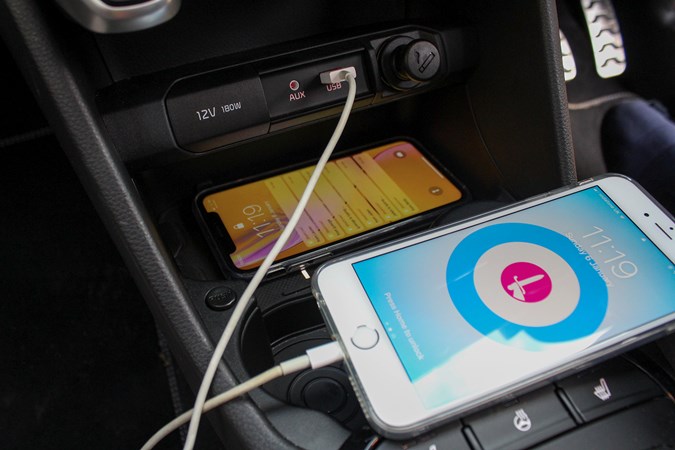
The charger panel is conveniently placed just in front of the gear stick so you can almost throw it in place when you get in. Once in place the charging is completely automatic. It now means we can charge two phones at once, one wireless and one wired through the USB slot. Although you still need to plug it in to use Apple CarPlay. The USB option also charges a lot faster too which makes the wireless charger seem a little redundant in most circumstances.
What’s it like for passengers?
My weekly motoring patterns usually involve a lot of ferrying people around but again I haven’t let the size of the Picanto excuse it from my taxi service duties. One week I was picking up my parents and visiting auntie from a night out, the next it was a shopping trip for the whole family.
All four full seats were occupied and all passengers, even the adults praised the amount of rear space available, head and legroom seemed more than adequate. There were less positive comments about the ride quality in the rear. One complained that they ‘felt every bump in the road’ and another who had gone from sitting in the front to the rear perceived a noticeable stiffening to the ride when in the back. The ride has never been that forgiving, It’s firm without being harsh and that’s how it’s mostly stayed so far despite the Kia finding some horrendous freshly mined pot holes.
I even had someone claiming it had damaged their back but then we were travelling along a road a local TV programme had described ‘the worst in Britain’. My back seemed to cope with this extreme test well but then the ride in the front might be a lot kinder. Because of where the rear seats are positioned passengers are sitting right over the rear axle.
Update 4: Practicality
The other day the Kia had to shift something a little bigger. It was nine foot artificial Christmas tree (yes, I’m the one who buys Christmas decorations in the January sales).
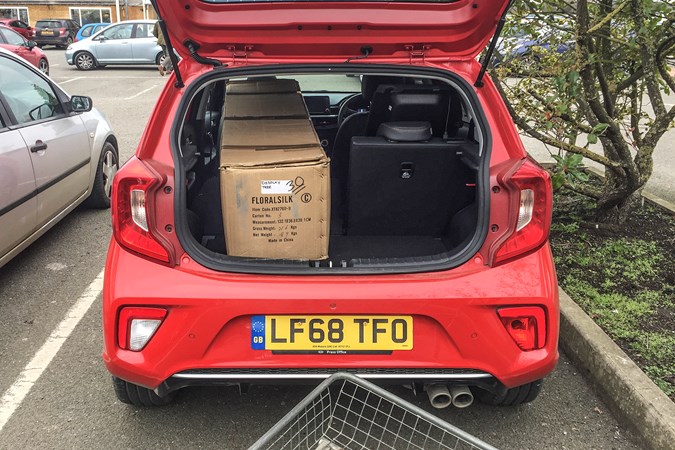
To flatten the rear seats was just one small pull on a lever on top of the seat. The seats were tensioned to fall flat so there was no awkward wrestling seats into place. Similarly the front passenger seat was spring loaded like a three-door car front seat and it plopped into place immediately. Those two small tugs is the least amount of effort I’ve had to employ to flatten car seats. Full marks to Kia there.
Despite having a bigger car within the family I still like to take the Kia on the weekly trip to the supermarket. Mainly because the boot is much bigger than you’d imagine and it’s so easy to park. I can almost get the families shopping in the boot with perhaps the odd bag sitting on the rear seat.
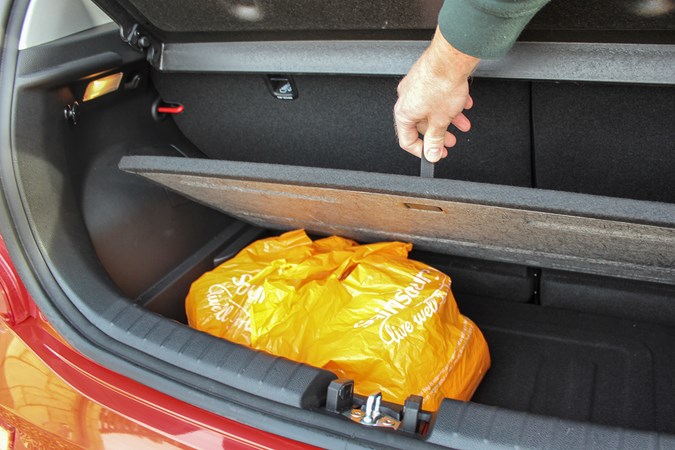
That’s not surprising because the Picanto boasts best in class boot space. It also comes with a handy shelf that sits half way up the boot and stops the bottom row of shopping getting crushed.
Now the weather has changed, though, it seems impossible to keep this little Kia clean, especially the rear of the car. Because of the Picanto’s flat-sided rear styling it seems to suck up all the crud from the road.
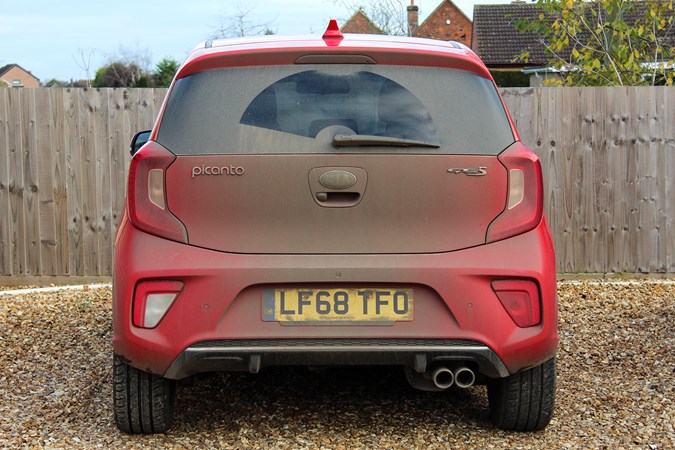
That covers one of this car’s better features, the rear parking camera. The system usually has excellent picture quality, even in low light, but after only a few days rain all you see when reverse is engaged is a splattering of dirt.
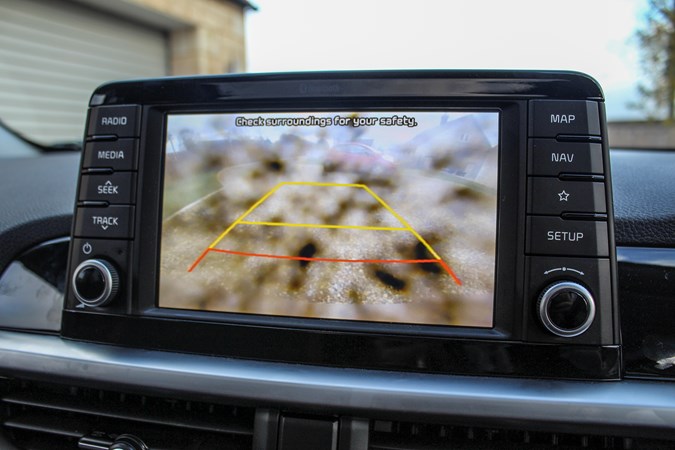
I’ve now trained myself to give the smartphone-like lens a little wipe whenever I open the boot.
Is it good in the city?
A trip to Leeds to take my daughter to a University interview meant a couple of hours on the motorway to get there. With Apple Maps very confused by the location of the University’s car park, we had to stop and try Kia’s built in sat-nav system.
As you’d expect with a native navigation system it’s no way as intuitive as the Silicon Valley software equivalents. The clunky menus and manual entry of any data means it’s always a last resort compared to simply barking orders using voice recognition with the Apple set-up.
Beating nearly all traffic away from the lights is the Picanto’s neatest party trick. It meant I then had precious added milliseconds to decipher the sat-nav and make the right choice with the native traffic closing in behind me, hands on horns ready.
When I did make a wrong choice and ended up in a dead end street I could call on the Picanto’s black cab-like turning circle to swing the car around with little commotion.
The Picanto’s size is a real benefit, it’s a particularly narrow car and can squeeze into all sorts of gaps making progress seem swift. Even our parking space at the now full multi-story was only available because no one else could fit in it.
Mission completed
On the return leg the Picanto’s extra horsepower meant it felt at home on the city’s rapid ring roads and despite it now being rush hour we were clear of town within 20 minutes. Again the Picanto surprised a fellow car by being first away from the lights.

At the next set the Audi RS3 made no mistake but it did look like it was trying a bit too hard.
The Picanto can be a little notchy going through first and second gears. It’s hard to get a completely smooth transition, but you do forget there’s a turbo boosting that performance and it’s undetectable, no turbo whine, no sudden boost of power mid corner. Overall you can accept a slight lack of smoothness considering the trick the engine is performing.
Back on the motorway I reflected on the Picanto’s intense introduction to city driving. It had all the attributes to make it a complete success. It’s very swift, highly manouverable and small enough to make use of gaps other cars can’t. If I lived in a city full time, I’d want one of these.
Update 5: Picanto vs Rivals
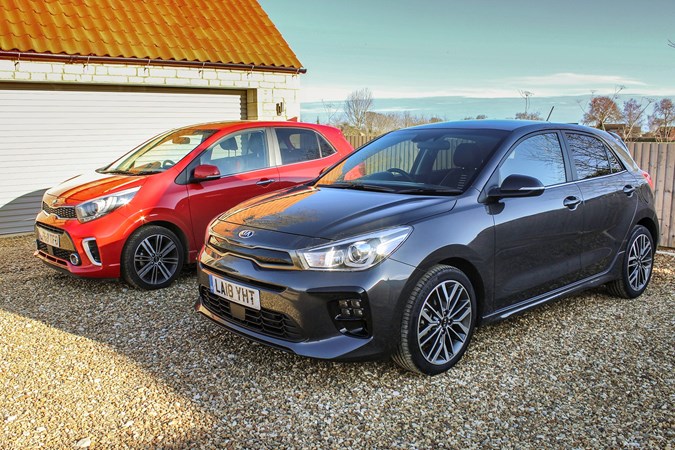
I thought I’d take a look at some of the T-GDi rivals. There aren’t too many warm or hot city cars on the market. Most city cars are kept to sensible, insurance friendly, vanilla spec. Jump up to the supermini sector and there’s a plethora of performance orientated hot hatches out there but in the world of the city car there’s only three or four. Here’s a few of them.
The performance version of the Fiat 500 starts at £15,980, £1,260 more that the Picanto T-GDi GT-Line S. That gets you 16-inch alloy wheels and a fairly well-trimmed cabin, with sports seats, metal-finished pedals, a leather gearknob,
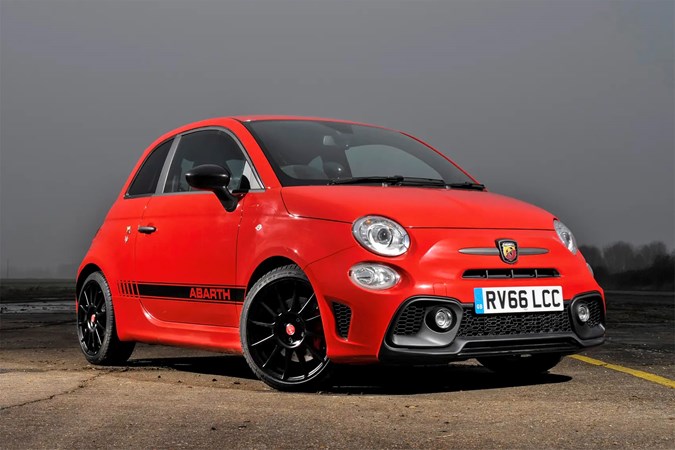
There are aso TFT instruments and a basic infotainment system with a five-inch touchscreen. Performance wise the engine is considerably more powerful at 143bhp compared to the Picanto’s 99hp. With a similar kerb weight to the Kia that translates to an impressive 0-62 time of 7.8sec, a full two seconds quicker than our car.
While it boasts impressive performance from it’s four cylinder engine it’s worth bearing in mind that despite a facelift in 2016 the fundamentals of the Fiat 500 are still the same from it’s launch in 2007. It’s starting to feel it’s age and feels less sophisticated than more modern cars. There’s also an unusually high driving position that doesn’t particularly feel that sporty.
The headline figures of a £14,315 starting price, 113hp engine and a 0-62 time of 8.8sec certainly makes the Up GTI look an enticing alternative to the Picanto T-GDi GT-Line S. It’s more powerful, faster and cheaper than the Kia.
It has the same engine layout as the Picanto, a 999cc turbocharged three-cylinder engine but squeezes an extra 14 horsepower from its unit. The interior is well-appointed, stylish and has a quality feel. It uses styling cues from VWs rich history of GTI production, a theme that translates to the exterior styling too. It really looks the part.
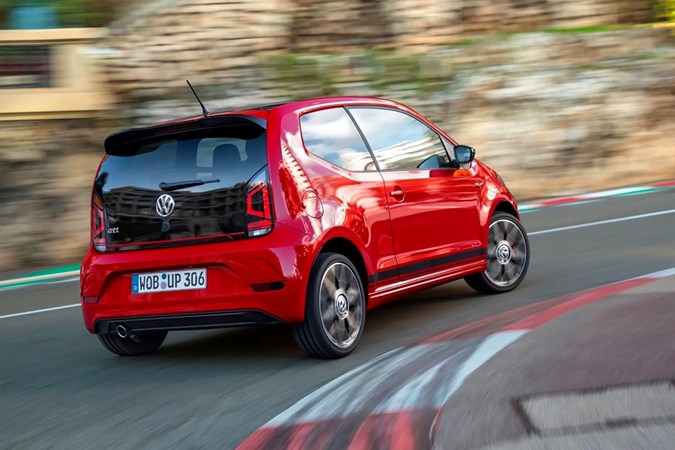
What is lacking on the Up is the tech inside. There is no satnav or infotainment screen in the Up, not even an optional one. Instead, there’s a built-in holder on top of the dash so you can mount your smart phone and use its functions to direct and guide you.
Some would argue that your own smartphone is more intuitive and powerful than most car infotainment systems. Generally though the Up is not as lavishly equipped as the Picanto. A cruise and park pack and rear view camera would set you back an additional £540 but beyond a Beats sounds system and Climate control there’s not even the option to match the Picanto’s standard equipment. In that regard the Kia’s £400 price difference seems very good value. Where the Up shines is with its driving dynamics. As you’d expect from a company with so much hot hatch experience the ride and handling is superb.
The 1.0 T-GDi GT-Line Eco is the warm hatch equivalent of the Picanto T-GDi GT-Line S we’ve been running. The super mini comes fitted with the same engine as our Picanto, although in a slightly different state of tune. Peak power delivers 118hp at 6,000 revs where our Picanto musters 99hp at 4,500 revs.
While there is some very close characteristics, like the same rorty noise, they do behave very differently. The engine in the Picanto delivers it’s burst of power early on where in the Rio the engine feels strongest at the back end of the rev range.
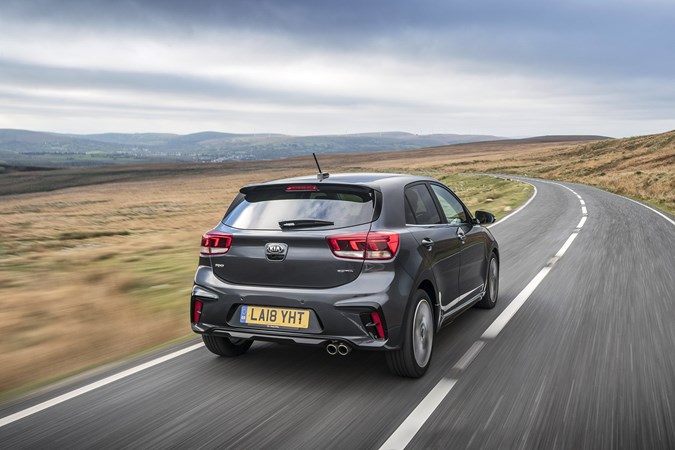
This might explain the slightly back to front fuel figures I’ve been getting from both cars. Despite being a heavier car by 145kg and with a higher state of tune the Rio has consistently posted a figure of 40.5mpg, which is over 5mpg better that the engine in the Picanto. The addition of a sixth gear must be helping the Rio achieve those figures but it seems the Picanto is paying the price for it’s off the line shove.
Should you upgrade?
I’ve talked before about how the Picanto is pricey for a car of it’s size, softened by the fact it’s got a big car kit list. The more competitively priced Rio in this spec is a much bigger more comfortable proposition offering near identical performance figures on paper, all for an extra £1745. In reality the cars are poles apart.
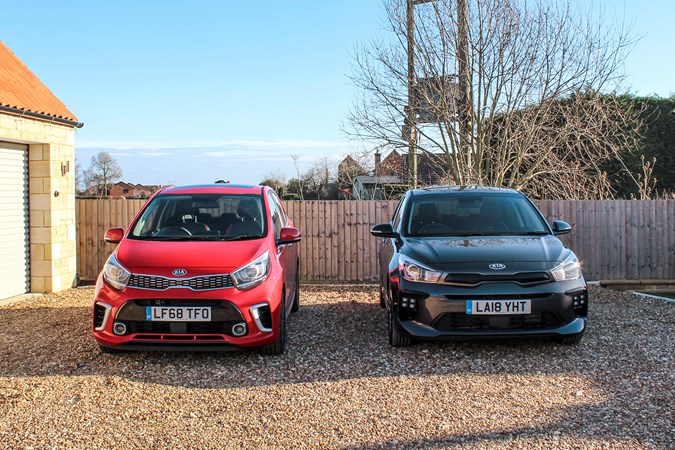
While the Rio is spacious and has a very comfortable ride when it comes to the corners it feels too soft and the steering feel is a little vague. I’ve complained about the Picanto’s road noise being too loud before but with the Rio it’s to the other extreme. It can be hard to hear the roar of the engine with the extra sound deadening fitted to the Rio.
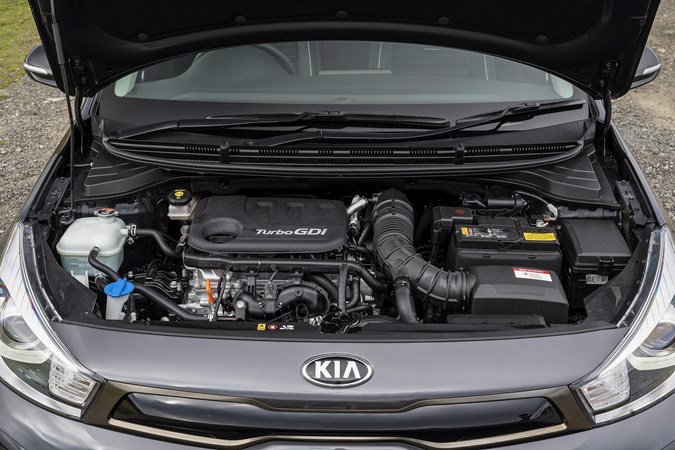
Overall the Picanto delivers a raw performance car experience and is therefore a more exciting car to drive.
The Rio features just a hint of a performance car feel while offering a cultured and comfortable ride that is beyond a car of this size. It’s worth noting that the extra cost and size of the Rio means it enters the very competitive world of the supermini sector, where there is a huge choice of sporty and great handling cars at very keen prices.
Update 6: Verdict
Our six-month test of the Picanto GT-line S is at an end and it’s time to give our verdict. Has the frisky new 99hp engine given the aggressively styled GT-line edition the performance boost it needed? Has the extra power transformed this humble city car into a pocket-rocket?

The turbo helps to bump up the power figures from 83hp on the standard GT-line model to 99hp in this GT-Line S. For me it’s the real highlight of the car. It hasn’t the performance a true hot hatch would command but what it lacks in power it makes up with a boatload of character. The sound under acceleration has the sweetest, rorty note and became increasingly addictive as my stint with the Picanto progressed.
There is no hint of lag and combined with tuning that favours the lower revs it really packs a punch away from a standing start. Only towards to the top of the rev range does that punch become more of a half-hearted swipe. That makes it the perfect engine to dart around town and city but fun out on rural roads too. Find a twisty stretch and the dart and braking between corners becomes pleasantly exhilarating.
The GT-line gets wide, low profile 16 inch wheels which offers a decent amount of grip in corners but there is a noticeable amount of body roll mid corner. That has the effect of making the offside front end dig in as you exit which then requires a slight adjustment in steering. So not the most fluid of handling cars but by no means bad, just not as sophisticated as some slightly larger superminis.
Ride and comfort
Those lower profile 16 inch wheels look great but the result is the ride is quite firm. Combined with city car spec sound deadening, which isn’t much, made longer journeys a little tiresome. Early on the Picanto had a spell of motorway commuting and I would often arrive a little exhausted with a ringing in my ears. The smaller city car sized seats would also cause some discomfort. They lacked any adjustment for lumber support and contributed, along with my tall frame, to a driving position that felt as if I was hunched over the wheel.
The Picanto is a small and narrow car, there’s not much on the market that is smaller in dimensions but inside it doesn’t feel cramped or claustrophobic. My children gave it the big thumbs up for legroom, that’s despite me having to push my seat back to the last stop to accommodate my height. They did complain about the ride though, more than the passengers in the front seats. The rear seats are positioned directly above the rear axle and transmit every bump in the road.
Interior and equipment
The GT-Line S is a very well equipped car. Sat-nav, rear facing parking camera, Apple CarPlay/Android Auto, heated front seats, heated steering wheel and a wireless phone charger are all standard items. There’s safety equipment too in the guise of Emergency Stop Signaling (ESS) and Autonomous Emergency Braking (AEB) which I can confirm works very well having been distracted a few times in slow moving traffic.
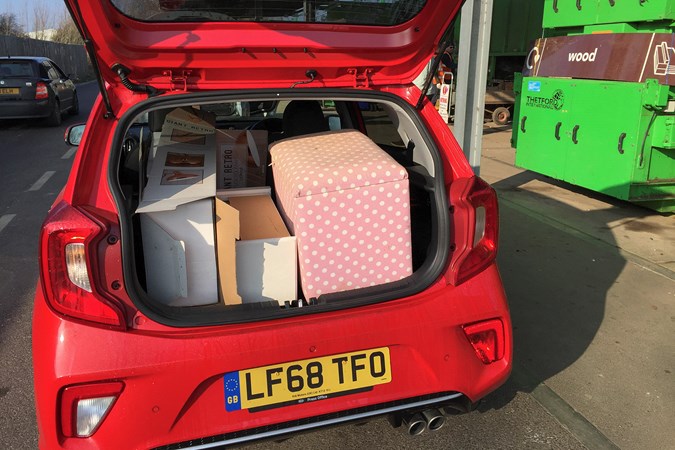
The fit and finish of the interior is in general excellent with only a few cheaper plastics left over from base models. The black and red faux leather is very convincing while being a whole lot more practical than the real thing. I was able to wipe away grime with a damp cloth that would normally require some fancy leather cleaning product. There simply isn’t another city-sized car on the market that comes close to the interior quality or it’s list of equipment.
Fuel economy
You can expect a car with a performance credentials not to deliver the best fuel figures but I must admit I was still disappointed with the fuel economy of the GT-Line S. There were times when I was disciplined enough to achieve a reasonably frugal driving style but was still unable to record anything higher than 35mpg. I’d say in this day and age that makes this city car a little thirsty. In a previous post I talked about running a Peugeot 106 GTi test car nearly twenty years ago and how that car had identical fuel economy. Perhaps that lack of turbo lag and off the line grunt does come at a price.
Should you buy a Kia Picanto?
The GT-Line S is not a cheap car. Our Picanto came with an extra paint option (£515) which pushed the price up to £15,235 on the road. That’s sailing into sporty supermini territory and is a very competitive sector where the cars are slightly larger and are generally more sophisticated.
I would recommended checking out some of that supermini competition before you make a decision. That’s unless small city car dimensions are a must. When Kia came to take the Picanto away and I watched it drive down the road for the last time I couldn’t help feeling a little sadness. The Picanto is not an out and out performance car but it is a characterful and a very likable car. I really enjoyed driving it in most situations and I think it gets under your skin more than you think it will.

Review contents
Practicality & safety, interior, tech & comfort, engines & handling, ownership cost, long term test currently reading.
- RECORD ATTEMPTS
- MOTORCYCLES
- BOOT REVIEWS
- TRAINERS REVIEWS
- JACKET REVIEWS
- RUCKSACK REVIEWS
- SLEEPING BAGS
- TENT REVIEWS
- CAR REVIEWS
- MOTORBIKE REVIEWS
- PHONE REVIEWS
- WATCH REVIEWS
- RUSTIC RETREAT
Driving the Kia Picanto in Tuscany
A small city car that can get you and your kit on an adventure.
I t’s fair to say if you’re heading off on holiday this summer, it’s highly likely you might hire something like a Kia Picanto from the airport to get around in.
Us adventurers often like to keep costs down, so while the lure of a 4×4 or SUV might be more appealing, something small and nippy like a Picanto, is often the best choice to avoid spending a fortune.
The same can be said in normal day-to-day life where the running costs of a small car are really attractive because that means more to spend out on adventuring, right?
So while we at Adventure 52 often take out the latest and greatest adventure cars out to review, we thought we’d bring you a review on a car that’s more likely to be on your drive or parked in that tiny bay you get allocated with your city apartment.
The clever thing with this new Picanto (the third generation) is that its physically the same size as the outgoing model, it’s just been re-optimised inside to give much more space. It also only comes as a five-door car, because Kia says the three-door models account for only 10 per cent of sales in the city-car sector.
It’s an interesting part of the car market because while someone might want a small car they still want a nice, comfortable place to sit in as well as all of the latest technology like Bluetooth to make calls and listen to your own music. Thankfully we can do this, even in the base trim. There are actually five trim levels; 1, 2 and 3. It then jumps to GT-Line and then GT-Line S instead of being called 4 and 5.
When I say the base trim level has all the latest technology, I really mean it. It’s unusual for the lowest trim offering of any car to come with electric front windows, remote locking, tinted windows, a radio with AUX and USB ports, a tilt-adjustable steering column, automatic headlight control, Electronic Stability Control (ESC), Vehicle Stability Management (VSM), Hill-start Assist Control (HAC), 60:40 split folding rear seats and six airbags.
I had chance to drive three versions of the Picanto over two days – trim level 2, the GT-Line and the GT-Line S – but more of that shortly.
A TUSCAN TOUR
“It’s in Tuscany Dan,” they said. My eyebrows raise. “There are some beautiful driving routes and views. We’d like you to explore and see what you find. There’s loads more interior space compared to the previous model and we think you’d be able to get all your adventure kit in the back.”
Tuscany is a part of Italy I have always wanted to visit, albeit on a motorcycle and maybe with a loved one; it’s a romantic place to go. Turns out that Tuscany is absolutely stunning even with grey clouds looming and the rain coming down, as I discover when I arrive mid-April.
The entire region is well set up for those with an adventurous streak and on my drive I passed numerous signs for camping sites and hot showers along the coastline. There are places to hire canoes, mountain bikes and stand up paddleboards. It also has some incredible cycling routes over steep mountain roads that snake up to beautiful red-bricked villages where you can just see the rooftops and the church tower as you sweat and cycle your way upwards. And the descents! Well, they were fun in the Picanto and they’d be even more amazing on a bike or a motorcycle.
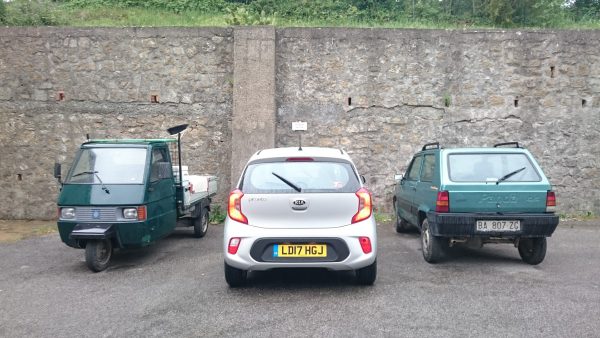
I began my drive from Grosetto Air Base, a military airport that Kia had special permission to land us at, but usually you’d fly in to either Rome or Pisa and then make a two hour long drive to get to the Tuscan region. Siena is not far away either. This is the beautiful city that features in the opening sequence of Quantum of Solace. The thought did cross my mind to nip up to Siena to put the Picanto to the test on its narrow city streets; that’s what a city car needs to cope with. But actually the more I drove the Picanto the more credit I gave to Kia because the driving route they chose showed the Picanto can also turn its hand to longer journeys. It’s fairly obvious to me that this tiny little car is going to be great in a city – and that’s why most people will buy one – but this little beauty can actually get you (and your kit) out on a weekend escape. Call it Grand Touring if you like and those GT-Line and GT-Line S versions could certainly get your around in style.
I spent the most of my first day driving a Picanto with trim level 2. This can come as a 1.0-litre with a 5-speed gearbox or you can get a 1.25-litre engine with a 4-speed gearbox. The 1.0-litre gives you 66bhp with the 1.25-litre engine adding 17bhp to make it 83bhp. It feels sprightly, nippy and fun.
There are actually nine versions of the Picanto on offer, based on two engine choices, two transmissions and five trim lines. Later this year the most powerful engine ever offered in a Picanto – a 99bhp 1.0-litre T-GDi turbocharged unit – will become available and that will be a little gem of a car for sure.
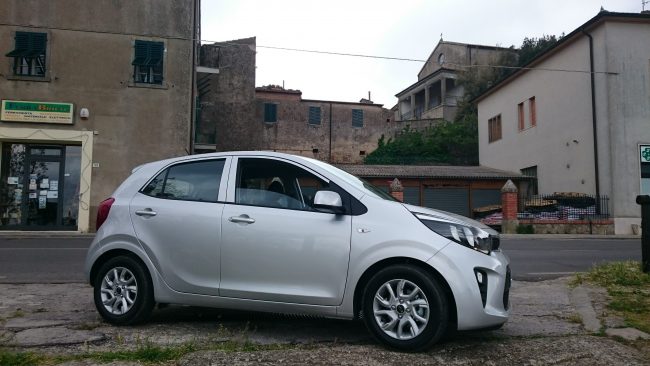
Picanto (Trim Level 2)
It’s fair to say the base level Picanto is absolutely sound. Kia’s strapline is ‘The power to surprise’ and on those winding Tuscan roads with tight switchback corners, the handling certainly did surprise me. Turns out the Picanto now has Torque Vectoring, a first for Kia in one of its city-cars. The anti-lock brake and stability control sensors detect if the car is drifting. If the front wheels of the Picanto are running wide, the system gently brakes the inside rear wheel. If the rear tyres are starting to slide outwards it puts some brake on the outer rear wheel. This torque vectoring is standard on all models.
Over five hours of driving the Picanto and I bonded as we rolled along twisting mountains roads in the rain. By the time I arrived at the hotel for the night, I felt pretty reassured that a Picanto could genuinely get you and your adventure kit to beautiful places.
ARRIVAL AT L’ANDANA HOTEL
As far as hotels go, L’Andana is as high end and luxury as you can get. Just arriving at the gateway of the cyprus tree-lined driveway is a magical moment.
If you’re the kind of person that pushes themselves day in and day out then L’Andana’s sanctuary and spa is the most ideal place to relax, recharge and sooth a tired body – and a tired mind.
I can only dream of what it must be like in hot Tuscan sunshine in a few month’s time. This is where adventurers go when they’re exhausted from roughing it on expeditions. Or at least, this is where you’d dream of taking yourself to rest and recuperate.
If you find that after a few days here laying next to and swimming in the pools you’re getting restless then the hotel has a fleet of mountain bikes outside. You don’t need to sign one out, there’s no key or form to fill in, just simply jump on one and go. I took myself up and around the vineyards early one morning and there is plenty more to see and visit, like the coast, where you can go stand up paddleboarding or explore in a kayak.
If you’re a foodie, then you won’t be disappointed as a short walk from the hotel is La Trattoria Enrico Bartolini which has a Michelin Star. For my dinner I went for black squid with pea and mint emulsion to start, followed by charcoal beef fillet with fondant potatoes, San Miniato black truffle & thyme sauce for the main. For dessert, I went for Cantuccio biscuits, vinsanto cream and almond bigne. It was an exquisite meal.
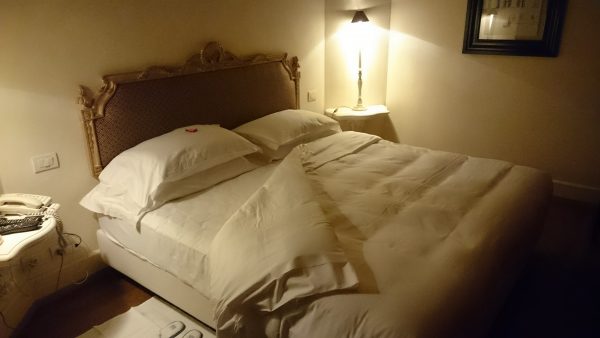
DRIVING THE GT-LINE VERSIONS
After a long sleep in a huge bed and room at L’Andana, I pulled open the curtains to see grey skies again. Today I’d be driving the GT-Line and GT-Line S versions of the Picanto. First up was the Picanto GT-Line (in white). The idea is that this is a sporty looking city car that won’t hit you hard on the insurance premium or fuel costs. Compare this to the Picanto 2 I drove the day before and the GT-Line has chunkier front and rear bumpers, additions of red body parts, 16-inch alloys and twin exhaust pipes.
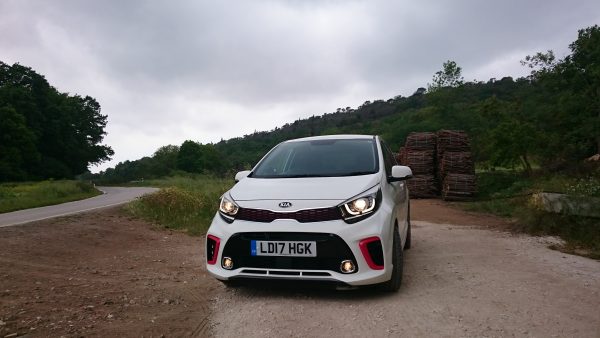
GT-Line has sporty features like the red details across the sills and bumper
Inside it’s sporty too with black and red leather, stainless steel pedals and silver chrome details. In terms of how it drives, it feels very similar to the Picanto from the day before. I drove on some pretty bumpy Italian roads and while this light car’s suspension and wheelbase mean it can get thrown around, the torque vectoring really does its job well.
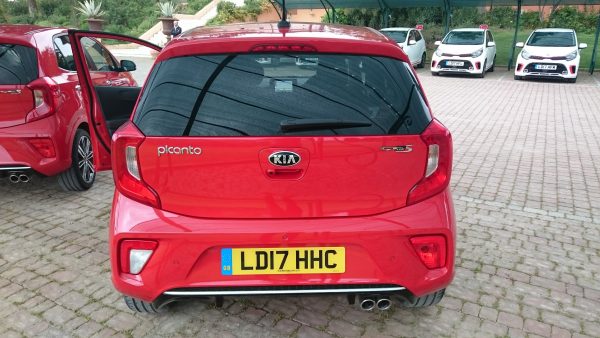
GT-Line S version
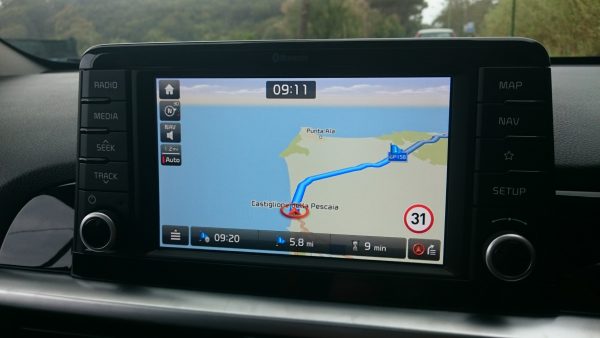
The GT Line S model is almost identical in terms of looks to the GT-Line Picanto, but it comes with a wireless phone charger, an electric sunroof, heated front seats and steering wheel, push button engine start, rear parking sensors and camera, DAB and a lovely 7-inch central display unit – perfect for navigating your way around (see above).
If you’re looking for an affordable small car, we say the Picanto is definitely worth considering – it’s a city car that can easily venture out on longer journeys and has enough room for your adventure essentials too.
AUTHOR: Dan Tye
RECOMMENDED FOR YOU
Wheels Alive
Old cars, new cars, borrowed cars & blue cars. If it steers it's here!
Kia Picanto 2023 model – Road Test
20th March 2023
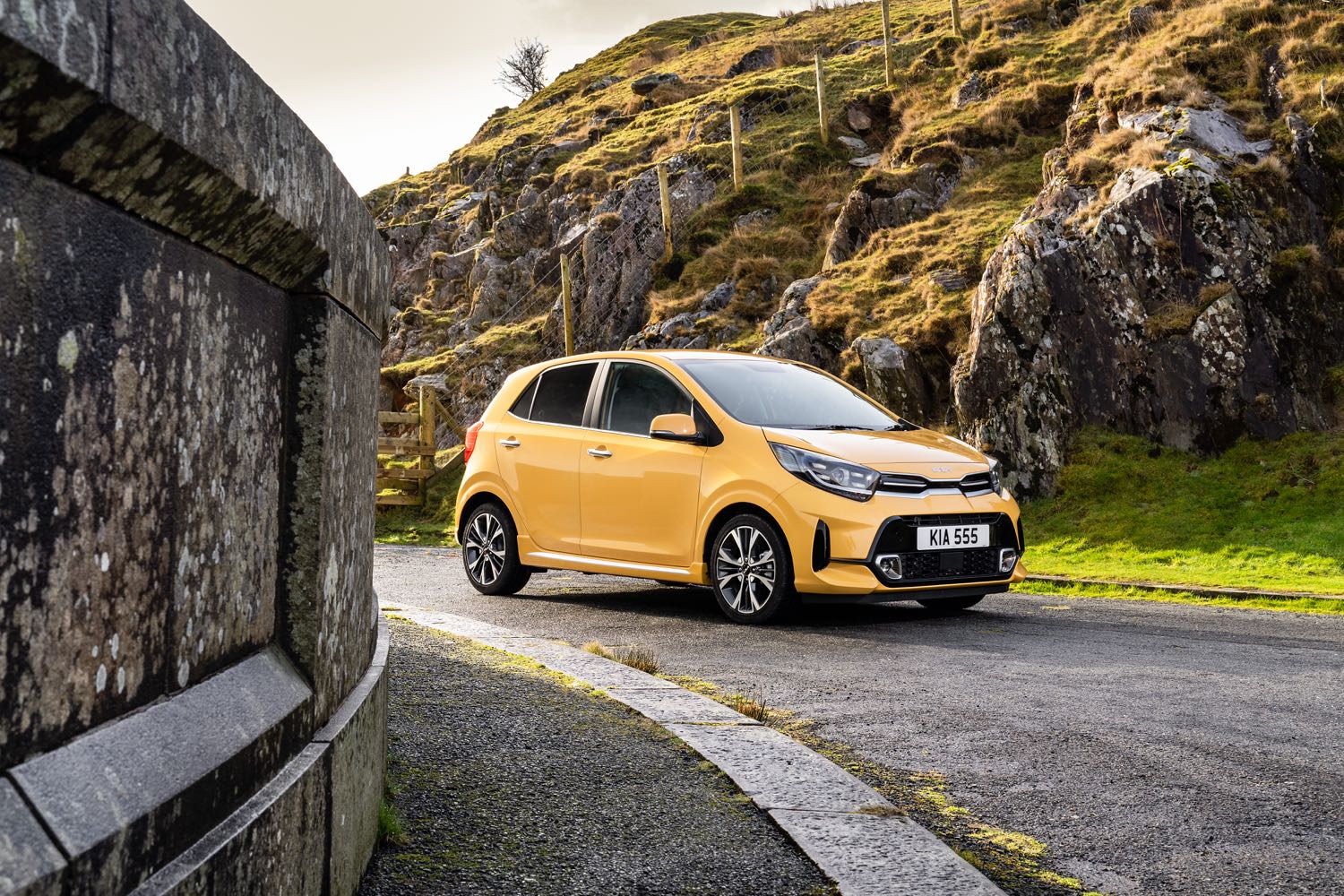
The latest KIA Picanto 1.0 small car tried for size and value by Robin Roberts (and Miles Better News Agency).
With motoring costs soaring a lot of drivers are downsizing and face the dilemma of what to buy, yet do not realise how good a modern small 5-door hatchback can be.
In fact, a recent study found the typical family car today costing around £32,700 has thousands of pounds of features, after adjusting for inflation, fitted as standard which were not there a decade ago.
We recently found ourselves facing a 400 miles trip with our Kia Picanto 1.0 triple-pot petrol engine five-speed manual test car and began with some apprehension but also excitement at the opportunity to give a decent run to a modern city car. It was a wise move as it turned out.
The Kia Picanto model-year 23 is the third generation of Kia’s baby car and spans nine models in six trim levels, with 66 or 99 bhp 1.0 litre petrol engines, five-speed manual or automated manual transmission from £13,400 to £18,025.
This slideshow requires JavaScript.
Depending on the chosen trim, the creature comforts build on a standard package in the Picanto comprising collision avoidance technology, hill start assist and dynamic stability control, sophisticated anti-skid brakes, wireless charging, heated front seats and steering wheel, eight-inch infotainment display, sat-nav, DAB radio, parking camera and sensors. Top models get KIA Connect mobile services and Android and Apple links.
The chunkier styled X-Line S models are slightly roomier and have five-seats but all models get a very comprehensive seven years or 100,000 miles warranty that is transferable to subsequent owners.
The sophisticated three-cylinder petrol engine was very free-revving and while it sounded busy when stretched over the drive, it was always smooth and most of the time settled down to a sewing-machine distant buzz. There were moments on motorways when I wished for a six-speed higher ratio instead of the five-in-hand, but I was delighted with the economy of 56 mpg most of the time before it slightly dipped to our overall 54.2 mpg on cross country sections.
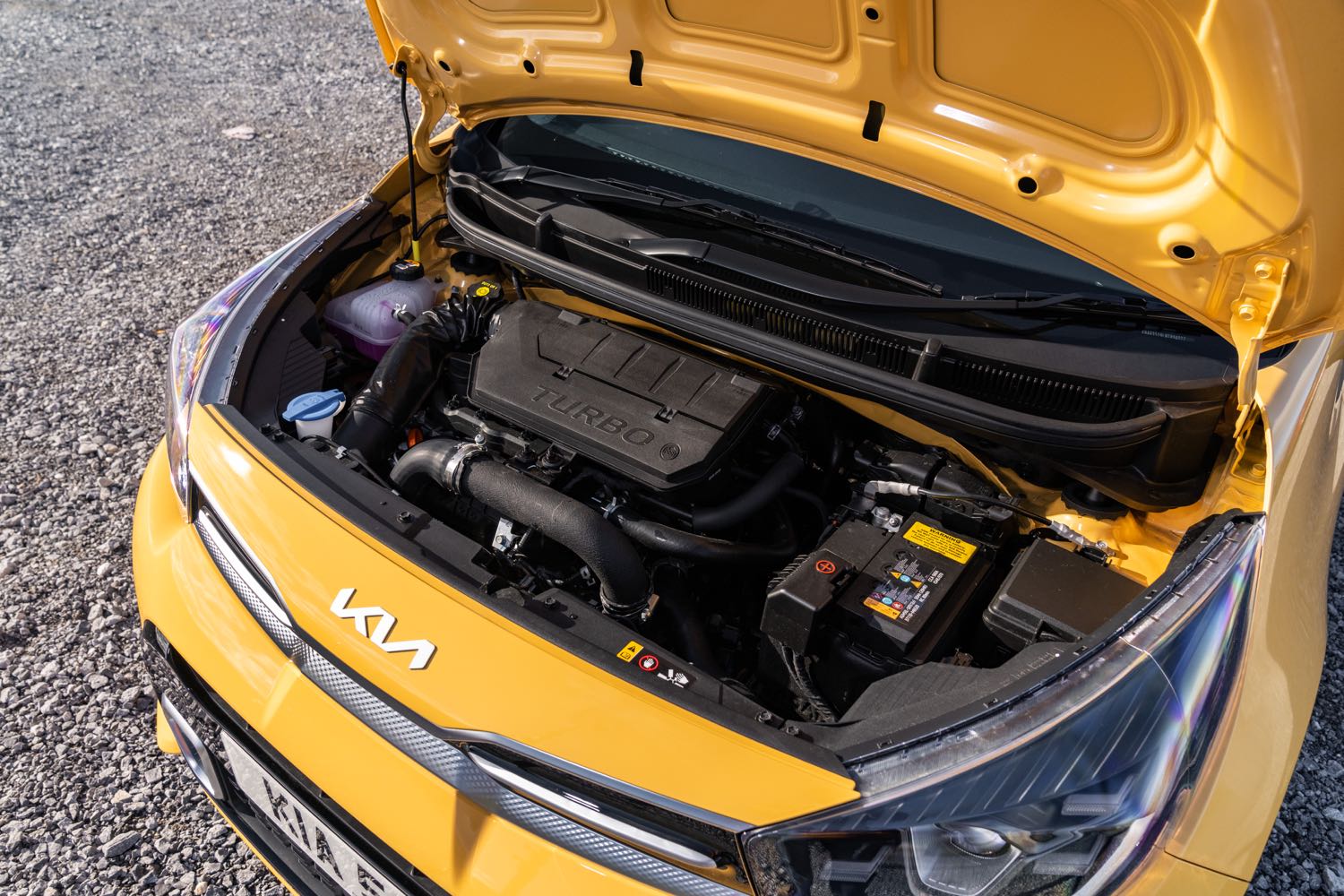
The responsive engine and quick-change direct gearbox contributed to its eager feedback while its direct electric steering and tight turning circle mean it was agile on twisting roads and easy to park in urban streets. It reminded me of some hot-hatches of the 70s and 80s, but brought up to date with modern infotainment and comfort controls.
Cold mornings and nights make you appreciate the variable heated front seats and steering wheel, rear window heater and the quick warming cabin and screen clearing air conditioning.
Infotainment is by a decent sized touch-screen display atop the dashboard and buttons on the wheel-spokes, and it’s clear and quick responding to inputs.
The driver has a good sized display for engine and road speed directly infront and a changeable rolling display between them for settings to suit what they wish to see. Everything is very clear.
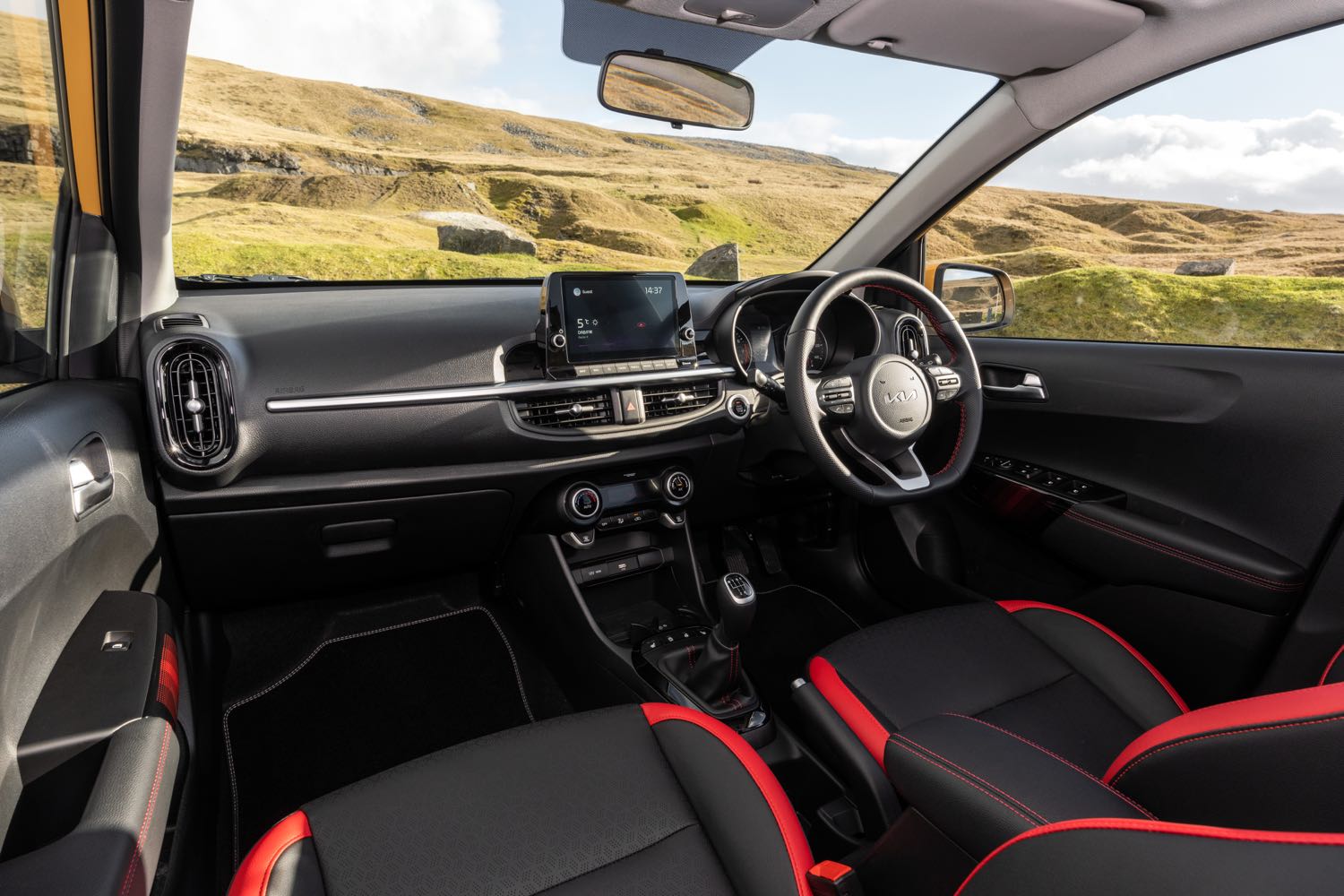
Heating and ventilation controls were simple, strong and effective backed up by four powered windows but no sunroof. Front and rear wash and wipe kept the glass clear and the lights were well up to their task in poor visibility.
Decent sized powered door mirrors, a coloured rear view camera and sensors aided parking but in reality the slim roof pillars did not present a problem when reversing or pulling out either.
Seats’ adjustment was reasonably wide and the front pair were nicely shaped to give support around the back and under thighs. Access was good to them but you had to bend over a bit to slip into the rear pair of seats (note – there are only two rear seats, not three) and legroom might be tight for some passengers.
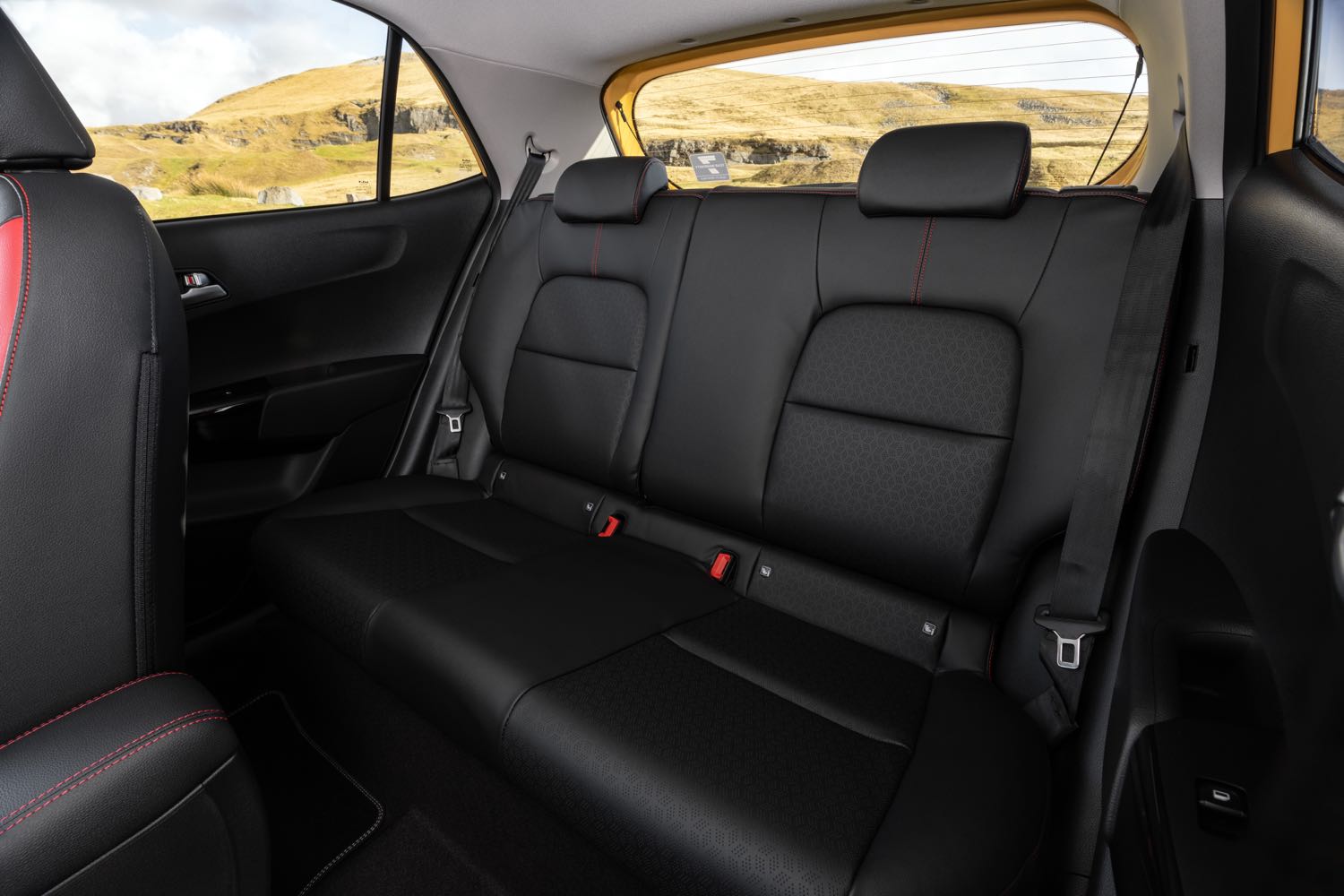
An offset split back-rest meant the luggage area could be gradually increased in capacity from taking just some bags of shopping or two medium suitcases to much bigger items under the fifth door with its sensible deep and long loadbed.
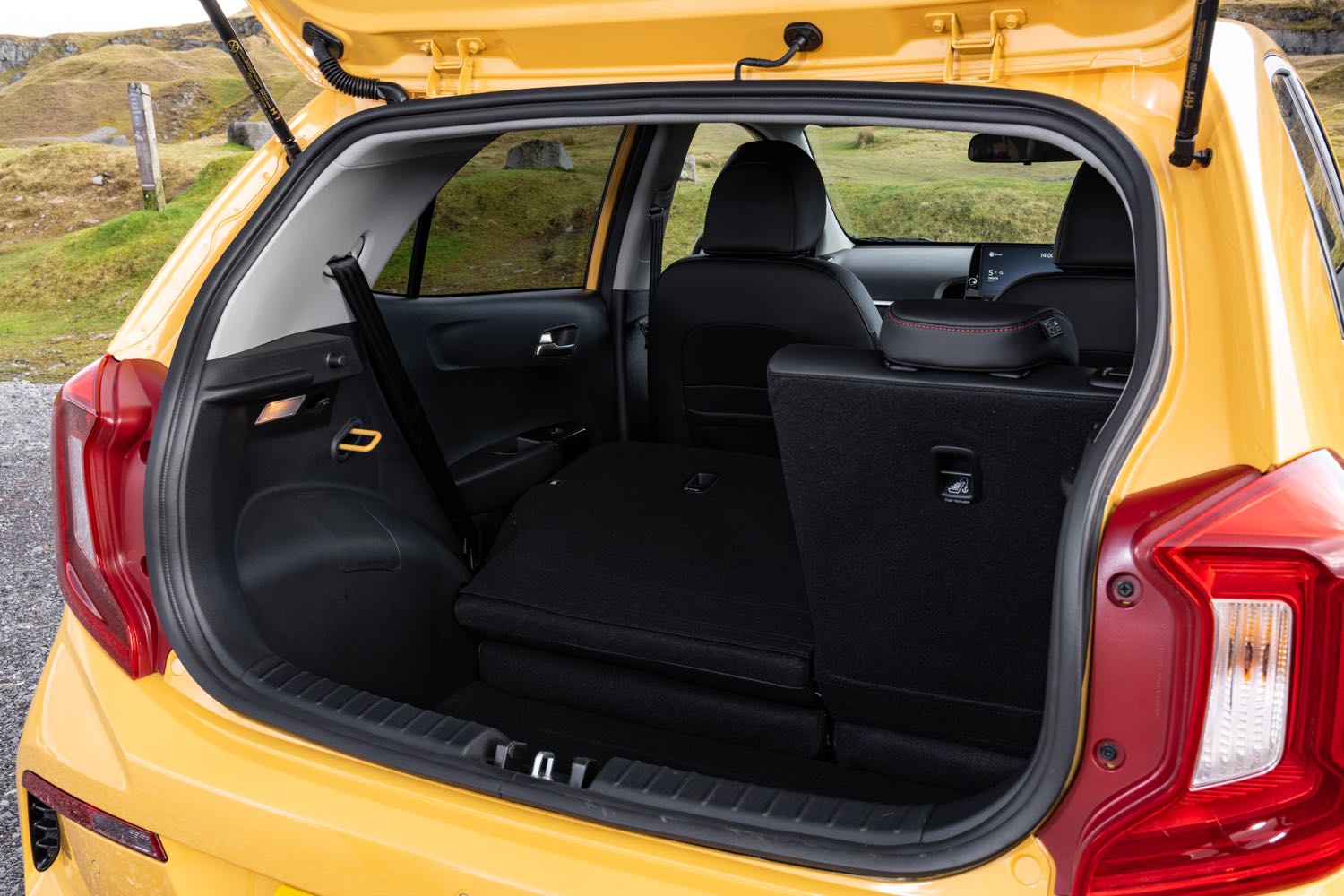
On the road it easily kept up with traffic flow and using the ratios and power underfoot it could nip around slower traffic without drama if with some excited noise.
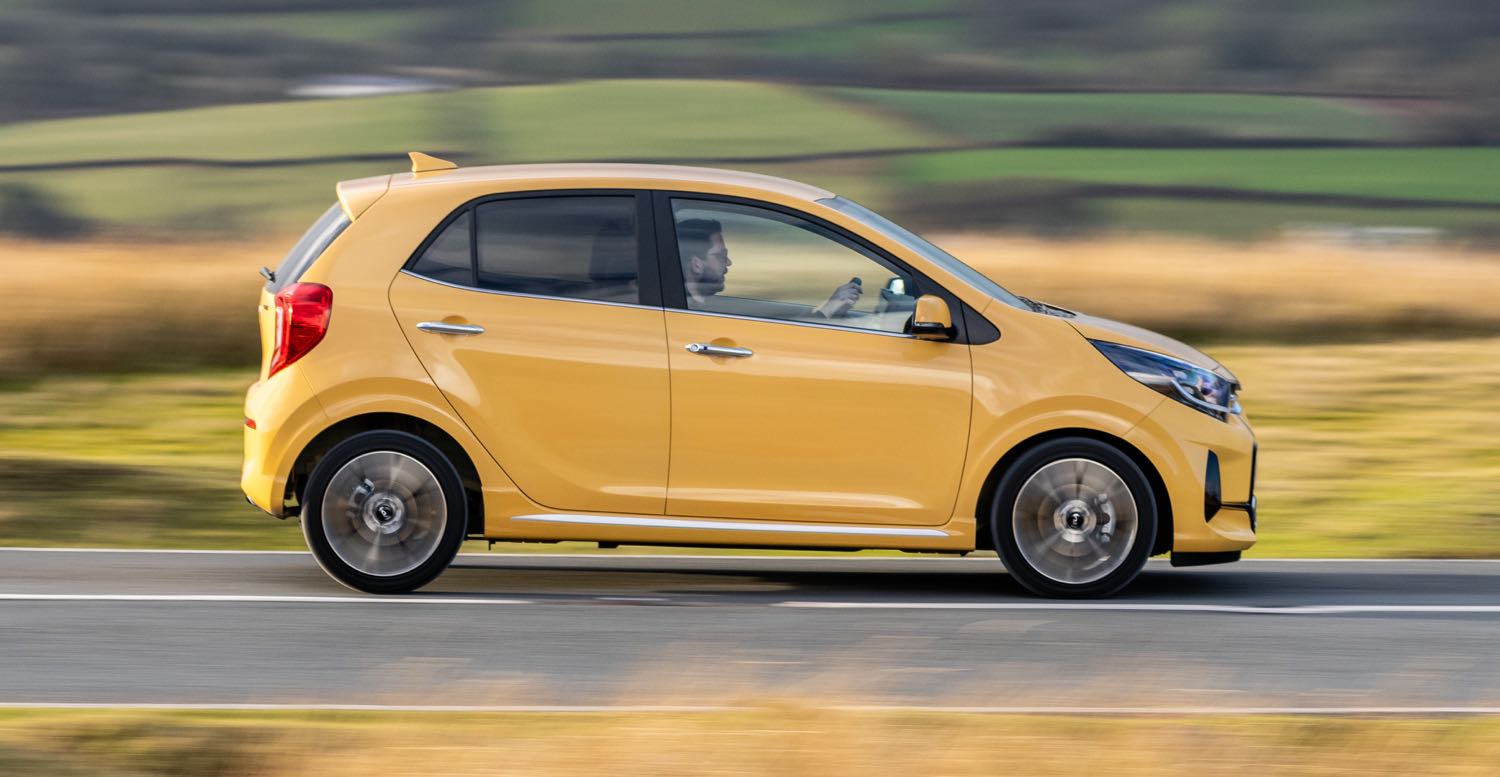
Handling was good and the feedback from steering and brakes was intuitive while the roadholding never caused a moment’s concern even when it hit some serious potholes.
The ease with which the Kia Picanto GT Line S covered ground and a variety of roads earned my respect for a modern small car and knowing it comes with that outstanding warranty is a reassurance for any driver.
It’s a wise buy in today’s not so clever world.
For: Lively, agile, well equipped, comfortable, very economical, long warranty.
Against: Small boot and oddments space, busy engine note under load, strictly four seats.
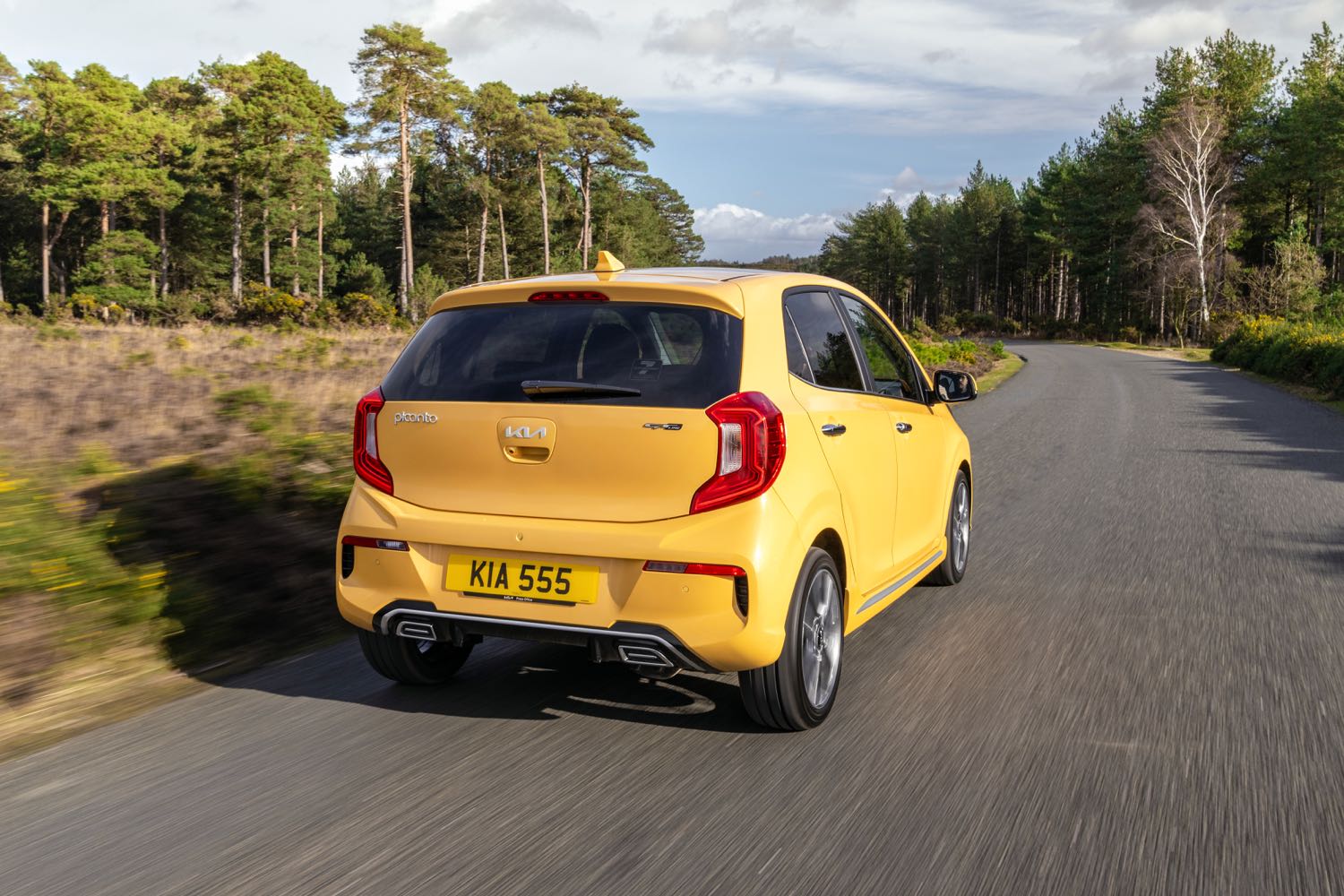
Price: £17,450
Mechanical: 998cc 3-cyl 98 bhp, turbo-petrol, 5 sp
Max Speed: 112 mph
0 – 62 mph: 9.9 sec
Combined MPG: 54.2 (our overall figure on test)
Insurance Group: 11
C02 emissions: 120 g/km
Tax costs: Bik rating 29%, VED £190FY, £165SR
Warranty: 7 years/ 100,000 miles
Size: L 3.60 m (11.81 ft), W 1.60 m (5.25 ft), H 1.49 m (4.89 ft)
Bootspace: 255 to 1010 litres (9.01 to 35.67 cu.ft)
Kerbweight: 1,030 kg (2,271 lb)
Wheels Alive Social
Like us on Facebook
Follow us on Twitter
We welcome your questions, comments and feedback. Please click here to contact us .
Advertising Opportunities
Please contact us if you would like to discuss advertising opportunities on Wheels Alive.
Please share our website
- Car group tests
Hyundai i10 vs Kia Picanto: 2022 twin test review
These city cars are at home in town or on the motorway, but which is best.
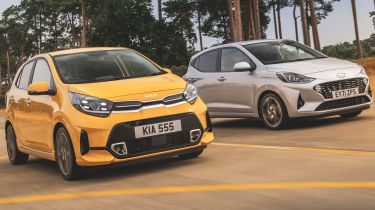
Kia and Hyundai have wowed us in recent times with show-stopping EVs and clever tech designs in traditional segments. They’re worthy distractions, but they shouldn’t take away from the fact that the brands’ cheaper, more pragmatic models are among the most underrated cars in their respective line-ups.
EVs offer zero tailpipe emissions, but there’s still very much a place for compact, efficient city cars , too. Both the Hyundai i10 and Kia Picanto deliver a very grown-up experience with a small footprint.

Many of the similarly sized offerings from Kia and Hyundai derive their mechanicals from the same place; after all, it makes sense to make the most of economies of scale and share parts within the group where possible. And nowhere is that more important than in a segment which constantly faces a squeeze, because profits are hard to achieve with lower asking prices.
Kia’s Picanto was the first of this pair to launch in their current incarnations. Sales began in 2017, with the funky-looking competitor taking on the Volkswagen up! and Toyota Aygo . A subtle facelift in 2020 saw tweaks to the lights, grille and bumpers, while inside the infotainment screen increased in size from seven to eight inches.
The first thing that strikes you about our Picanto is just how much standard equipment you get. As standard, this top-spec GT Line S model has climate control, a touchscreen infotainment system, heated front seats and steering wheel, plus leather upholstery. Not too long ago an equipment list like that would be associated with a luxury saloon.
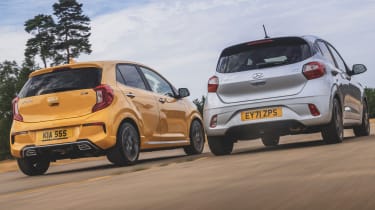
Then there’s the safety tech, which reads like that of a modern executive car. Forward collision avoidance assist, blind-spot collision avoidance assist, lane-keeping assist , and a driver-attention warning system all feature. There’s even lane-following assist, which can assume control of the vehicle’s steering, braking and throttle on the motorway.
These features are also offered on the Hyundai, a car that appears slightly more mature than the Kia. Its dash looks a little more modern, and its five-door body is spacious inside. There’s little to split the two for storage; the i10’s boot capacity is 252 litres to the Picanto’s 255 litres.
The pair continue to impress once you get behind the wheel. Both models have the joyful character that make city cars great. They’re tiny, agile and joyfully easy to whip into tight parking spaces or through small gaps.
Yet it’s the level of maturity that really stands out here. Both the Hyundai and Kia are fairly refined at a cruise, and neither would leave you even thinking twice about covering some long motorway miles. However, the i10 has the edge on the open road, offering just a little more ride comfort and a touch more refinement than the Picanto.
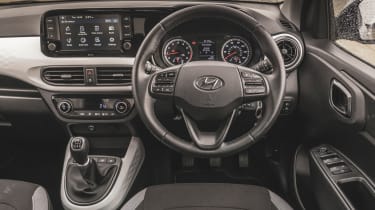
Despite the cars’ mechanical similarities, it’s the engines which provide the key difference, though. The Kia is offered with 1.0-litre three-cylinder units only, both with a turbo for a lively 99bhp output, or without for 66bhp.
The i10 comes with both of those motors, but also a 83bhp 1.2-litre four cylinder. Of those options, it’s the one we’d have, because it’s more refined and a little more easy to drive smoothly than the more powerful turbocharged triple. The 1.2-litre unit does have less torque than the turbo engine, though, so if you will be regularly making use of those back seats with extra passengers, then the turbocharged model will still be worth a look.
Place a £2,000 deposit on a three-year PCP agreement for our pick of the Hyundai range, the i10 1.2 Premium, and the monthly payments come to £255. The Picanto ‘3’ comes to £237 per month on matching terms, but it comes with the less powerful 1.0-litre triple-cylinder engine. For the extra power and refinement you’re getting, we’d stretch to the Hyundai if your finances allow it.
First place: Hyundai i10
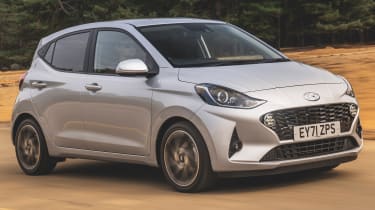
The third-generation i10 hit the ground running in the city-car segment. There really is very little to find fault with; it’s great to drive in town, yet has the maturity to be just at home on a long trip. The engine line-up is more varied than the Picanto’s, and there’s very little to separate the two when it comes to space, equipment levels or finances.
Second place: Kia Picanto

It takes second here, but the Picanto’s sense of fun still shines through. It’s great to drive, is packed with standard kit and has plenty of space inside. The engine range has a key gap between the underpowered entry-level models and the range-topping GT-Line S, though, and this is one of the key reasons the Kia can’t quite win this round.
Now read our twin test of the Hyundai Ioniq 5 and Kia EV6 ...
Most Popular
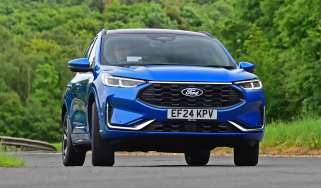
New Ford Kuga facelift 2024 review: sensible SUV gets a bold new face
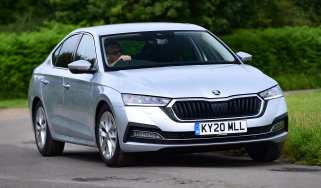
Car Deal of the Day: brilliant Skoda Octavia for just £168 per month, for now…
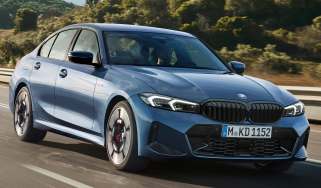
New BMW 3 Series drops diesel as part of 2024 facelift
Best Resorts Near Galereya Kino, Elektrostal, Russia
Resorts near galereya kino, property types, distance from, traveller rating, hotel class.
- Best Value Properties ranked using exclusive Tripadvisor data, including traveller ratings, confirmed availability from our partners, prices, booking popularity and location, as well as personal user preferences and recently viewed hotels.
- Traveller Ranked Highest rated hotels on Tripadvisor, based on traveller reviews.
- Distance from Galereya Kino See properties located closest to the place of interest first with confirmed availability for your dates from our partners.

IMAGES
VIDEO
COMMENTS
Find out more info about Kia Picanto III ( 2017 - now ) : https://www.youtube.com/channel/UCZvHdPZzOdONixt5mRRolngWould You like to know how to Reset Trip B ...
Conclusion. Trip A and B on an odometer refer to the odometer's two trip meters. The "A" trip meter measures the distance traveled since it was the last reset, whereas the "B" trip meter has the same purpose, but can be reset independently of Trip A. This means you can use either trip meter to track your mileage for a specific purpose ...
Trip A/B. Tripmeter. The tripmeter is the total driving distance since the last tripmeter reset. - Distance range : 0 ~ 9999.9 km (mi) To reset the tripmeter, press the RESET button or OK button on the steering wheel for more than 1 second when the tripmeter is displayed. Elapsed Time.
Find out more info about Kia Picanto III ( 2017 - now ) : https://www.youtube.com/channel/UCZvHdPZzOdONixt5mRRolngWould You like to know how to Find and Rese...
View and Download Kia Picanto 2016 owner's manual online. Picanto 2016 automobile pdf manual download. Sign In Upload. Download Table of Contents Contents. Add to my manuals ... Page 125 Features of your vehicle Type A Type A TRIP A TRIP B Distance to empty* OTA045402 Type B Average fuel consumption* OTA045541 Type B Instant fuel consumption ...
A detailed review of the 3rd Generation Kia Picanto 1.0 litre Automatic (JA) including a comprehensive overview of the interior and storage space. I drove it...
But that 9.9secs 0-60mph time is in a different league and the Picanto benefits greatly from the extra power. You might even consider the odd overtake on a particularly long stretch of motorway.
The new Kia Picanto is only available with five doors, like the Kia Rio, with the rear door handles being the same as the front ones, rather than integrated like the Nissan Micra 2017, for example ...
What we don't. If you missed our first instalment of the 2022 Kia Picanto GT long-term review, check out the Introduction and our second update here! A buzzy little three-cylinder engine, coming ...
Despite its spicy sounding name, the Kia Picanto started life in 2003 as a fairly bland looking (albeit cheaply-priced and decently-equipped) city car.The second version in 2011 took full ...
The Kia Picanto really is a terrific city car. I found myself making extra trips to the shops just to zip around Dundee in it. It was absolutely fine for jaunts to Glenrothes and Arbroath. It took ...
For new vehicles sold from May 2021, Kia offers, per vehicle, two free-of-charge updates of the maps in the vehicle's navigation system and of the Head Unit software using the ... Standard: Bluetooth® - Trip Computer - USB Port (Type A) ... Your Picanto comes with a 12 year/ unlimited mileage anti-perforation warranty. A bodywork inspection ...
The upgraded Picanto offers Kia's industry-leading 7-Year, 150,000-kilometre warranty as standard. Exterior design. Refreshed design with a distinct new look for GT-Line and X-Line models. The Picanto line-up has received a comprehensive enhancement to exterior design, with significant updates made to sporty GT-Line and SUV-inspired X-Line ...
Kia Rio. The 1.0 T-GDi GT-Line Eco is the warm hatch equivalent of the Picanto T-GDi GT-Line S we've been running. The super mini comes fitted with the same engine as our Picanto, although in a slightly different state of tune. Peak power delivers 118hp at 6,000 revs where our Picanto musters 99hp at 4,500 revs.
Later this year the most powerful engine ever offered in a Picanto - a 99bhp 1.0-litre T-GDi turbocharged unit - will become available and that will be a little gem of a car for sure. Picanto (Trim Level 2) It's fair to say the base level Picanto is absolutely sound. Kia's strapline is 'The power to surprise' and on those winding ...
Introduction. In third generation form launched in 2017, Kia's Picanto became a little city car with much bigger ideas. A glance at the styling and the mainstream engine line-up might not suggest that much dramatic change took place with this JA-series design but don't be deceived. A fundamental re-design transformed the kind of car this could be.
We recently found ourselves facing a 400 miles trip with our Kia Picanto 1.0 triple-pot petrol engine five-speed manual test car and began with some apprehension but also excitement at the opportunity to give a decent run to a modern city car. ... The Kia Picanto model-year 23 is the third generation of Kia's baby car and spans nine models in ...
Its dash looks a little more modern, and its five-door body is spacious inside. There's little to split the two for storage; the i10's boot capacity is 252 litres to the Picanto's 255 litres ...
1,403 (15"Tire) Picanto Overhang (front) 675. Picanto Overhang (rear) 520. Picanto Leg room (front) 1,085. Picanto Leg room (rear) 820.
Likino-Dulyovo Tourism: Tripadvisor has 61 reviews of Likino-Dulyovo Hotels, Attractions, and Restaurants making it your best Likino-Dulyovo resource.
Hotels near Viki Cinema, Elektrostal on Tripadvisor: Find 1,352 traveler reviews, 1,936 candid photos, and prices for 61 hotels near Viki Cinema in Elektrostal, Russia.
A mix of the charming, modern, and tried and true. See all. Apelsin Hotel. 43. from $48/night. Apart Hotel Yantar. 2. from $28/night. Elektrostal Hotel.
Resorts near Galereya Kino, Elektrostal on Tripadvisor: Find 1,402 traveller reviews, 2,048 candid photos, and prices for resorts near Galereya Kino in Elektrostal, Russia.